Dissertation Chapter 3, 4 and 5: Methodology, Data Analysis and Discussion, Conclusions and Implications
VerifiedAdded on 2022/10/02
|52
|14935
|273
AI Summary
This dissertation focuses on Chapter 3, 4 and 5 which includes Methodology, Data Analysis and Discussion, and Conclusions and Implications. It covers research procedures, research philosophy, research approach, research design, research strategy, sampling technique, data collection procedure, and research instrument.
Contribute Materials
Your contribution can guide someone’s learning journey. Share your
documents today.
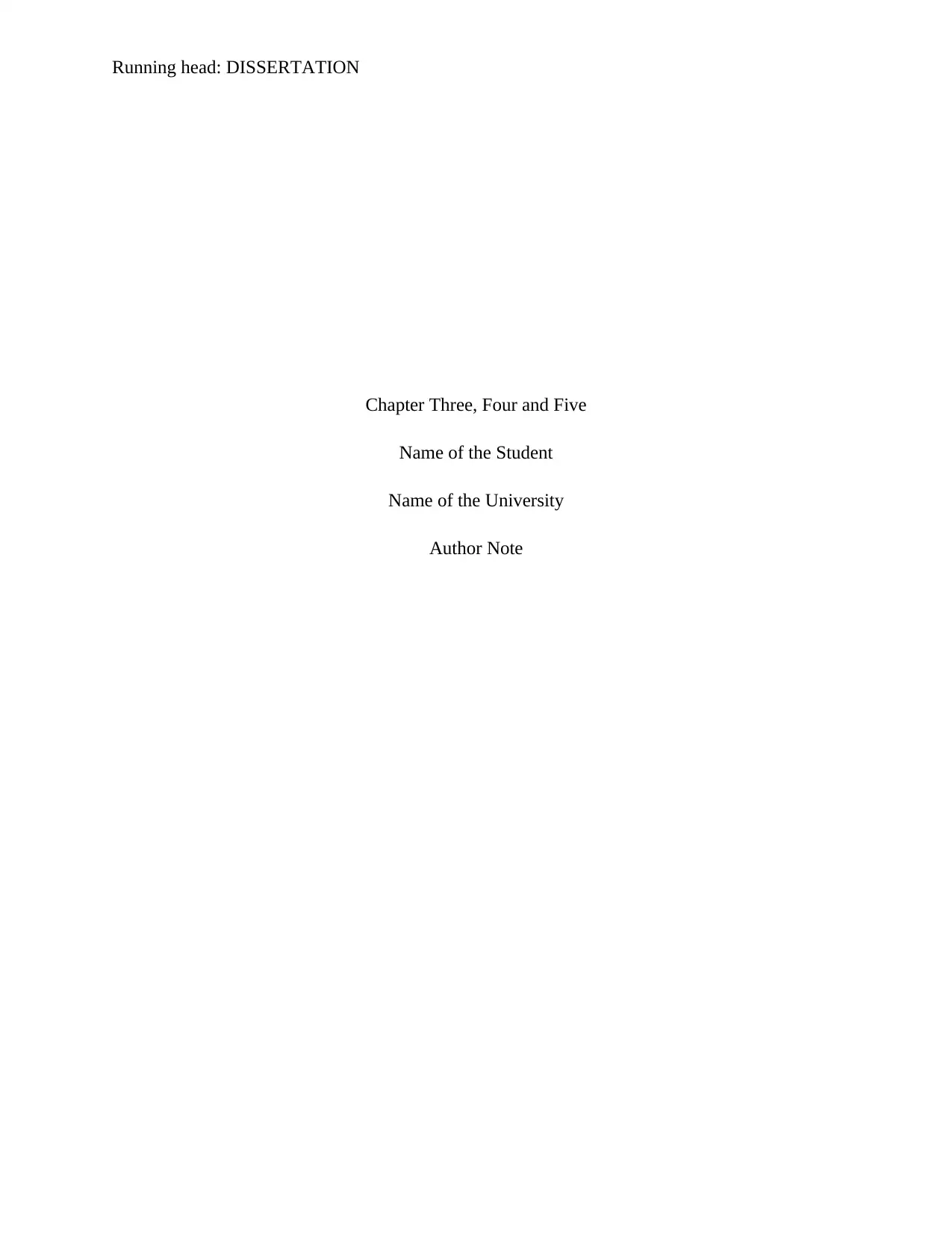
Running head: DISSERTATION
Chapter Three, Four and Five
Name of the Student
Name of the University
Author Note
Chapter Three, Four and Five
Name of the Student
Name of the University
Author Note
Secure Best Marks with AI Grader
Need help grading? Try our AI Grader for instant feedback on your assignments.

1DISSERTATION
Table of Contents
Chapter 3: Methodology..................................................................................................................3
3.1 Introduction............................................................................................................................3
3.2 Justification for the paradigm and methodology....................................................................3
3.3 Research procedures..............................................................................................................3
Research Philosophy....................................................................................................................3
Research Approach......................................................................................................................4
Research Design...........................................................................................................................5
Research strategy.........................................................................................................................6
Sampling technique......................................................................................................................7
Data collection procedure............................................................................................................7
Research instrument.....................................................................................................................8
Data analysis procedure...............................................................................................................9
Research Budget........................................................................................................................10
3.4 Ethical considerations..........................................................................................................11
3.5 Conclusion...........................................................................................................................11
Chapter 4: Data analysis and Discussion.......................................................................................12
4.1 Overview..............................................................................................................................12
4.2 Descriptive Statistics............................................................................................................12
4.3 Inferential Statistics..............................................................................................................22
Correlation.................................................................................................................................23
Regression Analysis...................................................................................................................29
4.5 Hypothesis............................................................................................................................31
4.6 Findings................................................................................................................................31
4.7 Discussion............................................................................................................................32
4.8 Summary..............................................................................................................................33
5. Conclusions and implications....................................................................................................34
5.1 Introduction..........................................................................................................................34
5.2 Conclusions about each research issue or proposition.........................................................35
5.3 Conclusions about the research problem.............................................................................37
5.4 Implications for theory.........................................................................................................38
Table of Contents
Chapter 3: Methodology..................................................................................................................3
3.1 Introduction............................................................................................................................3
3.2 Justification for the paradigm and methodology....................................................................3
3.3 Research procedures..............................................................................................................3
Research Philosophy....................................................................................................................3
Research Approach......................................................................................................................4
Research Design...........................................................................................................................5
Research strategy.........................................................................................................................6
Sampling technique......................................................................................................................7
Data collection procedure............................................................................................................7
Research instrument.....................................................................................................................8
Data analysis procedure...............................................................................................................9
Research Budget........................................................................................................................10
3.4 Ethical considerations..........................................................................................................11
3.5 Conclusion...........................................................................................................................11
Chapter 4: Data analysis and Discussion.......................................................................................12
4.1 Overview..............................................................................................................................12
4.2 Descriptive Statistics............................................................................................................12
4.3 Inferential Statistics..............................................................................................................22
Correlation.................................................................................................................................23
Regression Analysis...................................................................................................................29
4.5 Hypothesis............................................................................................................................31
4.6 Findings................................................................................................................................31
4.7 Discussion............................................................................................................................32
4.8 Summary..............................................................................................................................33
5. Conclusions and implications....................................................................................................34
5.1 Introduction..........................................................................................................................34
5.2 Conclusions about each research issue or proposition.........................................................35
5.3 Conclusions about the research problem.............................................................................37
5.4 Implications for theory.........................................................................................................38
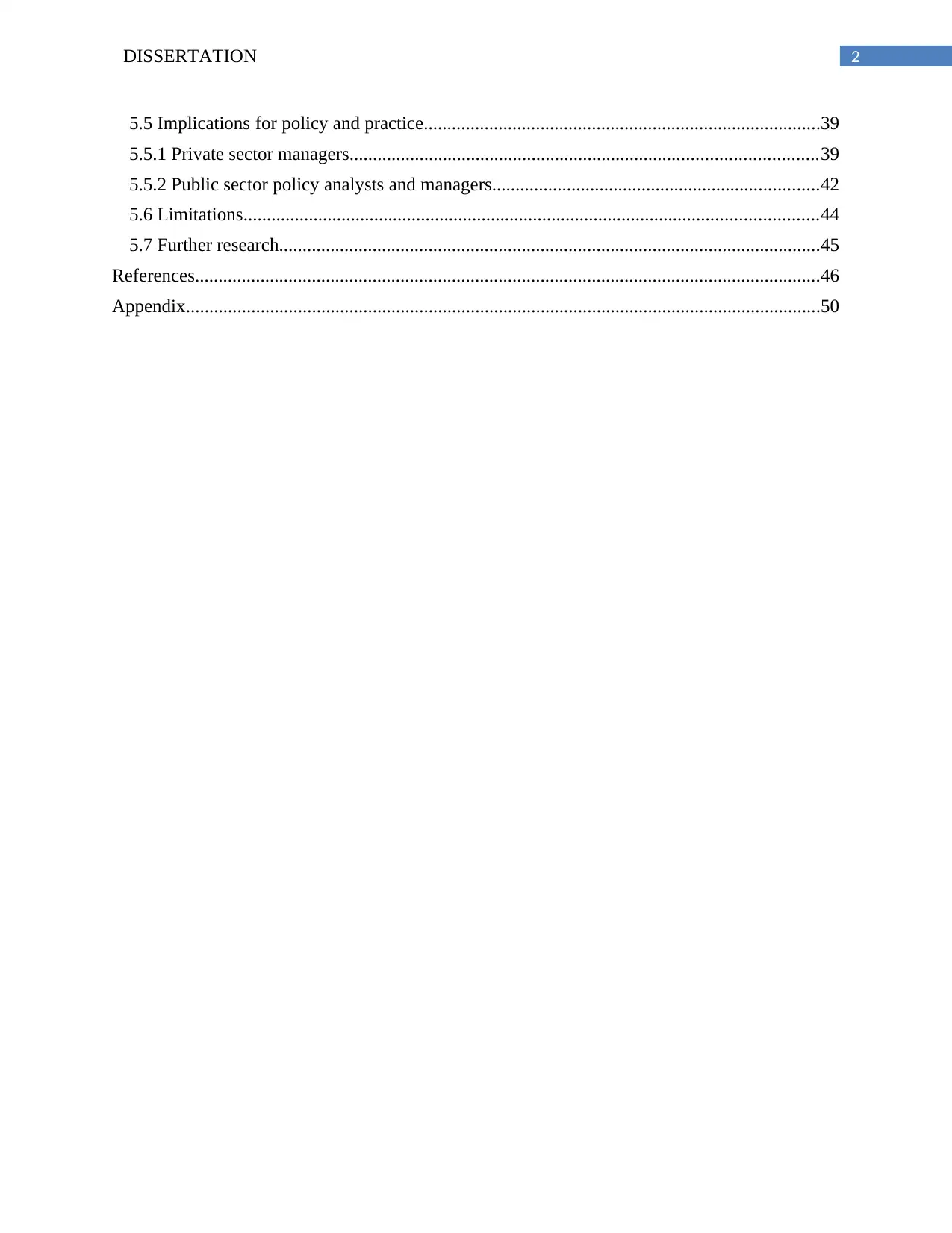
2DISSERTATION
5.5 Implications for policy and practice.....................................................................................39
5.5.1 Private sector managers....................................................................................................39
5.5.2 Public sector policy analysts and managers......................................................................42
5.6 Limitations...........................................................................................................................44
5.7 Further research....................................................................................................................45
References......................................................................................................................................46
Appendix........................................................................................................................................50
5.5 Implications for policy and practice.....................................................................................39
5.5.1 Private sector managers....................................................................................................39
5.5.2 Public sector policy analysts and managers......................................................................42
5.6 Limitations...........................................................................................................................44
5.7 Further research....................................................................................................................45
References......................................................................................................................................46
Appendix........................................................................................................................................50
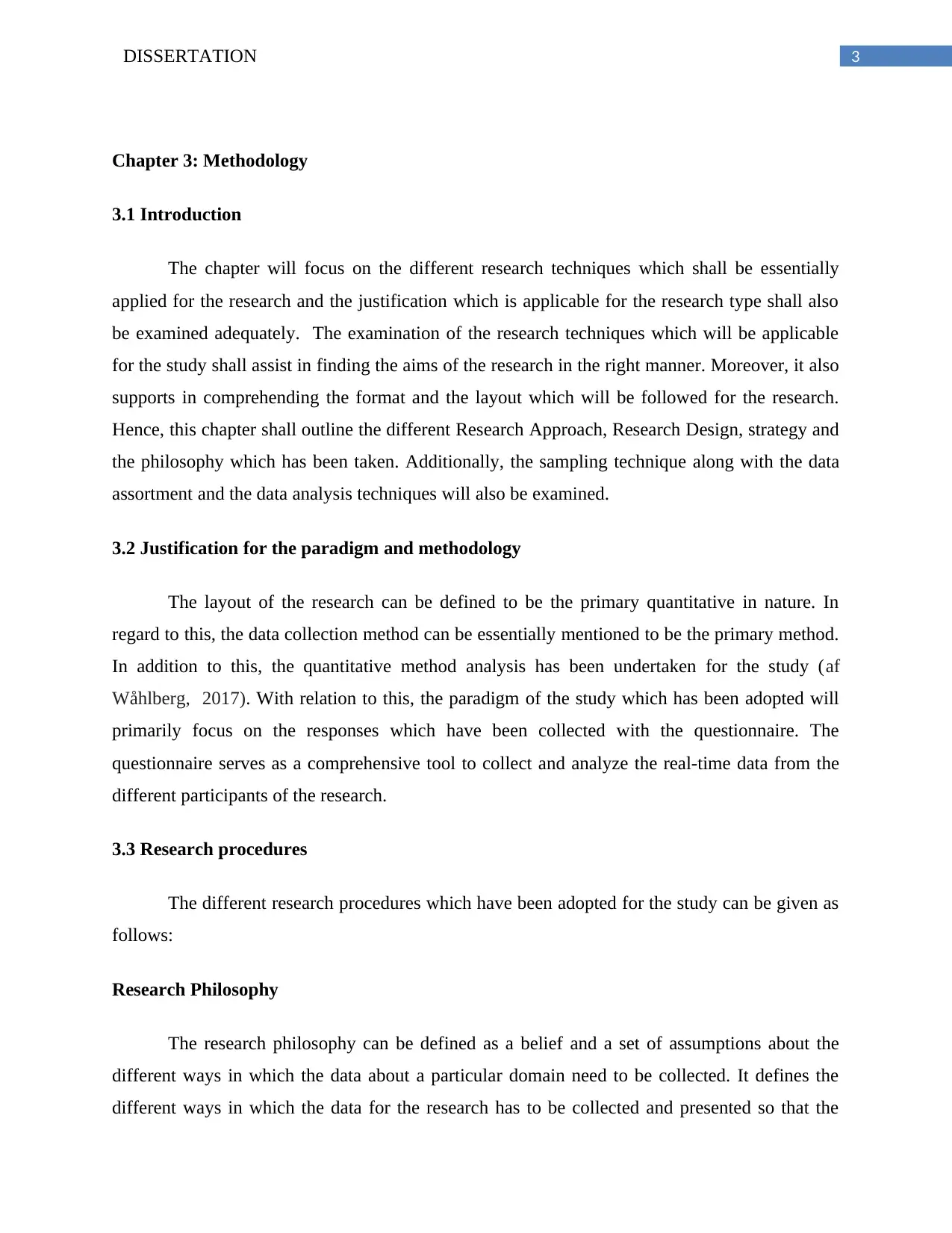
3DISSERTATION
Chapter 3: Methodology
3.1 Introduction
The chapter will focus on the different research techniques which shall be essentially
applied for the research and the justification which is applicable for the research type shall also
be examined adequately. The examination of the research techniques which will be applicable
for the study shall assist in finding the aims of the research in the right manner. Moreover, it also
supports in comprehending the format and the layout which will be followed for the research.
Hence, this chapter shall outline the different Research Approach, Research Design, strategy and
the philosophy which has been taken. Additionally, the sampling technique along with the data
assortment and the data analysis techniques will also be examined.
3.2 Justification for the paradigm and methodology
The layout of the research can be defined to be the primary quantitative in nature. In
regard to this, the data collection method can be essentially mentioned to be the primary method.
In addition to this, the quantitative method analysis has been undertaken for the study (af
Wåhlberg, 2017). With relation to this, the paradigm of the study which has been adopted will
primarily focus on the responses which have been collected with the questionnaire. The
questionnaire serves as a comprehensive tool to collect and analyze the real-time data from the
different participants of the research.
3.3 Research procedures
The different research procedures which have been adopted for the study can be given as
follows:
Research Philosophy
The research philosophy can be defined as a belief and a set of assumptions about the
different ways in which the data about a particular domain need to be collected. It defines the
different ways in which the data for the research has to be collected and presented so that the
Chapter 3: Methodology
3.1 Introduction
The chapter will focus on the different research techniques which shall be essentially
applied for the research and the justification which is applicable for the research type shall also
be examined adequately. The examination of the research techniques which will be applicable
for the study shall assist in finding the aims of the research in the right manner. Moreover, it also
supports in comprehending the format and the layout which will be followed for the research.
Hence, this chapter shall outline the different Research Approach, Research Design, strategy and
the philosophy which has been taken. Additionally, the sampling technique along with the data
assortment and the data analysis techniques will also be examined.
3.2 Justification for the paradigm and methodology
The layout of the research can be defined to be the primary quantitative in nature. In
regard to this, the data collection method can be essentially mentioned to be the primary method.
In addition to this, the quantitative method analysis has been undertaken for the study (af
Wåhlberg, 2017). With relation to this, the paradigm of the study which has been adopted will
primarily focus on the responses which have been collected with the questionnaire. The
questionnaire serves as a comprehensive tool to collect and analyze the real-time data from the
different participants of the research.
3.3 Research procedures
The different research procedures which have been adopted for the study can be given as
follows:
Research Philosophy
The research philosophy can be defined as a belief and a set of assumptions about the
different ways in which the data about a particular domain need to be collected. It defines the
different ways in which the data for the research has to be collected and presented so that the
Secure Best Marks with AI Grader
Need help grading? Try our AI Grader for instant feedback on your assignments.

4DISSERTATION
objective of the study can be attained (Alavi et al., 2018). The aim of science is generally
believed to have the capability to transform the things to the domains of the known. Hence, in
relation to this, the two most commonly used research philosophies can be taken to be the
positivist research philosophy and the interpretivist research philosophy. Therefore, for this
study, the research philosophy which shall be essentially adopted for the research can be stated to
be the positivist research philosophy.
The positivist research philosophy is based on the logic that, the reality is largely stable
and can be described from the point of view of an objective. This does not interfere with the
phenomenon which is being referred to. The researchers who generally tend to make use of the
positivist research philosophy tend to mention that, it needs to be made use of in order to make
the phenomenon isolated and make the observations relatable (Alvesson & Sköldberg, 2017).
This therefore involves the manipulation of the reality with variations in the single independent
variable so as to be able to identify the regularities which exist and form a strong relationship
between the various constituent elements present in the social world. Additionally, it is believed
that all the empirical studies which generally take place are positivist in nature and additionally,
this research philosophy would be useful in explaining the effect of one variable on the second
variable.
As the aim of the research lies to comprehend the market structure for the lead
generation, comprehend the barriers to the lead generation and to examine the various
recommendations which can be provided for optimizing the marketing efforts, the positivist
research philosophy would be additionally helpful.
Research Approach
The research approach is the process or the plan which comprises of a broad set of
assumptions which generally tends to lay down the manner in which data is to be composed for
the research, has to be analyzed and has to be interpreted accordingly (Azhdarzadeh et al., 2015).
Hence, it is based on this that the research problem is generally addressed in the research and the
objectives of the study are undertaken. With reverence to this, the research approach can be
mentioned to be decided and divided according to the given methods:
objective of the study can be attained (Alavi et al., 2018). The aim of science is generally
believed to have the capability to transform the things to the domains of the known. Hence, in
relation to this, the two most commonly used research philosophies can be taken to be the
positivist research philosophy and the interpretivist research philosophy. Therefore, for this
study, the research philosophy which shall be essentially adopted for the research can be stated to
be the positivist research philosophy.
The positivist research philosophy is based on the logic that, the reality is largely stable
and can be described from the point of view of an objective. This does not interfere with the
phenomenon which is being referred to. The researchers who generally tend to make use of the
positivist research philosophy tend to mention that, it needs to be made use of in order to make
the phenomenon isolated and make the observations relatable (Alvesson & Sköldberg, 2017).
This therefore involves the manipulation of the reality with variations in the single independent
variable so as to be able to identify the regularities which exist and form a strong relationship
between the various constituent elements present in the social world. Additionally, it is believed
that all the empirical studies which generally take place are positivist in nature and additionally,
this research philosophy would be useful in explaining the effect of one variable on the second
variable.
As the aim of the research lies to comprehend the market structure for the lead
generation, comprehend the barriers to the lead generation and to examine the various
recommendations which can be provided for optimizing the marketing efforts, the positivist
research philosophy would be additionally helpful.
Research Approach
The research approach is the process or the plan which comprises of a broad set of
assumptions which generally tends to lay down the manner in which data is to be composed for
the research, has to be analyzed and has to be interpreted accordingly (Azhdarzadeh et al., 2015).
Hence, it is based on this that the research problem is generally addressed in the research and the
objectives of the study are undertaken. With reverence to this, the research approach can be
mentioned to be decided and divided according to the given methods:
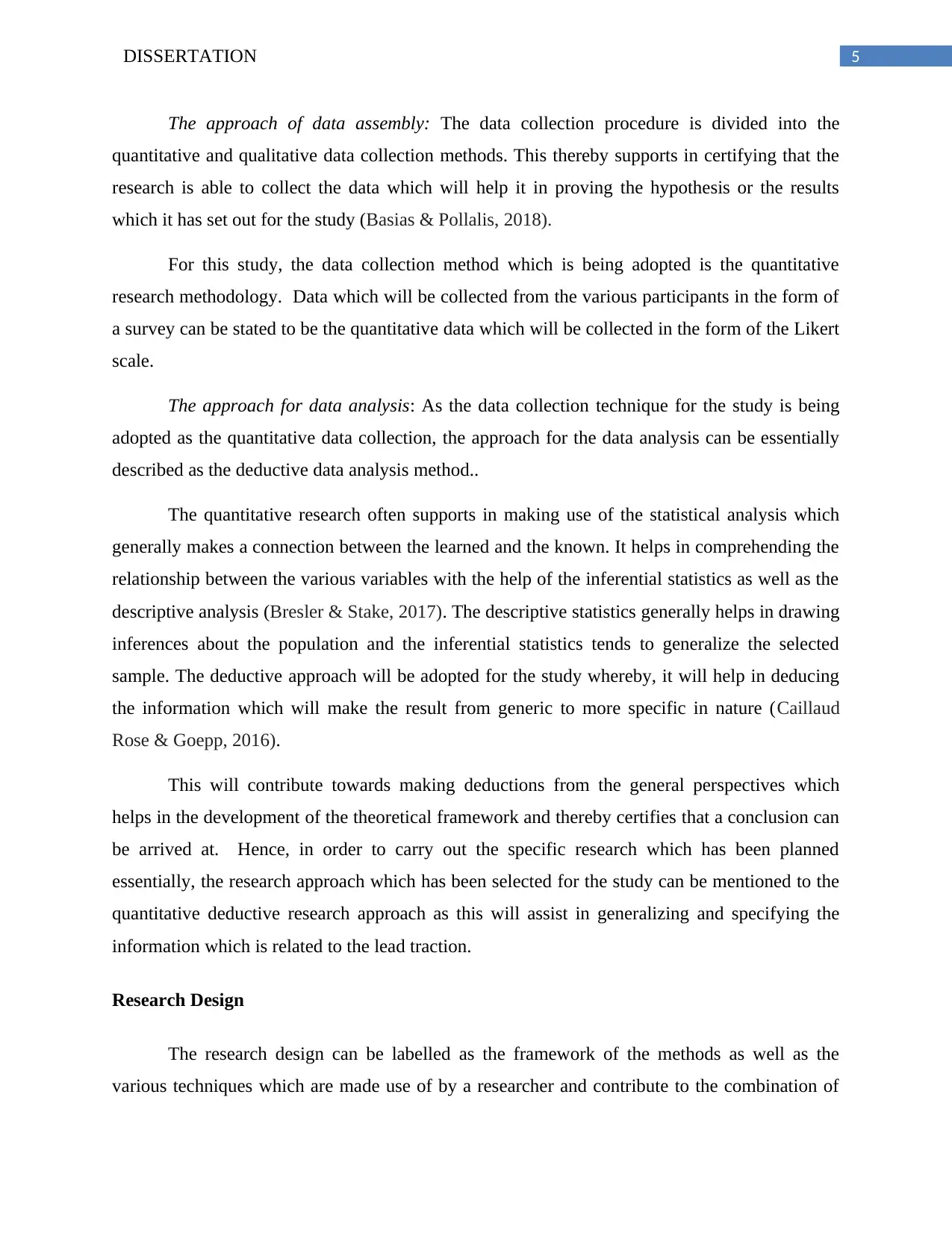
5DISSERTATION
The approach of data assembly: The data collection procedure is divided into the
quantitative and qualitative data collection methods. This thereby supports in certifying that the
research is able to collect the data which will help it in proving the hypothesis or the results
which it has set out for the study (Basias & Pollalis, 2018).
For this study, the data collection method which is being adopted is the quantitative
research methodology. Data which will be collected from the various participants in the form of
a survey can be stated to be the quantitative data which will be collected in the form of the Likert
scale.
The approach for data analysis: As the data collection technique for the study is being
adopted as the quantitative data collection, the approach for the data analysis can be essentially
described as the deductive data analysis method..
The quantitative research often supports in making use of the statistical analysis which
generally makes a connection between the learned and the known. It helps in comprehending the
relationship between the various variables with the help of the inferential statistics as well as the
descriptive analysis (Bresler & Stake, 2017). The descriptive statistics generally helps in drawing
inferences about the population and the inferential statistics tends to generalize the selected
sample. The deductive approach will be adopted for the study whereby, it will help in deducing
the information which will make the result from generic to more specific in nature (Caillaud
Rose & Goepp, 2016).
This will contribute towards making deductions from the general perspectives which
helps in the development of the theoretical framework and thereby certifies that a conclusion can
be arrived at. Hence, in order to carry out the specific research which has been planned
essentially, the research approach which has been selected for the study can be mentioned to the
quantitative deductive research approach as this will assist in generalizing and specifying the
information which is related to the lead traction.
Research Design
The research design can be labelled as the framework of the methods as well as the
various techniques which are made use of by a researcher and contribute to the combination of
The approach of data assembly: The data collection procedure is divided into the
quantitative and qualitative data collection methods. This thereby supports in certifying that the
research is able to collect the data which will help it in proving the hypothesis or the results
which it has set out for the study (Basias & Pollalis, 2018).
For this study, the data collection method which is being adopted is the quantitative
research methodology. Data which will be collected from the various participants in the form of
a survey can be stated to be the quantitative data which will be collected in the form of the Likert
scale.
The approach for data analysis: As the data collection technique for the study is being
adopted as the quantitative data collection, the approach for the data analysis can be essentially
described as the deductive data analysis method..
The quantitative research often supports in making use of the statistical analysis which
generally makes a connection between the learned and the known. It helps in comprehending the
relationship between the various variables with the help of the inferential statistics as well as the
descriptive analysis (Bresler & Stake, 2017). The descriptive statistics generally helps in drawing
inferences about the population and the inferential statistics tends to generalize the selected
sample. The deductive approach will be adopted for the study whereby, it will help in deducing
the information which will make the result from generic to more specific in nature (Caillaud
Rose & Goepp, 2016).
This will contribute towards making deductions from the general perspectives which
helps in the development of the theoretical framework and thereby certifies that a conclusion can
be arrived at. Hence, in order to carry out the specific research which has been planned
essentially, the research approach which has been selected for the study can be mentioned to the
quantitative deductive research approach as this will assist in generalizing and specifying the
information which is related to the lead traction.
Research Design
The research design can be labelled as the framework of the methods as well as the
various techniques which are made use of by a researcher and contribute to the combination of

6DISSERTATION
various components of the research in a manner such that the research problem can be handled
well (Cuervo‐Cazurra et al., 2017). The research design tends to provide a guideline on the
manner in which the research problem can be met with and how the format of the research needs
to be undertaken. The research design can be mentioned to be the different research questions
which are required to be assessed (Flick, 2015).
With reference to this, it is integral to note that the research design will contribute
towards comprehending the manner in which the variables can be well understood and a
conclusion can be arrived at (Gabriel, 2015). The motive why the descriptive research design is
being taken for the research is because it shall subsidize towards comprehending how the
research will make use of the collected data to determine the final result. It also determines that
there exists minimum biasness in the data which thereby increases the level of trust which is
important to analyze the research information (Humphries, 2017). Hence, by making use of the
descriptive research design, this study will be certifying that the marketing strategies need to be
identified adequately and the manner in which the different tools can be essentially made use of
are also determined.
Research strategy
The research strategy can be mentioned as the primary components of the research
project which tend to focus on the research are and comprehend the research perspective as well.
The research design can be mentioned to be the research methods which will be undertaken to
propose an answer to the research questions (Kumar, 2019). It also describes how the
methodology which has been chosen for the study can be implemented in the right manner.
Hence, after the research has been developed, it is integral that the research strategy is adopted.
The quantitative survey is one of the most commonly used research strategies which are
generally adopted for a study. In regard to this, it needs to be examined that the Quantitative
survey can be taken to be the most commonly used research strategies which can be made use of
in order to take the opinion of a large number of participants and to make the entire study more
comprehensive in nature. Therefore, for the aim of the study, the quantitative research strategy
will be adopted for the study which will allow the researcher to undertake the opinions of a high
number of participants. This will also certify that the researcher is being able to undertake the
various components of the research in a manner such that the research problem can be handled
well (Cuervo‐Cazurra et al., 2017). The research design tends to provide a guideline on the
manner in which the research problem can be met with and how the format of the research needs
to be undertaken. The research design can be mentioned to be the different research questions
which are required to be assessed (Flick, 2015).
With reference to this, it is integral to note that the research design will contribute
towards comprehending the manner in which the variables can be well understood and a
conclusion can be arrived at (Gabriel, 2015). The motive why the descriptive research design is
being taken for the research is because it shall subsidize towards comprehending how the
research will make use of the collected data to determine the final result. It also determines that
there exists minimum biasness in the data which thereby increases the level of trust which is
important to analyze the research information (Humphries, 2017). Hence, by making use of the
descriptive research design, this study will be certifying that the marketing strategies need to be
identified adequately and the manner in which the different tools can be essentially made use of
are also determined.
Research strategy
The research strategy can be mentioned as the primary components of the research
project which tend to focus on the research are and comprehend the research perspective as well.
The research design can be mentioned to be the research methods which will be undertaken to
propose an answer to the research questions (Kumar, 2019). It also describes how the
methodology which has been chosen for the study can be implemented in the right manner.
Hence, after the research has been developed, it is integral that the research strategy is adopted.
The quantitative survey is one of the most commonly used research strategies which are
generally adopted for a study. In regard to this, it needs to be examined that the Quantitative
survey can be taken to be the most commonly used research strategies which can be made use of
in order to take the opinion of a large number of participants and to make the entire study more
comprehensive in nature. Therefore, for the aim of the study, the quantitative research strategy
will be adopted for the study which will allow the researcher to undertake the opinions of a high
number of participants. This will also certify that the researcher is being able to undertake the
Paraphrase This Document
Need a fresh take? Get an instant paraphrase of this document with our AI Paraphraser
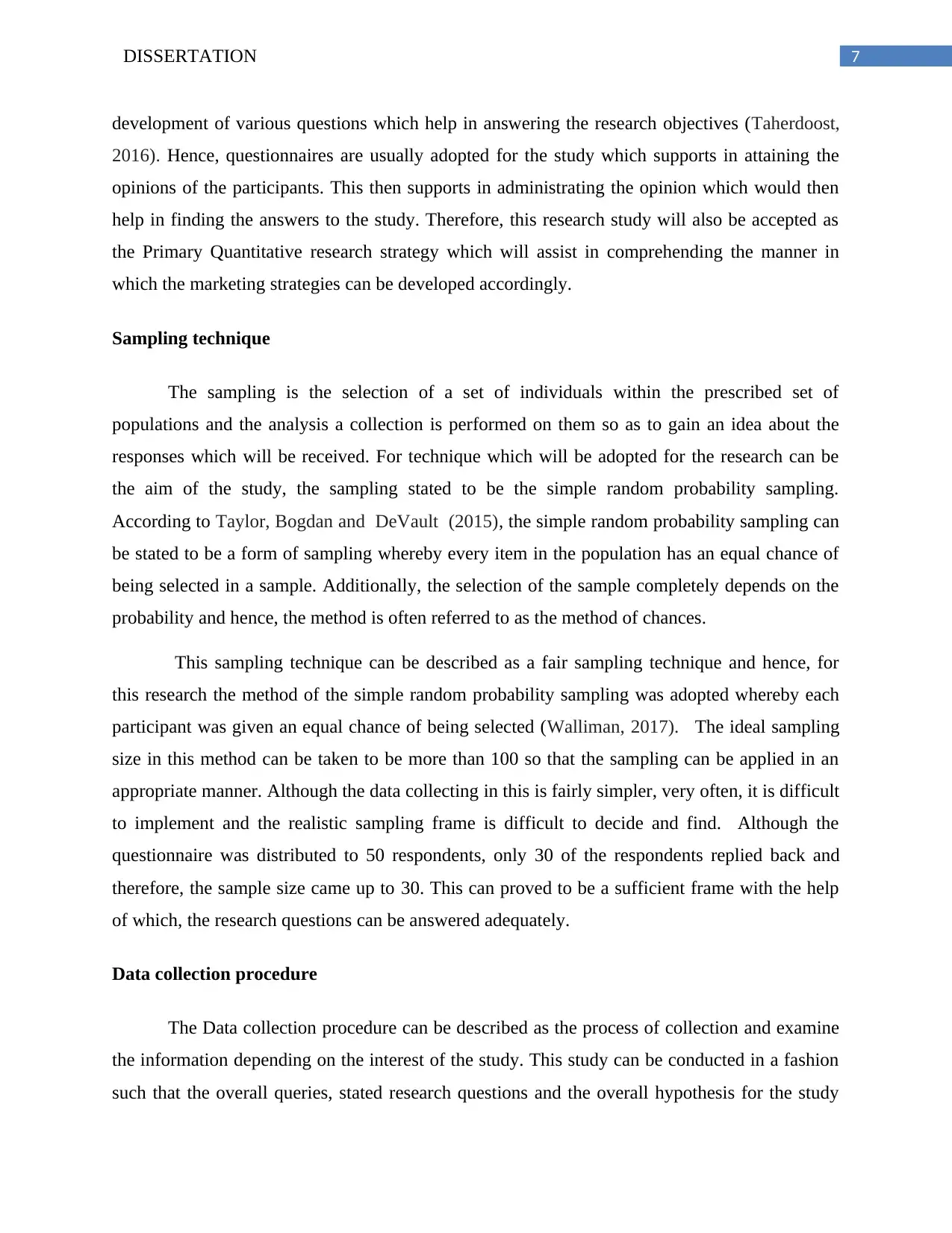
7DISSERTATION
development of various questions which help in answering the research objectives (Taherdoost,
2016). Hence, questionnaires are usually adopted for the study which supports in attaining the
opinions of the participants. This then supports in administrating the opinion which would then
help in finding the answers to the study. Therefore, this research study will also be accepted as
the Primary Quantitative research strategy which will assist in comprehending the manner in
which the marketing strategies can be developed accordingly.
Sampling technique
The sampling is the selection of a set of individuals within the prescribed set of
populations and the analysis a collection is performed on them so as to gain an idea about the
responses which will be received. For technique which will be adopted for the research can be
the aim of the study, the sampling stated to be the simple random probability sampling.
According to Taylor, Bogdan and DeVault (2015), the simple random probability sampling can
be stated to be a form of sampling whereby every item in the population has an equal chance of
being selected in a sample. Additionally, the selection of the sample completely depends on the
probability and hence, the method is often referred to as the method of chances.
This sampling technique can be described as a fair sampling technique and hence, for
this research the method of the simple random probability sampling was adopted whereby each
participant was given an equal chance of being selected (Walliman, 2017). The ideal sampling
size in this method can be taken to be more than 100 so that the sampling can be applied in an
appropriate manner. Although the data collecting in this is fairly simpler, very often, it is difficult
to implement and the realistic sampling frame is difficult to decide and find. Although the
questionnaire was distributed to 50 respondents, only 30 of the respondents replied back and
therefore, the sample size came up to 30. This can proved to be a sufficient frame with the help
of which, the research questions can be answered adequately.
Data collection procedure
The Data collection procedure can be described as the process of collection and examine
the information depending on the interest of the study. This study can be conducted in a fashion
such that the overall queries, stated research questions and the overall hypothesis for the study
development of various questions which help in answering the research objectives (Taherdoost,
2016). Hence, questionnaires are usually adopted for the study which supports in attaining the
opinions of the participants. This then supports in administrating the opinion which would then
help in finding the answers to the study. Therefore, this research study will also be accepted as
the Primary Quantitative research strategy which will assist in comprehending the manner in
which the marketing strategies can be developed accordingly.
Sampling technique
The sampling is the selection of a set of individuals within the prescribed set of
populations and the analysis a collection is performed on them so as to gain an idea about the
responses which will be received. For technique which will be adopted for the research can be
the aim of the study, the sampling stated to be the simple random probability sampling.
According to Taylor, Bogdan and DeVault (2015), the simple random probability sampling can
be stated to be a form of sampling whereby every item in the population has an equal chance of
being selected in a sample. Additionally, the selection of the sample completely depends on the
probability and hence, the method is often referred to as the method of chances.
This sampling technique can be described as a fair sampling technique and hence, for
this research the method of the simple random probability sampling was adopted whereby each
participant was given an equal chance of being selected (Walliman, 2017). The ideal sampling
size in this method can be taken to be more than 100 so that the sampling can be applied in an
appropriate manner. Although the data collecting in this is fairly simpler, very often, it is difficult
to implement and the realistic sampling frame is difficult to decide and find. Although the
questionnaire was distributed to 50 respondents, only 30 of the respondents replied back and
therefore, the sample size came up to 30. This can proved to be a sufficient frame with the help
of which, the research questions can be answered adequately.
Data collection procedure
The Data collection procedure can be described as the process of collection and examine
the information depending on the interest of the study. This study can be conducted in a fashion
such that the overall queries, stated research questions and the overall hypothesis for the study
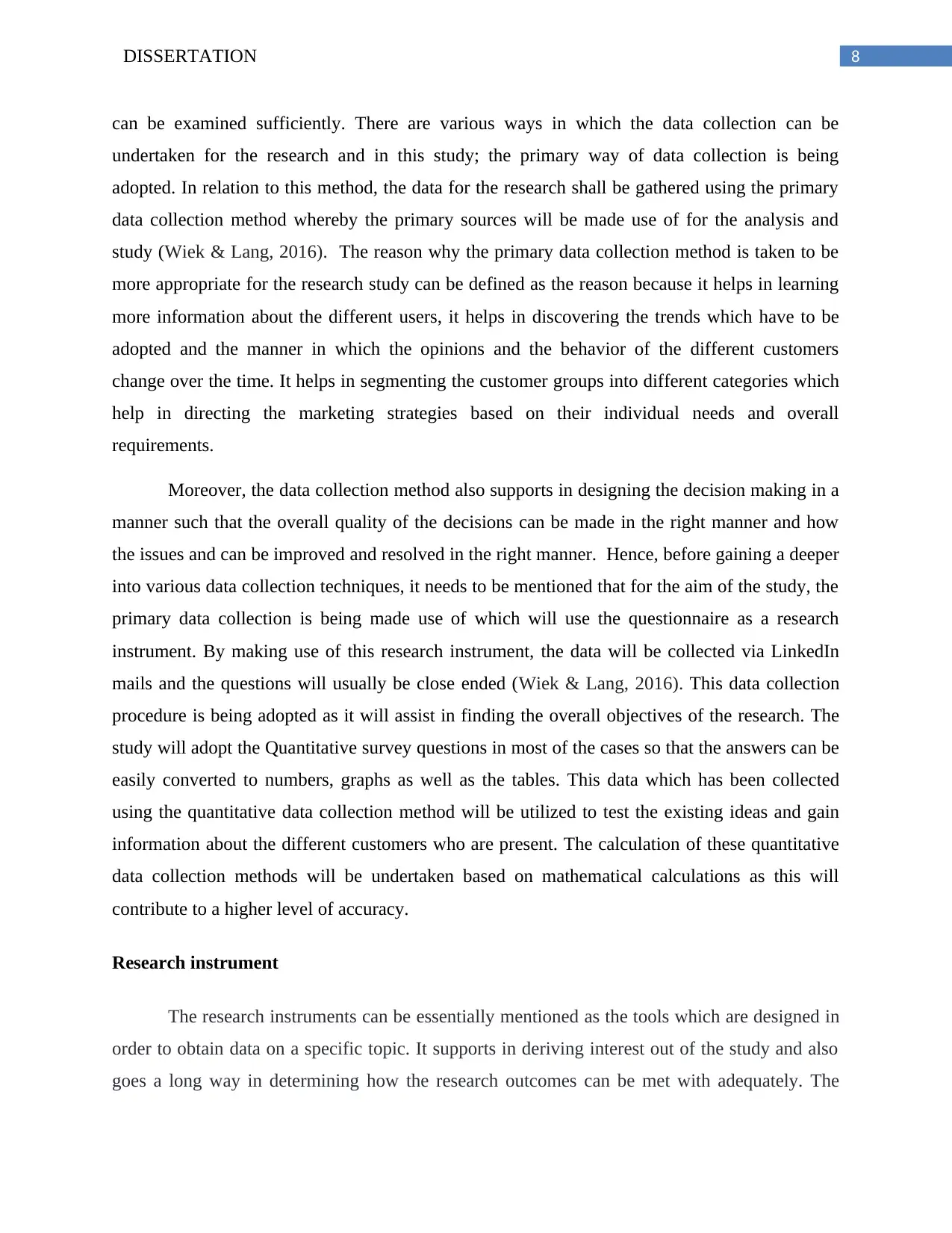
8DISSERTATION
can be examined sufficiently. There are various ways in which the data collection can be
undertaken for the research and in this study; the primary way of data collection is being
adopted. In relation to this method, the data for the research shall be gathered using the primary
data collection method whereby the primary sources will be made use of for the analysis and
study (Wiek & Lang, 2016). The reason why the primary data collection method is taken to be
more appropriate for the research study can be defined as the reason because it helps in learning
more information about the different users, it helps in discovering the trends which have to be
adopted and the manner in which the opinions and the behavior of the different customers
change over the time. It helps in segmenting the customer groups into different categories which
help in directing the marketing strategies based on their individual needs and overall
requirements.
Moreover, the data collection method also supports in designing the decision making in a
manner such that the overall quality of the decisions can be made in the right manner and how
the issues and can be improved and resolved in the right manner. Hence, before gaining a deeper
into various data collection techniques, it needs to be mentioned that for the aim of the study, the
primary data collection is being made use of which will use the questionnaire as a research
instrument. By making use of this research instrument, the data will be collected via LinkedIn
mails and the questions will usually be close ended (Wiek & Lang, 2016). This data collection
procedure is being adopted as it will assist in finding the overall objectives of the research. The
study will adopt the Quantitative survey questions in most of the cases so that the answers can be
easily converted to numbers, graphs as well as the tables. This data which has been collected
using the quantitative data collection method will be utilized to test the existing ideas and gain
information about the different customers who are present. The calculation of these quantitative
data collection methods will be undertaken based on mathematical calculations as this will
contribute to a higher level of accuracy.
Research instrument
The research instruments can be essentially mentioned as the tools which are designed in
order to obtain data on a specific topic. It supports in deriving interest out of the study and also
goes a long way in determining how the research outcomes can be met with adequately. The
can be examined sufficiently. There are various ways in which the data collection can be
undertaken for the research and in this study; the primary way of data collection is being
adopted. In relation to this method, the data for the research shall be gathered using the primary
data collection method whereby the primary sources will be made use of for the analysis and
study (Wiek & Lang, 2016). The reason why the primary data collection method is taken to be
more appropriate for the research study can be defined as the reason because it helps in learning
more information about the different users, it helps in discovering the trends which have to be
adopted and the manner in which the opinions and the behavior of the different customers
change over the time. It helps in segmenting the customer groups into different categories which
help in directing the marketing strategies based on their individual needs and overall
requirements.
Moreover, the data collection method also supports in designing the decision making in a
manner such that the overall quality of the decisions can be made in the right manner and how
the issues and can be improved and resolved in the right manner. Hence, before gaining a deeper
into various data collection techniques, it needs to be mentioned that for the aim of the study, the
primary data collection is being made use of which will use the questionnaire as a research
instrument. By making use of this research instrument, the data will be collected via LinkedIn
mails and the questions will usually be close ended (Wiek & Lang, 2016). This data collection
procedure is being adopted as it will assist in finding the overall objectives of the research. The
study will adopt the Quantitative survey questions in most of the cases so that the answers can be
easily converted to numbers, graphs as well as the tables. This data which has been collected
using the quantitative data collection method will be utilized to test the existing ideas and gain
information about the different customers who are present. The calculation of these quantitative
data collection methods will be undertaken based on mathematical calculations as this will
contribute to a higher level of accuracy.
Research instrument
The research instruments can be essentially mentioned as the tools which are designed in
order to obtain data on a specific topic. It supports in deriving interest out of the study and also
goes a long way in determining how the research outcomes can be met with adequately. The

9DISSERTATION
research instruments are also used to collect the data will also be made use of to keep a record of
the data which is to be collected for the research (Wiek & Lang, 2016). The research sample
which is being made use of in the given paper can be described as the questionnaire. The
questionnaire will follow the quantitative design whereby it will aim to ask the different
respondents certain closed ended questions and this will then assist in finding the results to the
study.
Additionally, the questionnaire will also help in presenting the adequate information of
the study which will then assist in deriving the graphical presentation of the data by making use
of various graphs as well as charts. In this research, the use of the questionnaire is being made to
collect the data from the various sources and additionally to graphically represent the
information which is available.
Data analysis procedure
The data analysis can be described as the manner in which the quantitative studies is
usually gathered and generally tends to involve a critical analysis of the interpretation of the
figures and the numbers which helps in finding the manner in which the findings of the study can
be presented (Quinlan et al., 2019). This analysis procedure also supports in comparing the
primary research findings to the overall findings of the review of literature. The method of data
analysis supports in certifying that the common patterns can be undertaken in a sound manner
and that the different controversies can be avoided. It helps in decision making regarding the
study and the data analysis methods which are usually present around the primary data collection
techniques involve the discussion of the common patterns and assist in finding the answer to the
research problems which tends to exist (Ramirez et al., 2015). Hence, in relation to this, the
major manners in which the data has to be analyzed for the research can be contributed to be the
Statistical analysis method (Silverman, 2016). In this kind of an analysis method, the past data is
made use of in order to undertake an analysis about the future. In this type of an analysis
technique or method, the data is usually collected and analyzed with the help of either descriptive
analysis or the inferential analysis (Sutrisna & Setiawan, 2016). This then contributes towards
comprehending the manner in which outcomes of the study which has been planned initially can
be identified.
research instruments are also used to collect the data will also be made use of to keep a record of
the data which is to be collected for the research (Wiek & Lang, 2016). The research sample
which is being made use of in the given paper can be described as the questionnaire. The
questionnaire will follow the quantitative design whereby it will aim to ask the different
respondents certain closed ended questions and this will then assist in finding the results to the
study.
Additionally, the questionnaire will also help in presenting the adequate information of
the study which will then assist in deriving the graphical presentation of the data by making use
of various graphs as well as charts. In this research, the use of the questionnaire is being made to
collect the data from the various sources and additionally to graphically represent the
information which is available.
Data analysis procedure
The data analysis can be described as the manner in which the quantitative studies is
usually gathered and generally tends to involve a critical analysis of the interpretation of the
figures and the numbers which helps in finding the manner in which the findings of the study can
be presented (Quinlan et al., 2019). This analysis procedure also supports in comparing the
primary research findings to the overall findings of the review of literature. The method of data
analysis supports in certifying that the common patterns can be undertaken in a sound manner
and that the different controversies can be avoided. It helps in decision making regarding the
study and the data analysis methods which are usually present around the primary data collection
techniques involve the discussion of the common patterns and assist in finding the answer to the
research problems which tends to exist (Ramirez et al., 2015). Hence, in relation to this, the
major manners in which the data has to be analyzed for the research can be contributed to be the
Statistical analysis method (Silverman, 2016). In this kind of an analysis method, the past data is
made use of in order to undertake an analysis about the future. In this type of an analysis
technique or method, the data is usually collected and analyzed with the help of either descriptive
analysis or the inferential analysis (Sutrisna & Setiawan, 2016). This then contributes towards
comprehending the manner in which outcomes of the study which has been planned initially can
be identified.
Secure Best Marks with AI Grader
Need help grading? Try our AI Grader for instant feedback on your assignments.
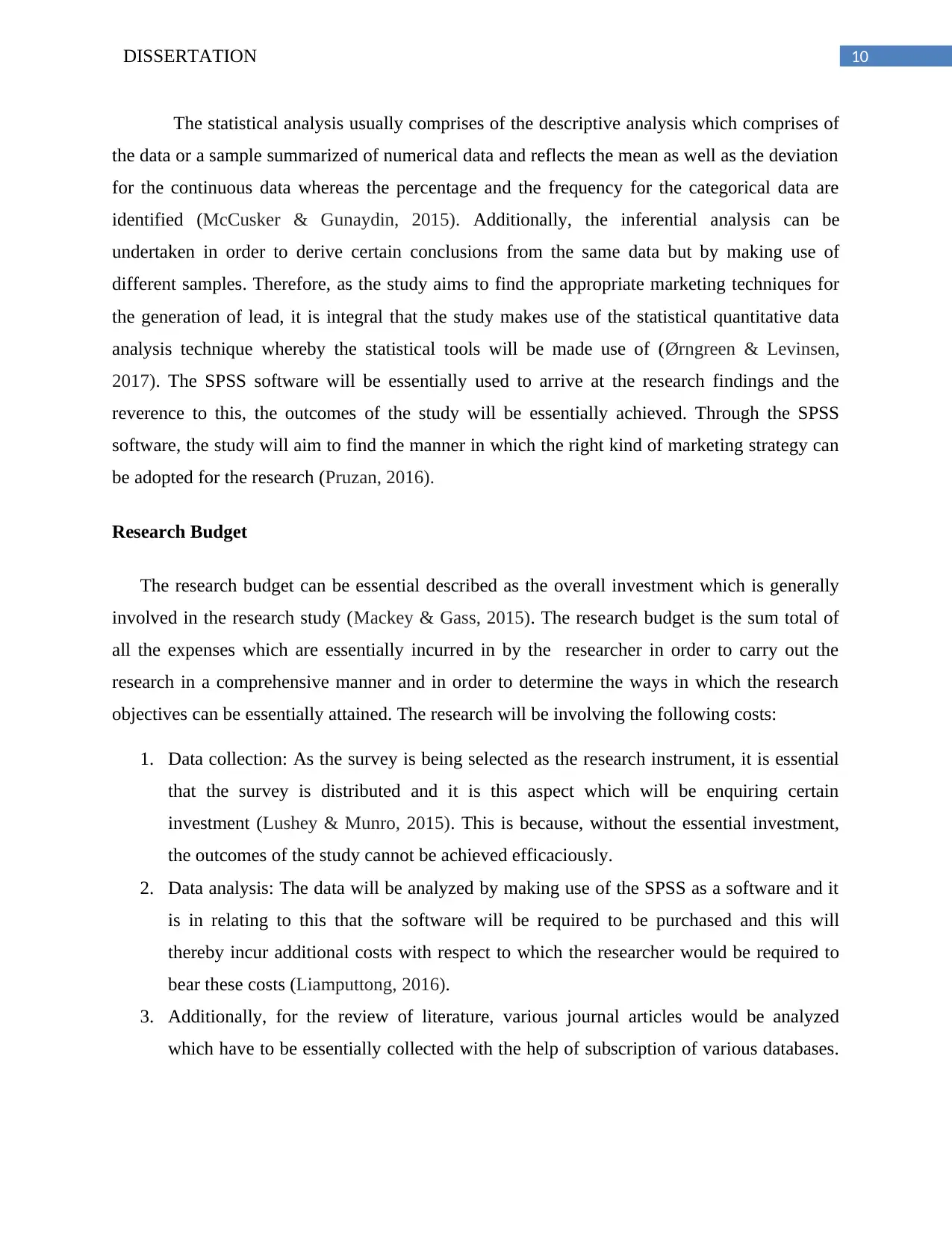
10DISSERTATION
The statistical analysis usually comprises of the descriptive analysis which comprises of
the data or a sample summarized of numerical data and reflects the mean as well as the deviation
for the continuous data whereas the percentage and the frequency for the categorical data are
identified (McCusker & Gunaydin, 2015). Additionally, the inferential analysis can be
undertaken in order to derive certain conclusions from the same data but by making use of
different samples. Therefore, as the study aims to find the appropriate marketing techniques for
the generation of lead, it is integral that the study makes use of the statistical quantitative data
analysis technique whereby the statistical tools will be made use of (Ørngreen & Levinsen,
2017). The SPSS software will be essentially used to arrive at the research findings and the
reverence to this, the outcomes of the study will be essentially achieved. Through the SPSS
software, the study will aim to find the manner in which the right kind of marketing strategy can
be adopted for the research (Pruzan, 2016).
Research Budget
The research budget can be essential described as the overall investment which is generally
involved in the research study (Mackey & Gass, 2015). The research budget is the sum total of
all the expenses which are essentially incurred in by the researcher in order to carry out the
research in a comprehensive manner and in order to determine the ways in which the research
objectives can be essentially attained. The research will be involving the following costs:
1. Data collection: As the survey is being selected as the research instrument, it is essential
that the survey is distributed and it is this aspect which will be enquiring certain
investment (Lushey & Munro, 2015). This is because, without the essential investment,
the outcomes of the study cannot be achieved efficaciously.
2. Data analysis: The data will be analyzed by making use of the SPSS as a software and it
is in relating to this that the software will be required to be purchased and this will
thereby incur additional costs with respect to which the researcher would be required to
bear these costs (Liamputtong, 2016).
3. Additionally, for the review of literature, various journal articles would be analyzed
which have to be essentially collected with the help of subscription of various databases.
The statistical analysis usually comprises of the descriptive analysis which comprises of
the data or a sample summarized of numerical data and reflects the mean as well as the deviation
for the continuous data whereas the percentage and the frequency for the categorical data are
identified (McCusker & Gunaydin, 2015). Additionally, the inferential analysis can be
undertaken in order to derive certain conclusions from the same data but by making use of
different samples. Therefore, as the study aims to find the appropriate marketing techniques for
the generation of lead, it is integral that the study makes use of the statistical quantitative data
analysis technique whereby the statistical tools will be made use of (Ørngreen & Levinsen,
2017). The SPSS software will be essentially used to arrive at the research findings and the
reverence to this, the outcomes of the study will be essentially achieved. Through the SPSS
software, the study will aim to find the manner in which the right kind of marketing strategy can
be adopted for the research (Pruzan, 2016).
Research Budget
The research budget can be essential described as the overall investment which is generally
involved in the research study (Mackey & Gass, 2015). The research budget is the sum total of
all the expenses which are essentially incurred in by the researcher in order to carry out the
research in a comprehensive manner and in order to determine the ways in which the research
objectives can be essentially attained. The research will be involving the following costs:
1. Data collection: As the survey is being selected as the research instrument, it is essential
that the survey is distributed and it is this aspect which will be enquiring certain
investment (Lushey & Munro, 2015). This is because, without the essential investment,
the outcomes of the study cannot be achieved efficaciously.
2. Data analysis: The data will be analyzed by making use of the SPSS as a software and it
is in relating to this that the software will be required to be purchased and this will
thereby incur additional costs with respect to which the researcher would be required to
bear these costs (Liamputtong, 2016).
3. Additionally, for the review of literature, various journal articles would be analyzed
which have to be essentially collected with the help of subscription of various databases.
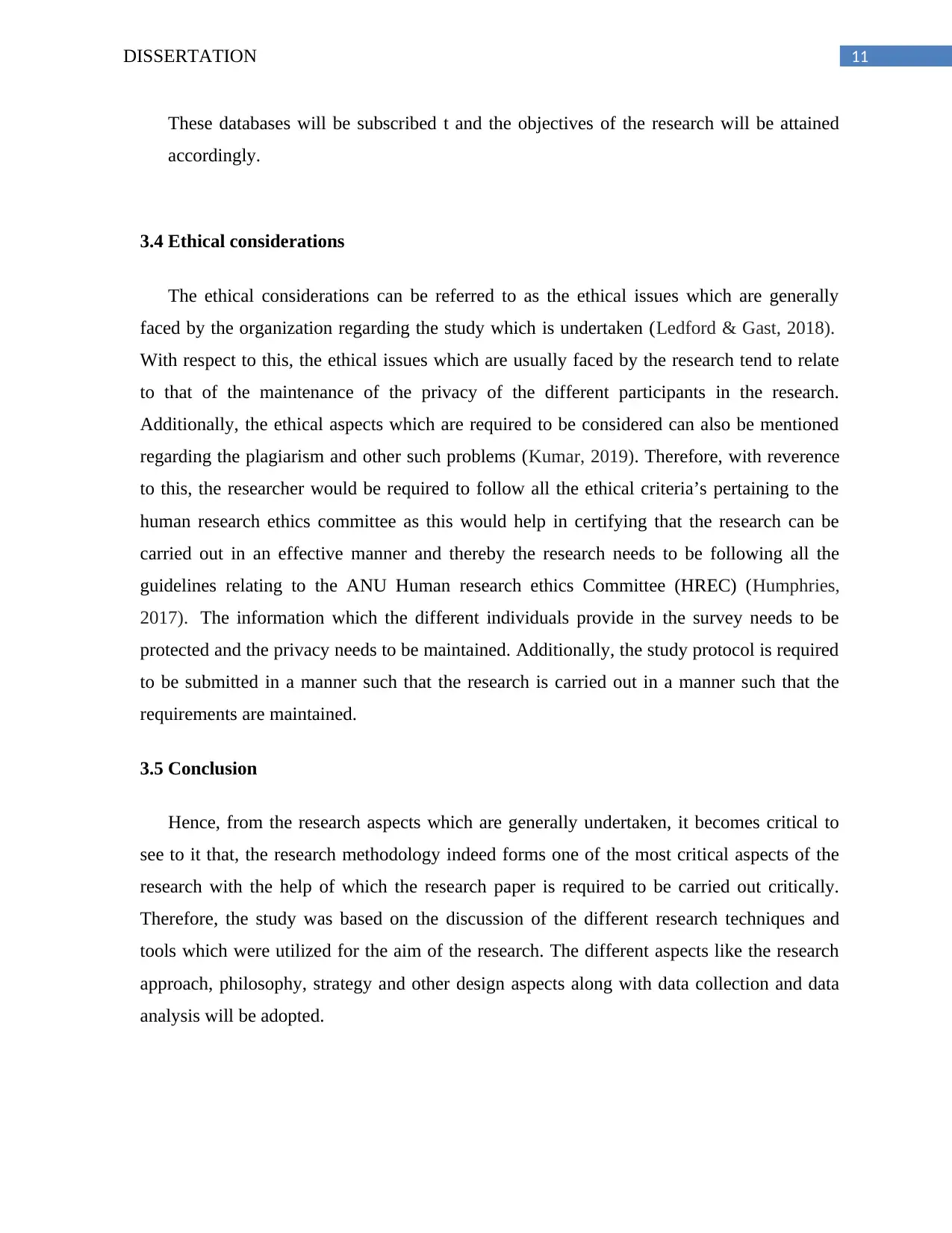
11DISSERTATION
These databases will be subscribed t and the objectives of the research will be attained
accordingly.
3.4 Ethical considerations
The ethical considerations can be referred to as the ethical issues which are generally
faced by the organization regarding the study which is undertaken (Ledford & Gast, 2018).
With respect to this, the ethical issues which are usually faced by the research tend to relate
to that of the maintenance of the privacy of the different participants in the research.
Additionally, the ethical aspects which are required to be considered can also be mentioned
regarding the plagiarism and other such problems (Kumar, 2019). Therefore, with reverence
to this, the researcher would be required to follow all the ethical criteria’s pertaining to the
human research ethics committee as this would help in certifying that the research can be
carried out in an effective manner and thereby the research needs to be following all the
guidelines relating to the ANU Human research ethics Committee (HREC) (Humphries,
2017). The information which the different individuals provide in the survey needs to be
protected and the privacy needs to be maintained. Additionally, the study protocol is required
to be submitted in a manner such that the research is carried out in a manner such that the
requirements are maintained.
3.5 Conclusion
Hence, from the research aspects which are generally undertaken, it becomes critical to
see to it that, the research methodology indeed forms one of the most critical aspects of the
research with the help of which the research paper is required to be carried out critically.
Therefore, the study was based on the discussion of the different research techniques and
tools which were utilized for the aim of the research. The different aspects like the research
approach, philosophy, strategy and other design aspects along with data collection and data
analysis will be adopted.
These databases will be subscribed t and the objectives of the research will be attained
accordingly.
3.4 Ethical considerations
The ethical considerations can be referred to as the ethical issues which are generally
faced by the organization regarding the study which is undertaken (Ledford & Gast, 2018).
With respect to this, the ethical issues which are usually faced by the research tend to relate
to that of the maintenance of the privacy of the different participants in the research.
Additionally, the ethical aspects which are required to be considered can also be mentioned
regarding the plagiarism and other such problems (Kumar, 2019). Therefore, with reverence
to this, the researcher would be required to follow all the ethical criteria’s pertaining to the
human research ethics committee as this would help in certifying that the research can be
carried out in an effective manner and thereby the research needs to be following all the
guidelines relating to the ANU Human research ethics Committee (HREC) (Humphries,
2017). The information which the different individuals provide in the survey needs to be
protected and the privacy needs to be maintained. Additionally, the study protocol is required
to be submitted in a manner such that the research is carried out in a manner such that the
requirements are maintained.
3.5 Conclusion
Hence, from the research aspects which are generally undertaken, it becomes critical to
see to it that, the research methodology indeed forms one of the most critical aspects of the
research with the help of which the research paper is required to be carried out critically.
Therefore, the study was based on the discussion of the different research techniques and
tools which were utilized for the aim of the research. The different aspects like the research
approach, philosophy, strategy and other design aspects along with data collection and data
analysis will be adopted.
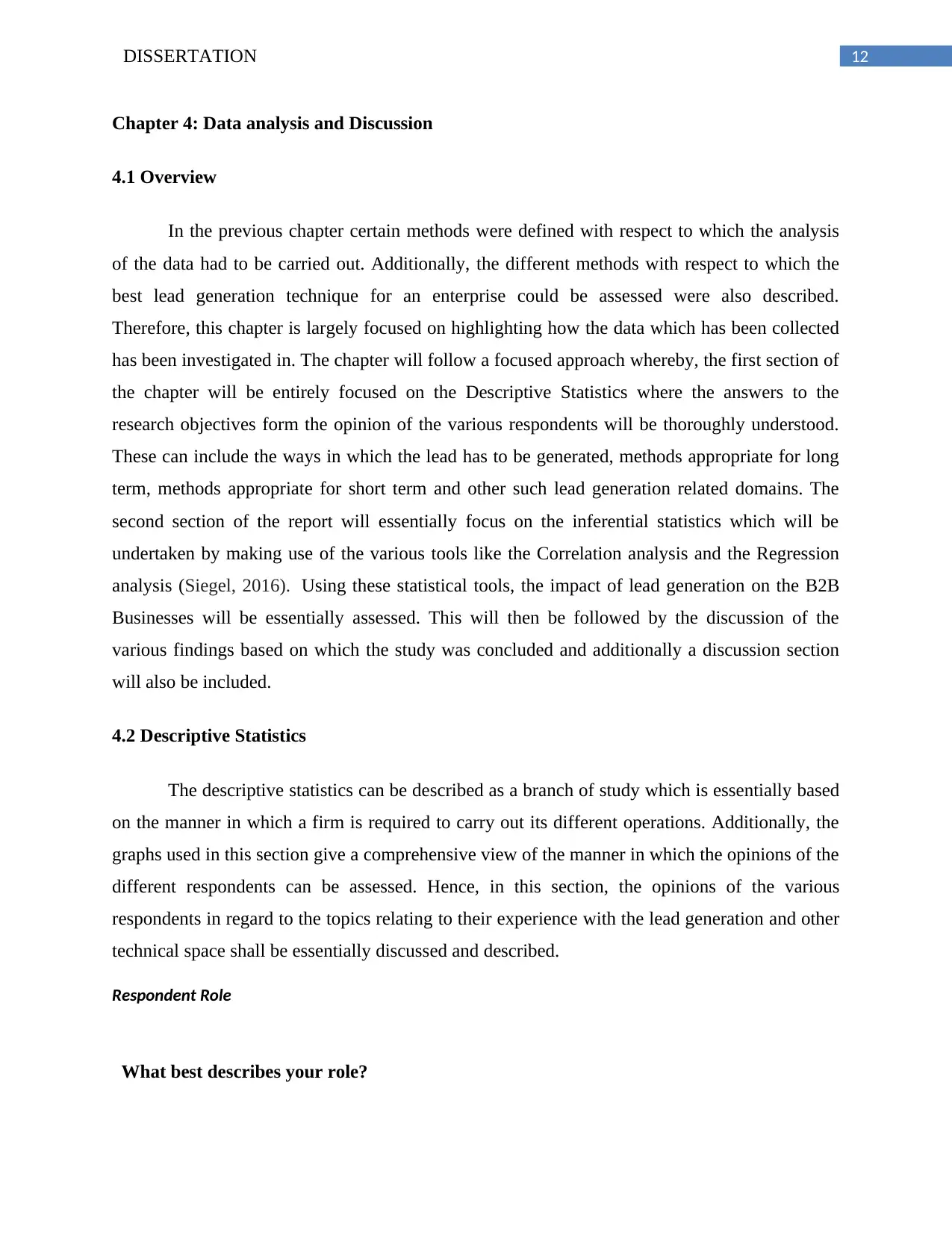
12DISSERTATION
Chapter 4: Data analysis and Discussion
4.1 Overview
In the previous chapter certain methods were defined with respect to which the analysis
of the data had to be carried out. Additionally, the different methods with respect to which the
best lead generation technique for an enterprise could be assessed were also described.
Therefore, this chapter is largely focused on highlighting how the data which has been collected
has been investigated in. The chapter will follow a focused approach whereby, the first section of
the chapter will be entirely focused on the Descriptive Statistics where the answers to the
research objectives form the opinion of the various respondents will be thoroughly understood.
These can include the ways in which the lead has to be generated, methods appropriate for long
term, methods appropriate for short term and other such lead generation related domains. The
second section of the report will essentially focus on the inferential statistics which will be
undertaken by making use of the various tools like the Correlation analysis and the Regression
analysis (Siegel, 2016). Using these statistical tools, the impact of lead generation on the B2B
Businesses will be essentially assessed. This will then be followed by the discussion of the
various findings based on which the study was concluded and additionally a discussion section
will also be included.
4.2 Descriptive Statistics
The descriptive statistics can be described as a branch of study which is essentially based
on the manner in which a firm is required to carry out its different operations. Additionally, the
graphs used in this section give a comprehensive view of the manner in which the opinions of the
different respondents can be assessed. Hence, in this section, the opinions of the various
respondents in regard to the topics relating to their experience with the lead generation and other
technical space shall be essentially discussed and described.
Respondent Role
What best describes your role?
Chapter 4: Data analysis and Discussion
4.1 Overview
In the previous chapter certain methods were defined with respect to which the analysis
of the data had to be carried out. Additionally, the different methods with respect to which the
best lead generation technique for an enterprise could be assessed were also described.
Therefore, this chapter is largely focused on highlighting how the data which has been collected
has been investigated in. The chapter will follow a focused approach whereby, the first section of
the chapter will be entirely focused on the Descriptive Statistics where the answers to the
research objectives form the opinion of the various respondents will be thoroughly understood.
These can include the ways in which the lead has to be generated, methods appropriate for long
term, methods appropriate for short term and other such lead generation related domains. The
second section of the report will essentially focus on the inferential statistics which will be
undertaken by making use of the various tools like the Correlation analysis and the Regression
analysis (Siegel, 2016). Using these statistical tools, the impact of lead generation on the B2B
Businesses will be essentially assessed. This will then be followed by the discussion of the
various findings based on which the study was concluded and additionally a discussion section
will also be included.
4.2 Descriptive Statistics
The descriptive statistics can be described as a branch of study which is essentially based
on the manner in which a firm is required to carry out its different operations. Additionally, the
graphs used in this section give a comprehensive view of the manner in which the opinions of the
different respondents can be assessed. Hence, in this section, the opinions of the various
respondents in regard to the topics relating to their experience with the lead generation and other
technical space shall be essentially discussed and described.
Respondent Role
What best describes your role?
Paraphrase This Document
Need a fresh take? Get an instant paraphrase of this document with our AI Paraphraser

13DISSERTATION
Frequency Percent
Valid
Percent
Cumulative
Percent
Valid CEO/Founder 12 40.0 40.0 40.0
Business Development
Manager
7 23.3 23.3 63.3
Inside Sales Manager 3 10.0 10.0 73.3
Marketing Manager 3 10.0 10.0 83.3
Sales Consultant 2 6.7 6.7 90.0
Country Manager 1 3.3 3.3 93.3
Freelance sales trainer 1 3.3 3.3 96.7
Marketing and
Operations Coordinator
1 3.3 3.3 100.0
Total 30 100.0 100.0
Figure 1: The Respondent Role
Frequency Percent
Valid
Percent
Cumulative
Percent
Valid CEO/Founder 12 40.0 40.0 40.0
Business Development
Manager
7 23.3 23.3 63.3
Inside Sales Manager 3 10.0 10.0 73.3
Marketing Manager 3 10.0 10.0 83.3
Sales Consultant 2 6.7 6.7 90.0
Country Manager 1 3.3 3.3 93.3
Freelance sales trainer 1 3.3 3.3 96.7
Marketing and
Operations Coordinator
1 3.3 3.3 100.0
Total 30 100.0 100.0
Figure 1: The Respondent Role
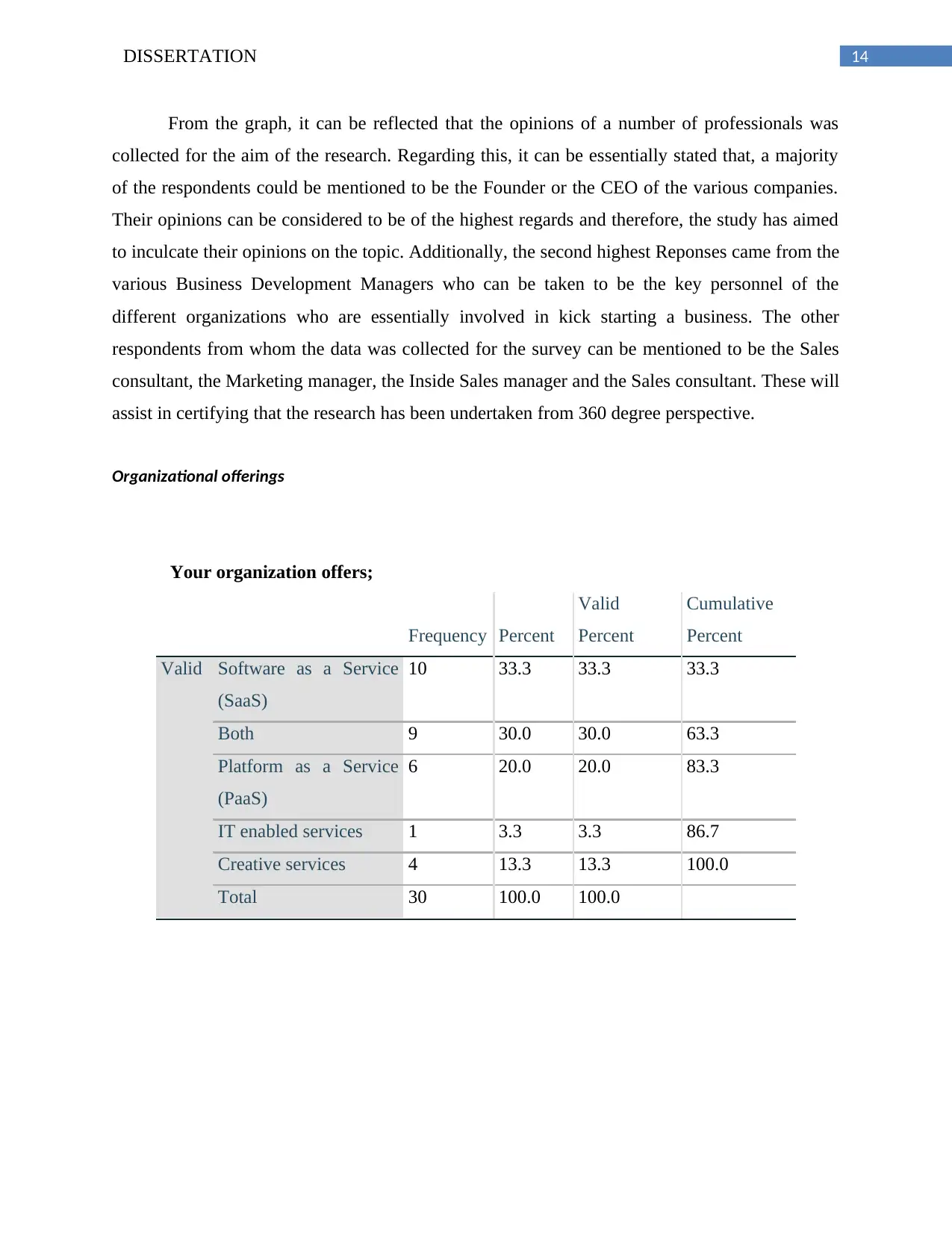
14DISSERTATION
From the graph, it can be reflected that the opinions of a number of professionals was
collected for the aim of the research. Regarding this, it can be essentially stated that, a majority
of the respondents could be mentioned to be the Founder or the CEO of the various companies.
Their opinions can be considered to be of the highest regards and therefore, the study has aimed
to inculcate their opinions on the topic. Additionally, the second highest Reponses came from the
various Business Development Managers who can be taken to be the key personnel of the
different organizations who are essentially involved in kick starting a business. The other
respondents from whom the data was collected for the survey can be mentioned to be the Sales
consultant, the Marketing manager, the Inside Sales manager and the Sales consultant. These will
assist in certifying that the research has been undertaken from 360 degree perspective.
Organizational offerings
Your organization offers;
Frequency Percent
Valid
Percent
Cumulative
Percent
Valid Software as a Service
(SaaS)
10 33.3 33.3 33.3
Both 9 30.0 30.0 63.3
Platform as a Service
(PaaS)
6 20.0 20.0 83.3
IT enabled services 1 3.3 3.3 86.7
Creative services 4 13.3 13.3 100.0
Total 30 100.0 100.0
From the graph, it can be reflected that the opinions of a number of professionals was
collected for the aim of the research. Regarding this, it can be essentially stated that, a majority
of the respondents could be mentioned to be the Founder or the CEO of the various companies.
Their opinions can be considered to be of the highest regards and therefore, the study has aimed
to inculcate their opinions on the topic. Additionally, the second highest Reponses came from the
various Business Development Managers who can be taken to be the key personnel of the
different organizations who are essentially involved in kick starting a business. The other
respondents from whom the data was collected for the survey can be mentioned to be the Sales
consultant, the Marketing manager, the Inside Sales manager and the Sales consultant. These will
assist in certifying that the research has been undertaken from 360 degree perspective.
Organizational offerings
Your organization offers;
Frequency Percent
Valid
Percent
Cumulative
Percent
Valid Software as a Service
(SaaS)
10 33.3 33.3 33.3
Both 9 30.0 30.0 63.3
Platform as a Service
(PaaS)
6 20.0 20.0 83.3
IT enabled services 1 3.3 3.3 86.7
Creative services 4 13.3 13.3 100.0
Total 30 100.0 100.0
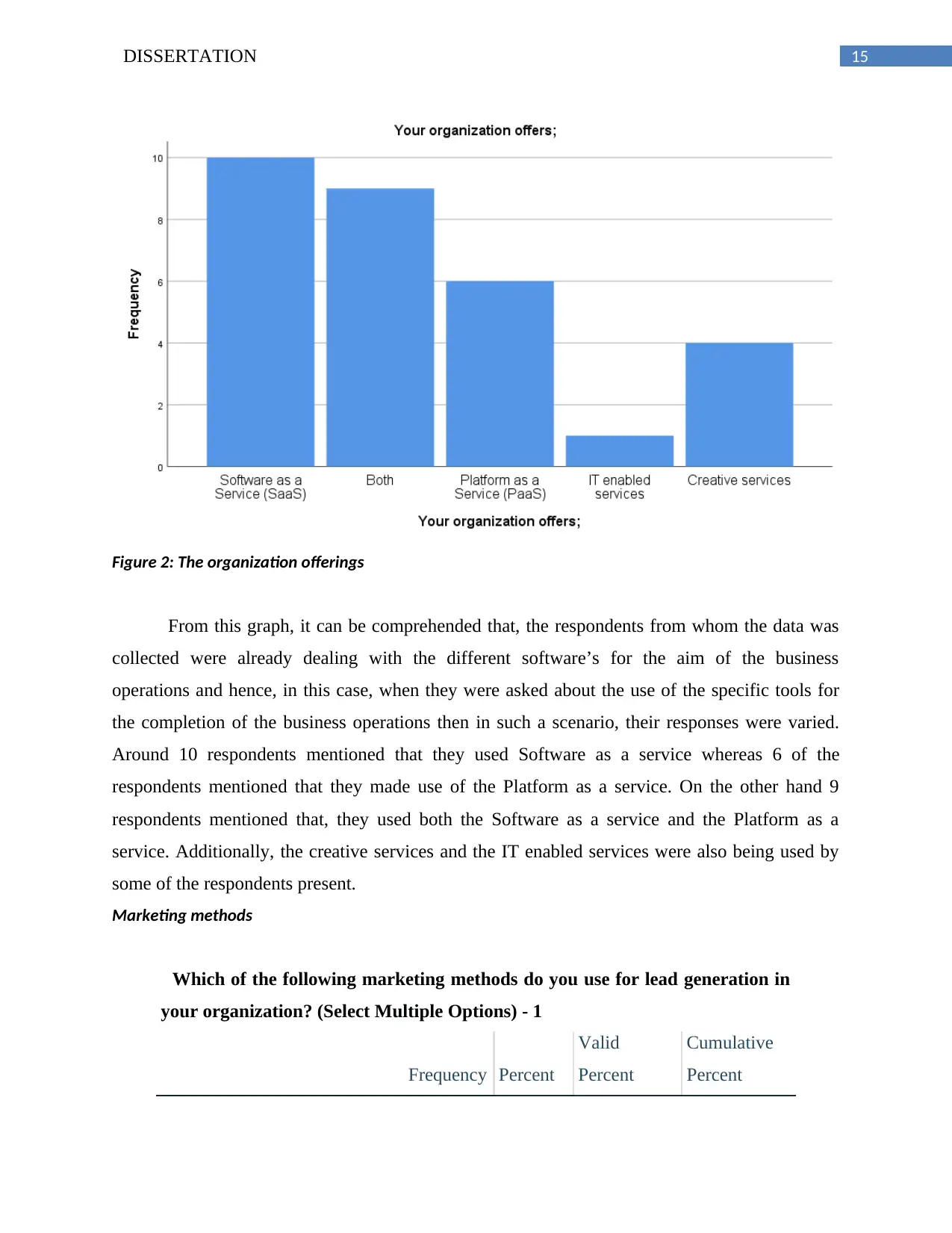
15DISSERTATION
Figure 2: The organization offerings
From this graph, it can be comprehended that, the respondents from whom the data was
collected were already dealing with the different software’s for the aim of the business
operations and hence, in this case, when they were asked about the use of the specific tools for
the completion of the business operations then in such a scenario, their responses were varied.
Around 10 respondents mentioned that they used Software as a service whereas 6 of the
respondents mentioned that they made use of the Platform as a service. On the other hand 9
respondents mentioned that, they used both the Software as a service and the Platform as a
service. Additionally, the creative services and the IT enabled services were also being used by
some of the respondents present.
Marketing methods
Which of the following marketing methods do you use for lead generation in
your organization? (Select Multiple Options) - 1
Frequency Percent
Valid
Percent
Cumulative
Percent
Figure 2: The organization offerings
From this graph, it can be comprehended that, the respondents from whom the data was
collected were already dealing with the different software’s for the aim of the business
operations and hence, in this case, when they were asked about the use of the specific tools for
the completion of the business operations then in such a scenario, their responses were varied.
Around 10 respondents mentioned that they used Software as a service whereas 6 of the
respondents mentioned that they made use of the Platform as a service. On the other hand 9
respondents mentioned that, they used both the Software as a service and the Platform as a
service. Additionally, the creative services and the IT enabled services were also being used by
some of the respondents present.
Marketing methods
Which of the following marketing methods do you use for lead generation in
your organization? (Select Multiple Options) - 1
Frequency Percent
Valid
Percent
Cumulative
Percent
Secure Best Marks with AI Grader
Need help grading? Try our AI Grader for instant feedback on your assignments.
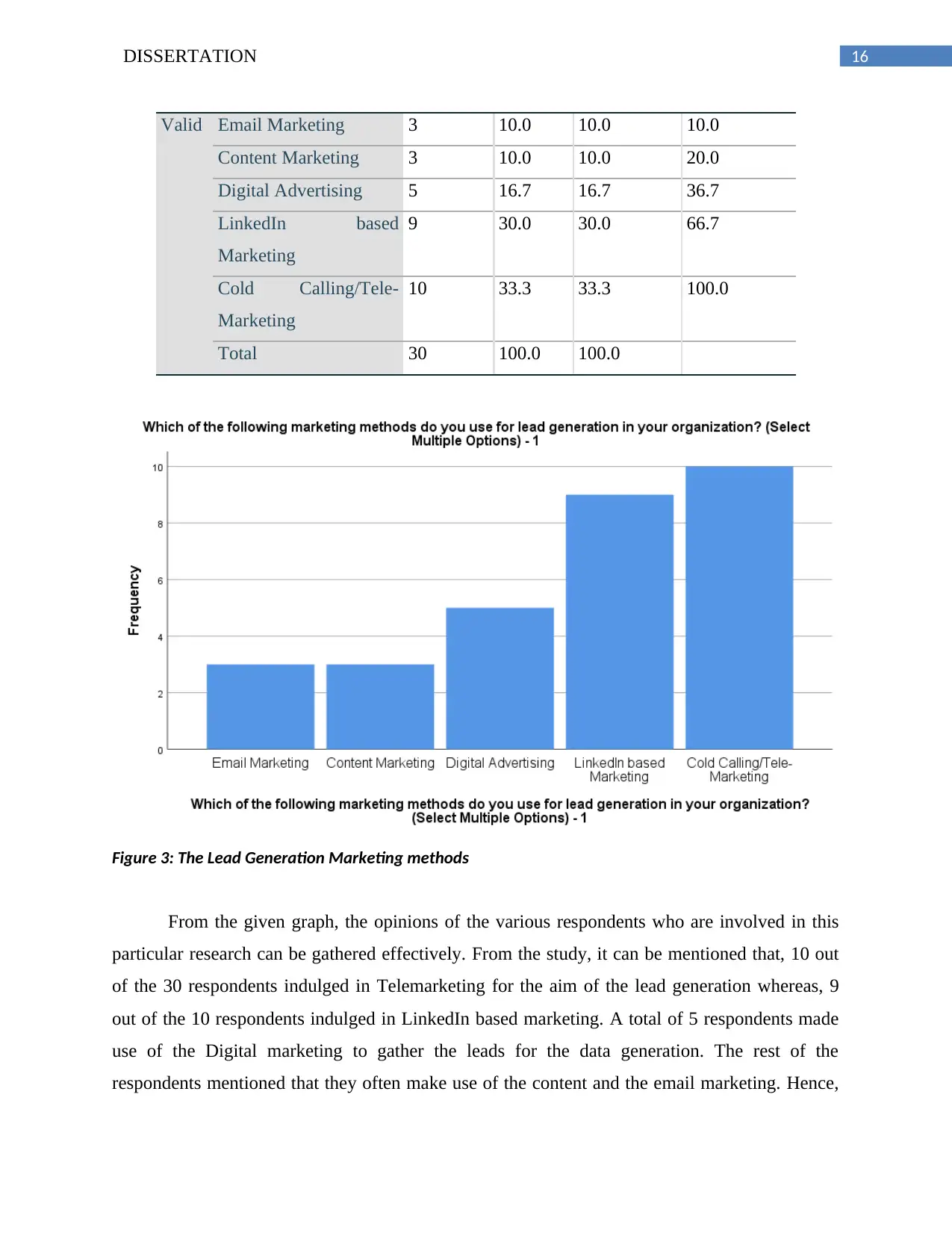
16DISSERTATION
Valid Email Marketing 3 10.0 10.0 10.0
Content Marketing 3 10.0 10.0 20.0
Digital Advertising 5 16.7 16.7 36.7
LinkedIn based
Marketing
9 30.0 30.0 66.7
Cold Calling/Tele-
Marketing
10 33.3 33.3 100.0
Total 30 100.0 100.0
Figure 3: The Lead Generation Marketing methods
From the given graph, the opinions of the various respondents who are involved in this
particular research can be gathered effectively. From the study, it can be mentioned that, 10 out
of the 30 respondents indulged in Telemarketing for the aim of the lead generation whereas, 9
out of the 10 respondents indulged in LinkedIn based marketing. A total of 5 respondents made
use of the Digital marketing to gather the leads for the data generation. The rest of the
respondents mentioned that they often make use of the content and the email marketing. Hence,
Valid Email Marketing 3 10.0 10.0 10.0
Content Marketing 3 10.0 10.0 20.0
Digital Advertising 5 16.7 16.7 36.7
LinkedIn based
Marketing
9 30.0 30.0 66.7
Cold Calling/Tele-
Marketing
10 33.3 33.3 100.0
Total 30 100.0 100.0
Figure 3: The Lead Generation Marketing methods
From the given graph, the opinions of the various respondents who are involved in this
particular research can be gathered effectively. From the study, it can be mentioned that, 10 out
of the 30 respondents indulged in Telemarketing for the aim of the lead generation whereas, 9
out of the 10 respondents indulged in LinkedIn based marketing. A total of 5 respondents made
use of the Digital marketing to gather the leads for the data generation. The rest of the
respondents mentioned that they often make use of the content and the email marketing. Hence,
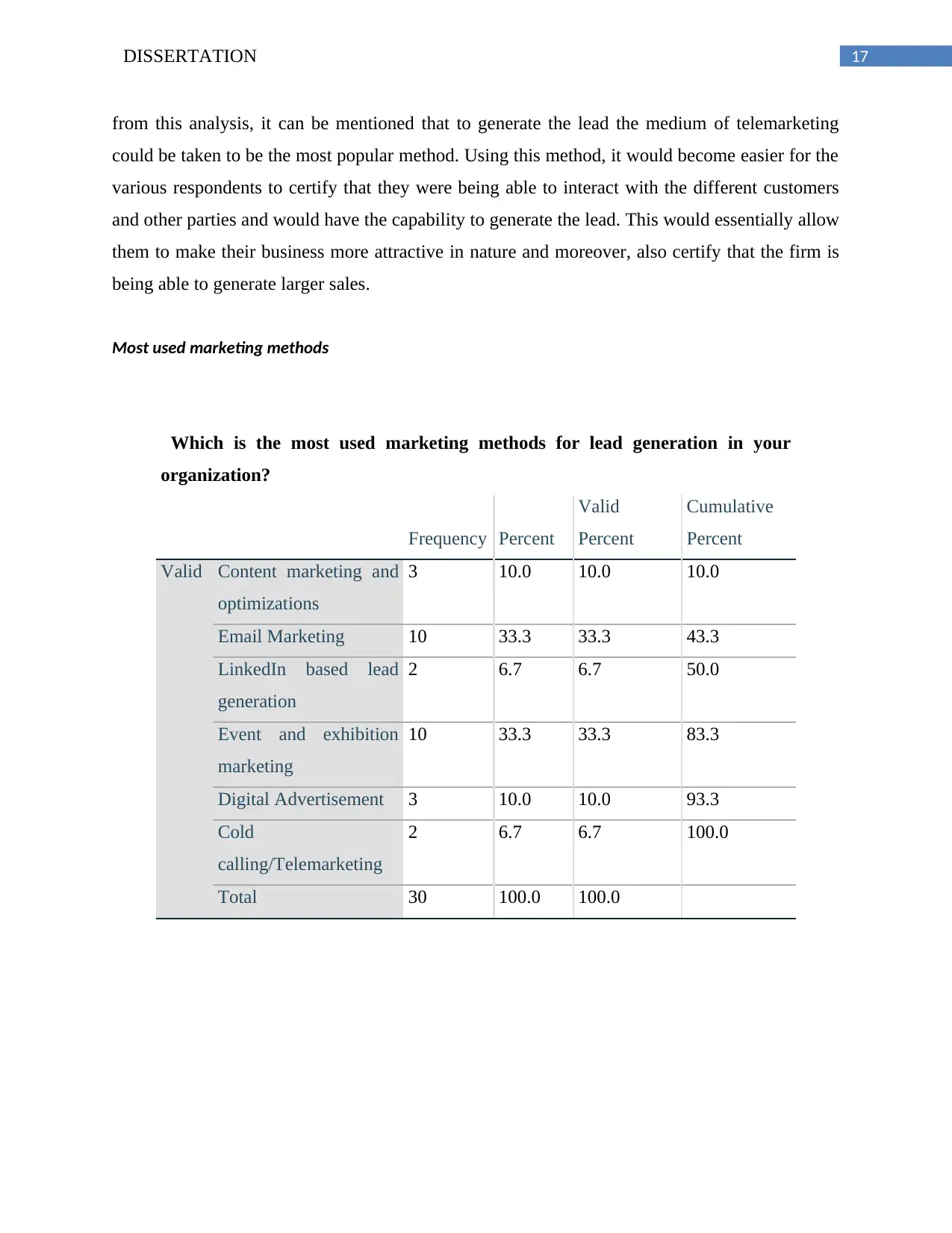
17DISSERTATION
from this analysis, it can be mentioned that to generate the lead the medium of telemarketing
could be taken to be the most popular method. Using this method, it would become easier for the
various respondents to certify that they were being able to interact with the different customers
and other parties and would have the capability to generate the lead. This would essentially allow
them to make their business more attractive in nature and moreover, also certify that the firm is
being able to generate larger sales.
Most used marketing methods
Which is the most used marketing methods for lead generation in your
organization?
Frequency Percent
Valid
Percent
Cumulative
Percent
Valid Content marketing and
optimizations
3 10.0 10.0 10.0
Email Marketing 10 33.3 33.3 43.3
LinkedIn based lead
generation
2 6.7 6.7 50.0
Event and exhibition
marketing
10 33.3 33.3 83.3
Digital Advertisement 3 10.0 10.0 93.3
Cold
calling/Telemarketing
2 6.7 6.7 100.0
Total 30 100.0 100.0
from this analysis, it can be mentioned that to generate the lead the medium of telemarketing
could be taken to be the most popular method. Using this method, it would become easier for the
various respondents to certify that they were being able to interact with the different customers
and other parties and would have the capability to generate the lead. This would essentially allow
them to make their business more attractive in nature and moreover, also certify that the firm is
being able to generate larger sales.
Most used marketing methods
Which is the most used marketing methods for lead generation in your
organization?
Frequency Percent
Valid
Percent
Cumulative
Percent
Valid Content marketing and
optimizations
3 10.0 10.0 10.0
Email Marketing 10 33.3 33.3 43.3
LinkedIn based lead
generation
2 6.7 6.7 50.0
Event and exhibition
marketing
10 33.3 33.3 83.3
Digital Advertisement 3 10.0 10.0 93.3
Cold
calling/Telemarketing
2 6.7 6.7 100.0
Total 30 100.0 100.0

18DISSERTATION
Figure 4: Most used marketing method
From the given image and the table provided, it can be reflected that, when the various
respondents from whom the survey was conducted mentioned that the most useful method for
lead generation can be stated to be the email marketing and event marketing. The respondents
mentioned that although their personal opinion differed regarding the use of the appropriate tool
for the generation of the lead, the most used lead generation mediums used by the organization
can be mentioned to be the Email marketing. The firms made use of the email marketing
regularly to get in touch with the various customers and with consideration to this; they also
made use of the event marketing which assisted them to get in touch with the different clients
who are present in the external environment.
Thought process of the lead generation
Considering the lead generation process; what do you think about
following steps?
Figure 4: Most used marketing method
From the given image and the table provided, it can be reflected that, when the various
respondents from whom the survey was conducted mentioned that the most useful method for
lead generation can be stated to be the email marketing and event marketing. The respondents
mentioned that although their personal opinion differed regarding the use of the appropriate tool
for the generation of the lead, the most used lead generation mediums used by the organization
can be mentioned to be the Email marketing. The firms made use of the email marketing
regularly to get in touch with the various customers and with consideration to this; they also
made use of the event marketing which assisted them to get in touch with the different clients
who are present in the external environment.
Thought process of the lead generation
Considering the lead generation process; what do you think about
following steps?
Paraphrase This Document
Need a fresh take? Get an instant paraphrase of this document with our AI Paraphraser
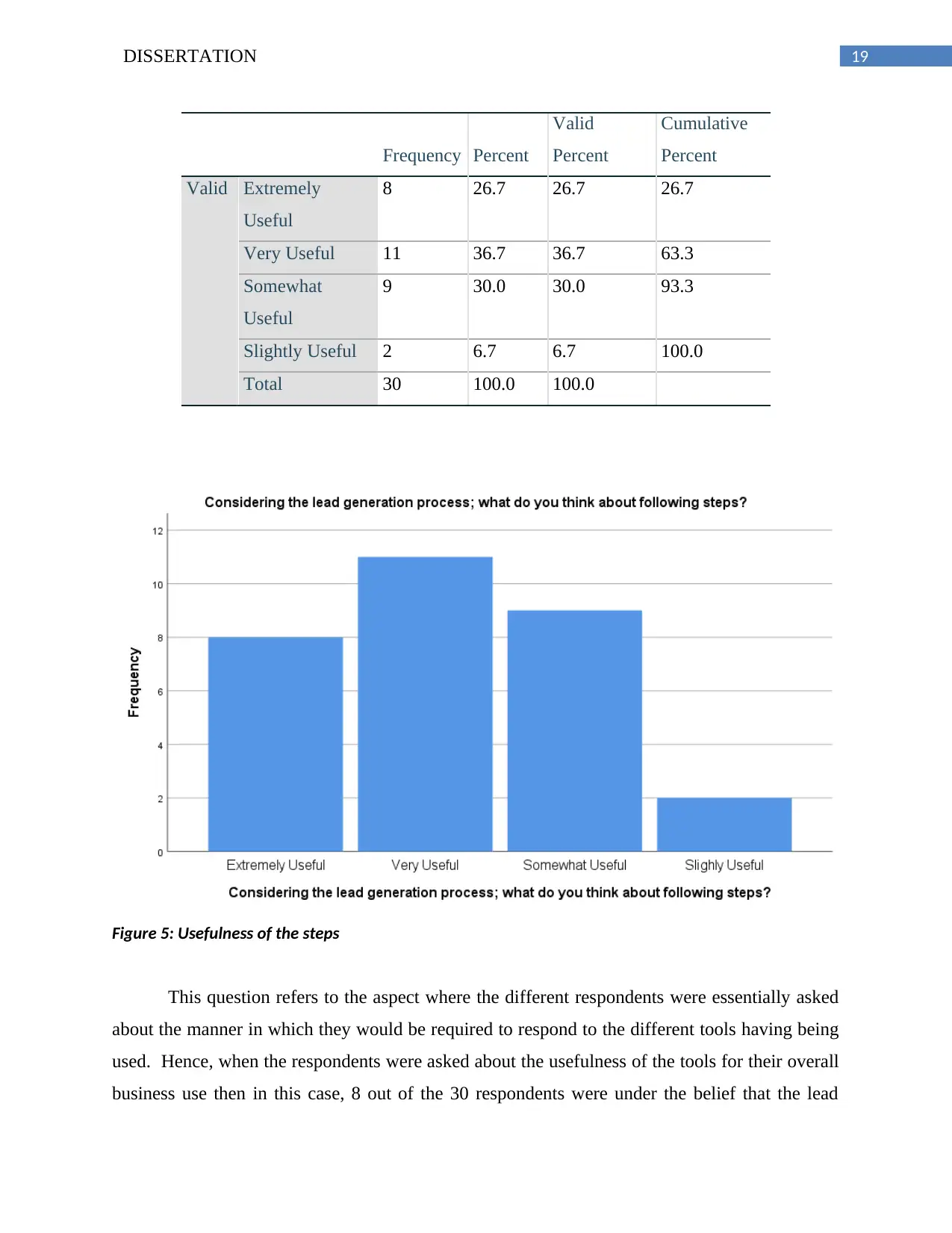
19DISSERTATION
Frequency Percent
Valid
Percent
Cumulative
Percent
Valid Extremely
Useful
8 26.7 26.7 26.7
Very Useful 11 36.7 36.7 63.3
Somewhat
Useful
9 30.0 30.0 93.3
Slightly Useful 2 6.7 6.7 100.0
Total 30 100.0 100.0
Figure 5: Usefulness of the steps
This question refers to the aspect where the different respondents were essentially asked
about the manner in which they would be required to respond to the different tools having being
used. Hence, when the respondents were asked about the usefulness of the tools for their overall
business use then in this case, 8 out of the 30 respondents were under the belief that the lead
Frequency Percent
Valid
Percent
Cumulative
Percent
Valid Extremely
Useful
8 26.7 26.7 26.7
Very Useful 11 36.7 36.7 63.3
Somewhat
Useful
9 30.0 30.0 93.3
Slightly Useful 2 6.7 6.7 100.0
Total 30 100.0 100.0
Figure 5: Usefulness of the steps
This question refers to the aspect where the different respondents were essentially asked
about the manner in which they would be required to respond to the different tools having being
used. Hence, when the respondents were asked about the usefulness of the tools for their overall
business use then in this case, 8 out of the 30 respondents were under the belief that the lead

20DISSERTATION
generation process essentially requires the use of email marketing, tele marketing and other such
techniques which are extremely useful in generating the lead of the organization. Additionally
out of the 30 respondents from whom the data was collected were under the belief that they were
making use of considerable lead generation techniques, it was assessed that 9 of them believed
that it was somewhat useful and then 11 out of them believed
that it was very useful. Hence, in consideration to this, only 2 out of the 30 respondents were
under the belief that the lead generation techniques were only slightly useful.
Logical sequence of Lead generation marketing
Email
Marketing
Telemarketin
g
LinkedI
n
Content
marketing
Digital
advertising
Event
marketi
ng
4 5 3 2 1 6
From the given table, it can be rightfully assessed that as per the popular opinion of the
various respondents, the given sequence needs to be followed by any respondent in order to
generate maximum lead for the business and to certify that the firm is being able to attain all the
objectives which have been set down for itself. From the table it can be assessed that the
respondents believed that the Digital advertising is the most common type of marketing for lead
generation which needs to be used and should be the first one in the sequence. This can then be
followed by the content marketing which can be taken to be an indirect means of marketing to
generate the lead for the business. The LinkedIn can be taken to be the third in sequence which
can be made use of in order to measure the way in which the lead needs to be generated for the
aim of the business. This was then followed by the email marketing and the telemarketing
mediums of lead generation. The last order in sequence could be understood to be the event
marketing which needs to be used at last when the firm fails to generate the adequate number of
leads for the business.
Which of the techniques provide maximum return on investment?
generation process essentially requires the use of email marketing, tele marketing and other such
techniques which are extremely useful in generating the lead of the organization. Additionally
out of the 30 respondents from whom the data was collected were under the belief that they were
making use of considerable lead generation techniques, it was assessed that 9 of them believed
that it was somewhat useful and then 11 out of them believed
that it was very useful. Hence, in consideration to this, only 2 out of the 30 respondents were
under the belief that the lead generation techniques were only slightly useful.
Logical sequence of Lead generation marketing
Marketing
Telemarketin
g
LinkedI
n
Content
marketing
Digital
advertising
Event
marketi
ng
4 5 3 2 1 6
From the given table, it can be rightfully assessed that as per the popular opinion of the
various respondents, the given sequence needs to be followed by any respondent in order to
generate maximum lead for the business and to certify that the firm is being able to attain all the
objectives which have been set down for itself. From the table it can be assessed that the
respondents believed that the Digital advertising is the most common type of marketing for lead
generation which needs to be used and should be the first one in the sequence. This can then be
followed by the content marketing which can be taken to be an indirect means of marketing to
generate the lead for the business. The LinkedIn can be taken to be the third in sequence which
can be made use of in order to measure the way in which the lead needs to be generated for the
aim of the business. This was then followed by the email marketing and the telemarketing
mediums of lead generation. The last order in sequence could be understood to be the event
marketing which needs to be used at last when the firm fails to generate the adequate number of
leads for the business.
Which of the techniques provide maximum return on investment?
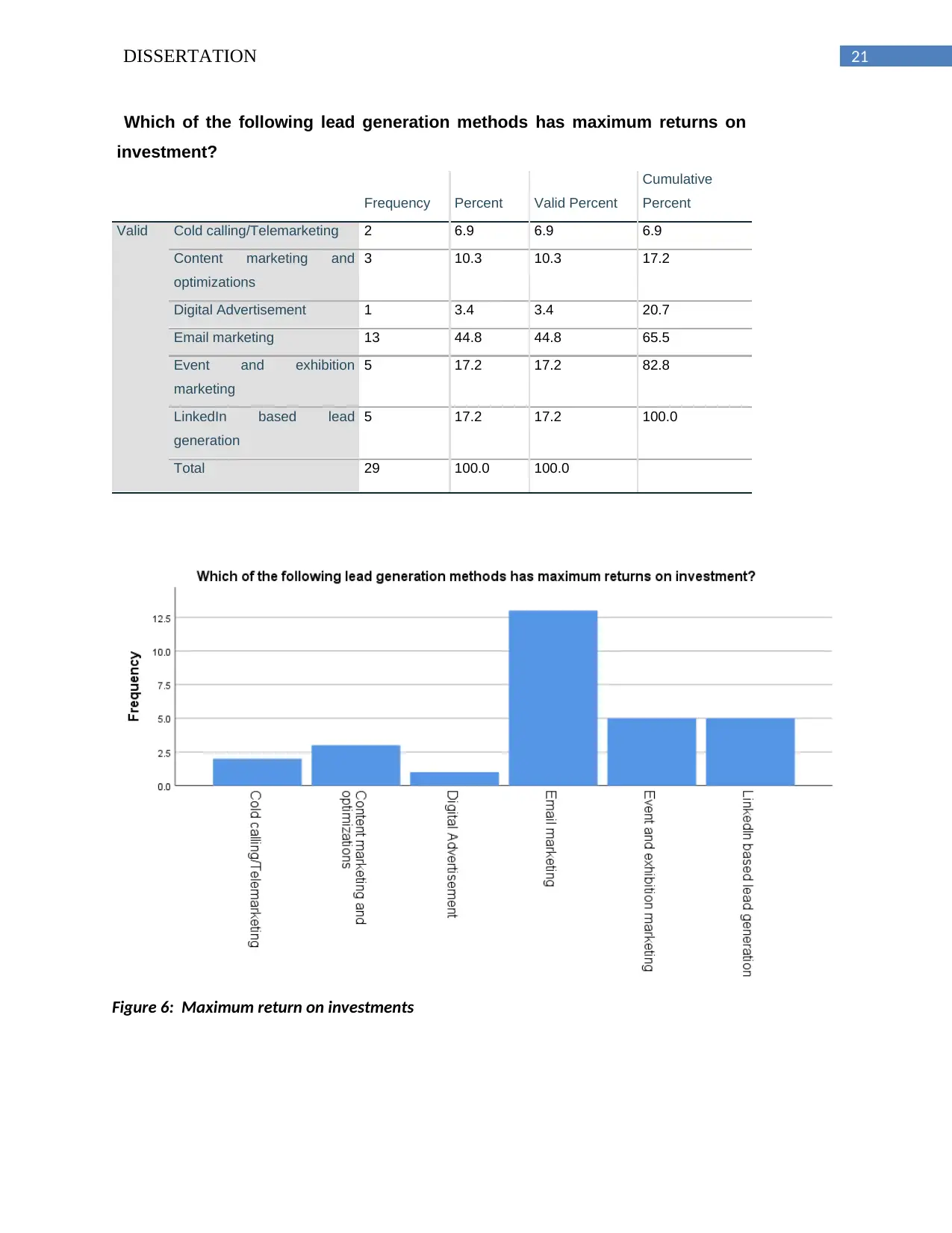
21DISSERTATION
Which of the following lead generation methods has maximum returns on
investment?
Frequency Percent Valid Percent
Cumulative
Percent
Valid Cold calling/Telemarketing 2 6.9 6.9 6.9
Content marketing and
optimizations
3 10.3 10.3 17.2
Digital Advertisement 1 3.4 3.4 20.7
Email marketing 13 44.8 44.8 65.5
Event and exhibition
marketing
5 17.2 17.2 82.8
LinkedIn based lead
generation
5 17.2 17.2 100.0
Total 29 100.0 100.0
Figure 6: Maximum return on investments
Which of the following lead generation methods has maximum returns on
investment?
Frequency Percent Valid Percent
Cumulative
Percent
Valid Cold calling/Telemarketing 2 6.9 6.9 6.9
Content marketing and
optimizations
3 10.3 10.3 17.2
Digital Advertisement 1 3.4 3.4 20.7
Email marketing 13 44.8 44.8 65.5
Event and exhibition
marketing
5 17.2 17.2 82.8
LinkedIn based lead
generation
5 17.2 17.2 100.0
Total 29 100.0 100.0
Figure 6: Maximum return on investments
Secure Best Marks with AI Grader
Need help grading? Try our AI Grader for instant feedback on your assignments.
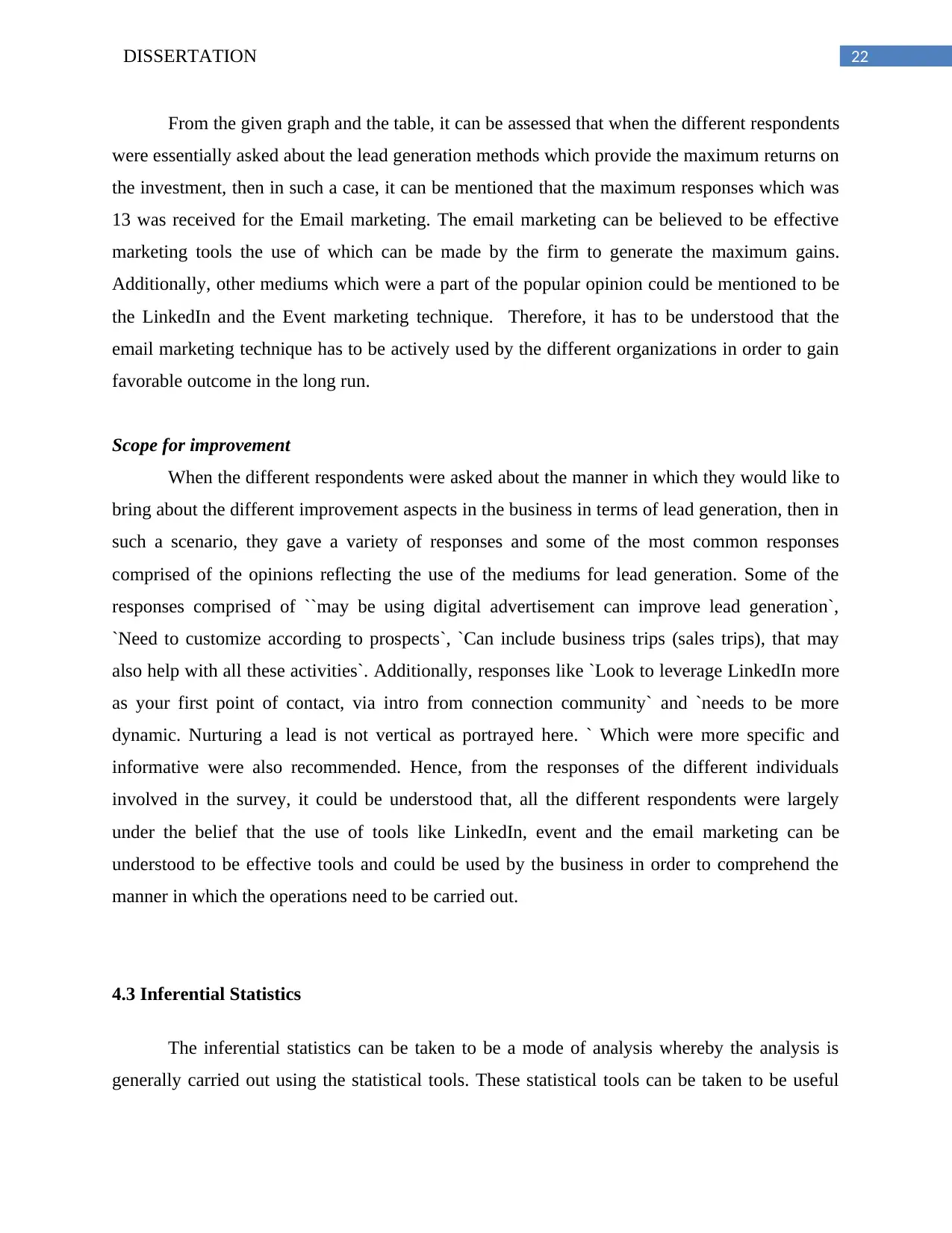
22DISSERTATION
From the given graph and the table, it can be assessed that when the different respondents
were essentially asked about the lead generation methods which provide the maximum returns on
the investment, then in such a case, it can be mentioned that the maximum responses which was
13 was received for the Email marketing. The email marketing can be believed to be effective
marketing tools the use of which can be made by the firm to generate the maximum gains.
Additionally, other mediums which were a part of the popular opinion could be mentioned to be
the LinkedIn and the Event marketing technique. Therefore, it has to be understood that the
email marketing technique has to be actively used by the different organizations in order to gain
favorable outcome in the long run.
Scope for improvement
When the different respondents were asked about the manner in which they would like to
bring about the different improvement aspects in the business in terms of lead generation, then in
such a scenario, they gave a variety of responses and some of the most common responses
comprised of the opinions reflecting the use of the mediums for lead generation. Some of the
responses comprised of ``may be using digital advertisement can improve lead generation`,
`Need to customize according to prospects`, `Can include business trips (sales trips), that may
also help with all these activities`. Additionally, responses like `Look to leverage LinkedIn more
as your first point of contact, via intro from connection community` and `needs to be more
dynamic. Nurturing a lead is not vertical as portrayed here. ` Which were more specific and
informative were also recommended. Hence, from the responses of the different individuals
involved in the survey, it could be understood that, all the different respondents were largely
under the belief that the use of tools like LinkedIn, event and the email marketing can be
understood to be effective tools and could be used by the business in order to comprehend the
manner in which the operations need to be carried out.
4.3 Inferential Statistics
The inferential statistics can be taken to be a mode of analysis whereby the analysis is
generally carried out using the statistical tools. These statistical tools can be taken to be useful
From the given graph and the table, it can be assessed that when the different respondents
were essentially asked about the lead generation methods which provide the maximum returns on
the investment, then in such a case, it can be mentioned that the maximum responses which was
13 was received for the Email marketing. The email marketing can be believed to be effective
marketing tools the use of which can be made by the firm to generate the maximum gains.
Additionally, other mediums which were a part of the popular opinion could be mentioned to be
the LinkedIn and the Event marketing technique. Therefore, it has to be understood that the
email marketing technique has to be actively used by the different organizations in order to gain
favorable outcome in the long run.
Scope for improvement
When the different respondents were asked about the manner in which they would like to
bring about the different improvement aspects in the business in terms of lead generation, then in
such a scenario, they gave a variety of responses and some of the most common responses
comprised of the opinions reflecting the use of the mediums for lead generation. Some of the
responses comprised of ``may be using digital advertisement can improve lead generation`,
`Need to customize according to prospects`, `Can include business trips (sales trips), that may
also help with all these activities`. Additionally, responses like `Look to leverage LinkedIn more
as your first point of contact, via intro from connection community` and `needs to be more
dynamic. Nurturing a lead is not vertical as portrayed here. ` Which were more specific and
informative were also recommended. Hence, from the responses of the different individuals
involved in the survey, it could be understood that, all the different respondents were largely
under the belief that the use of tools like LinkedIn, event and the email marketing can be
understood to be effective tools and could be used by the business in order to comprehend the
manner in which the operations need to be carried out.
4.3 Inferential Statistics
The inferential statistics can be taken to be a mode of analysis whereby the analysis is
generally carried out using the statistical tools. These statistical tools can be taken to be useful
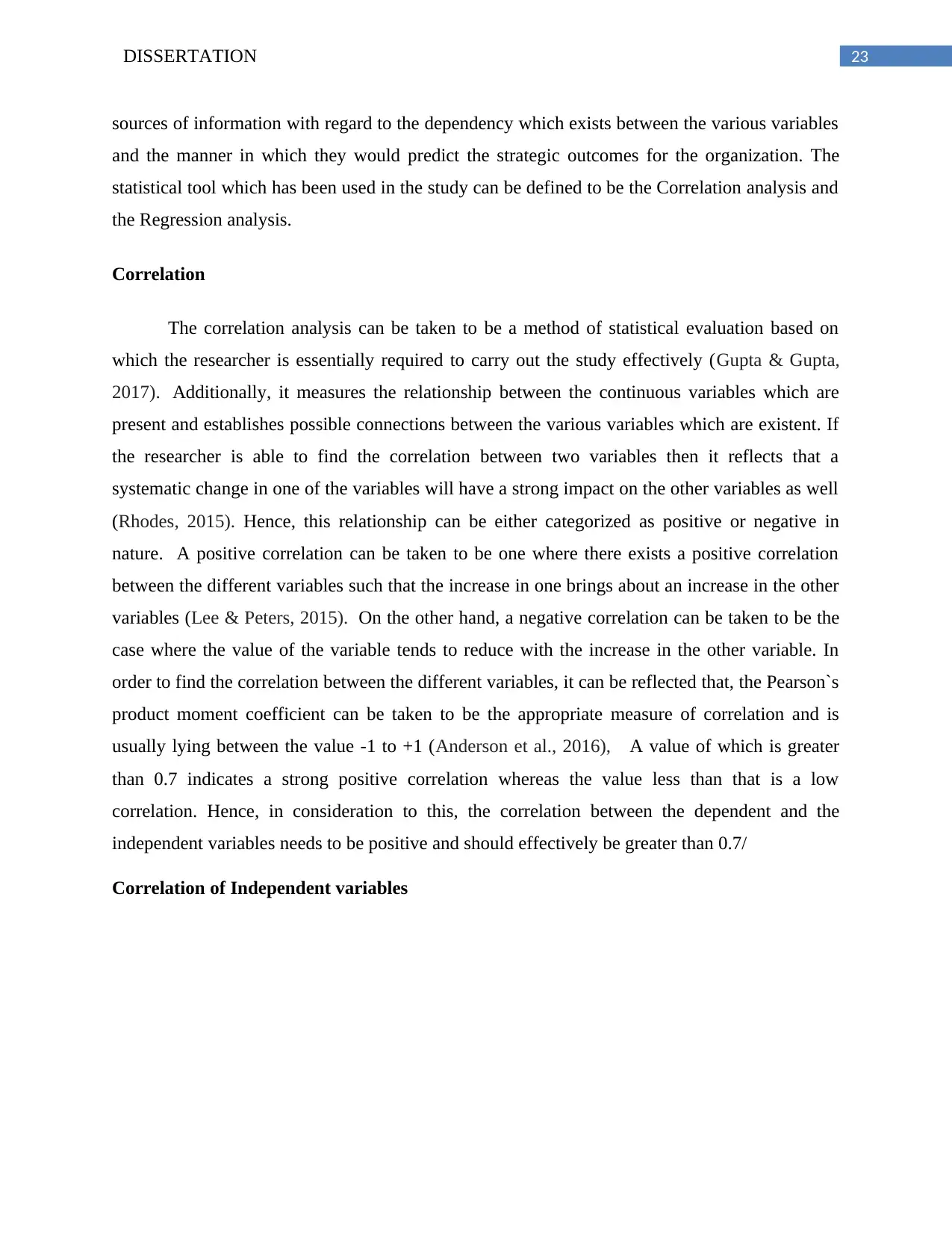
23DISSERTATION
sources of information with regard to the dependency which exists between the various variables
and the manner in which they would predict the strategic outcomes for the organization. The
statistical tool which has been used in the study can be defined to be the Correlation analysis and
the Regression analysis.
Correlation
The correlation analysis can be taken to be a method of statistical evaluation based on
which the researcher is essentially required to carry out the study effectively (Gupta & Gupta,
2017). Additionally, it measures the relationship between the continuous variables which are
present and establishes possible connections between the various variables which are existent. If
the researcher is able to find the correlation between two variables then it reflects that a
systematic change in one of the variables will have a strong impact on the other variables as well
(Rhodes, 2015). Hence, this relationship can be either categorized as positive or negative in
nature. A positive correlation can be taken to be one where there exists a positive correlation
between the different variables such that the increase in one brings about an increase in the other
variables (Lee & Peters, 2015). On the other hand, a negative correlation can be taken to be the
case where the value of the variable tends to reduce with the increase in the other variable. In
order to find the correlation between the different variables, it can be reflected that, the Pearson`s
product moment coefficient can be taken to be the appropriate measure of correlation and is
usually lying between the value -1 to +1 (Anderson et al., 2016), A value of which is greater
than 0.7 indicates a strong positive correlation whereas the value less than that is a low
correlation. Hence, in consideration to this, the correlation between the dependent and the
independent variables needs to be positive and should effectively be greater than 0.7/
Correlation of Independent variables
sources of information with regard to the dependency which exists between the various variables
and the manner in which they would predict the strategic outcomes for the organization. The
statistical tool which has been used in the study can be defined to be the Correlation analysis and
the Regression analysis.
Correlation
The correlation analysis can be taken to be a method of statistical evaluation based on
which the researcher is essentially required to carry out the study effectively (Gupta & Gupta,
2017). Additionally, it measures the relationship between the continuous variables which are
present and establishes possible connections between the various variables which are existent. If
the researcher is able to find the correlation between two variables then it reflects that a
systematic change in one of the variables will have a strong impact on the other variables as well
(Rhodes, 2015). Hence, this relationship can be either categorized as positive or negative in
nature. A positive correlation can be taken to be one where there exists a positive correlation
between the different variables such that the increase in one brings about an increase in the other
variables (Lee & Peters, 2015). On the other hand, a negative correlation can be taken to be the
case where the value of the variable tends to reduce with the increase in the other variable. In
order to find the correlation between the different variables, it can be reflected that, the Pearson`s
product moment coefficient can be taken to be the appropriate measure of correlation and is
usually lying between the value -1 to +1 (Anderson et al., 2016), A value of which is greater
than 0.7 indicates a strong positive correlation whereas the value less than that is a low
correlation. Hence, in consideration to this, the correlation between the dependent and the
independent variables needs to be positive and should effectively be greater than 0.7/
Correlation of Independent variables
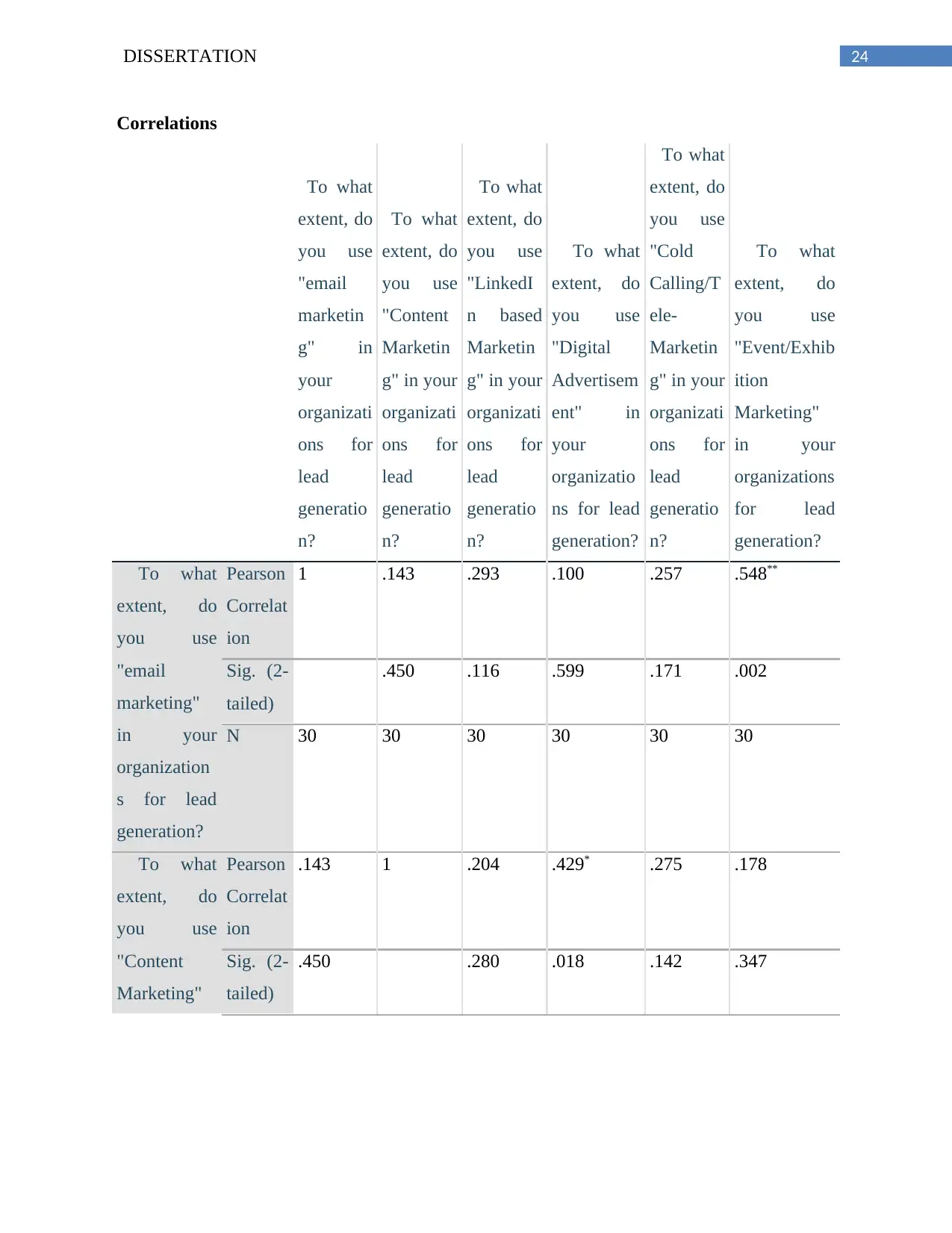
24DISSERTATION
Correlations
To what
extent, do
you use
"email
marketin
g" in
your
organizati
ons for
lead
generatio
n?
To what
extent, do
you use
"Content
Marketin
g" in your
organizati
ons for
lead
generatio
n?
To what
extent, do
you use
"LinkedI
n based
Marketin
g" in your
organizati
ons for
lead
generatio
n?
To what
extent, do
you use
"Digital
Advertisem
ent" in
your
organizatio
ns for lead
generation?
To what
extent, do
you use
"Cold
Calling/T
ele-
Marketin
g" in your
organizati
ons for
lead
generatio
n?
To what
extent, do
you use
"Event/Exhib
ition
Marketing"
in your
organizations
for lead
generation?
To what
extent, do
you use
"email
marketing"
in your
organization
s for lead
generation?
Pearson
Correlat
ion
1 .143 .293 .100 .257 .548**
Sig. (2-
tailed)
.450 .116 .599 .171 .002
N 30 30 30 30 30 30
To what
extent, do
you use
"Content
Marketing"
Pearson
Correlat
ion
.143 1 .204 .429* .275 .178
Sig. (2-
tailed)
.450 .280 .018 .142 .347
Correlations
To what
extent, do
you use
marketin
g" in
your
organizati
ons for
lead
generatio
n?
To what
extent, do
you use
"Content
Marketin
g" in your
organizati
ons for
lead
generatio
n?
To what
extent, do
you use
"LinkedI
n based
Marketin
g" in your
organizati
ons for
lead
generatio
n?
To what
extent, do
you use
"Digital
Advertisem
ent" in
your
organizatio
ns for lead
generation?
To what
extent, do
you use
"Cold
Calling/T
ele-
Marketin
g" in your
organizati
ons for
lead
generatio
n?
To what
extent, do
you use
"Event/Exhib
ition
Marketing"
in your
organizations
for lead
generation?
To what
extent, do
you use
marketing"
in your
organization
s for lead
generation?
Pearson
Correlat
ion
1 .143 .293 .100 .257 .548**
Sig. (2-
tailed)
.450 .116 .599 .171 .002
N 30 30 30 30 30 30
To what
extent, do
you use
"Content
Marketing"
Pearson
Correlat
ion
.143 1 .204 .429* .275 .178
Sig. (2-
tailed)
.450 .280 .018 .142 .347
Paraphrase This Document
Need a fresh take? Get an instant paraphrase of this document with our AI Paraphraser
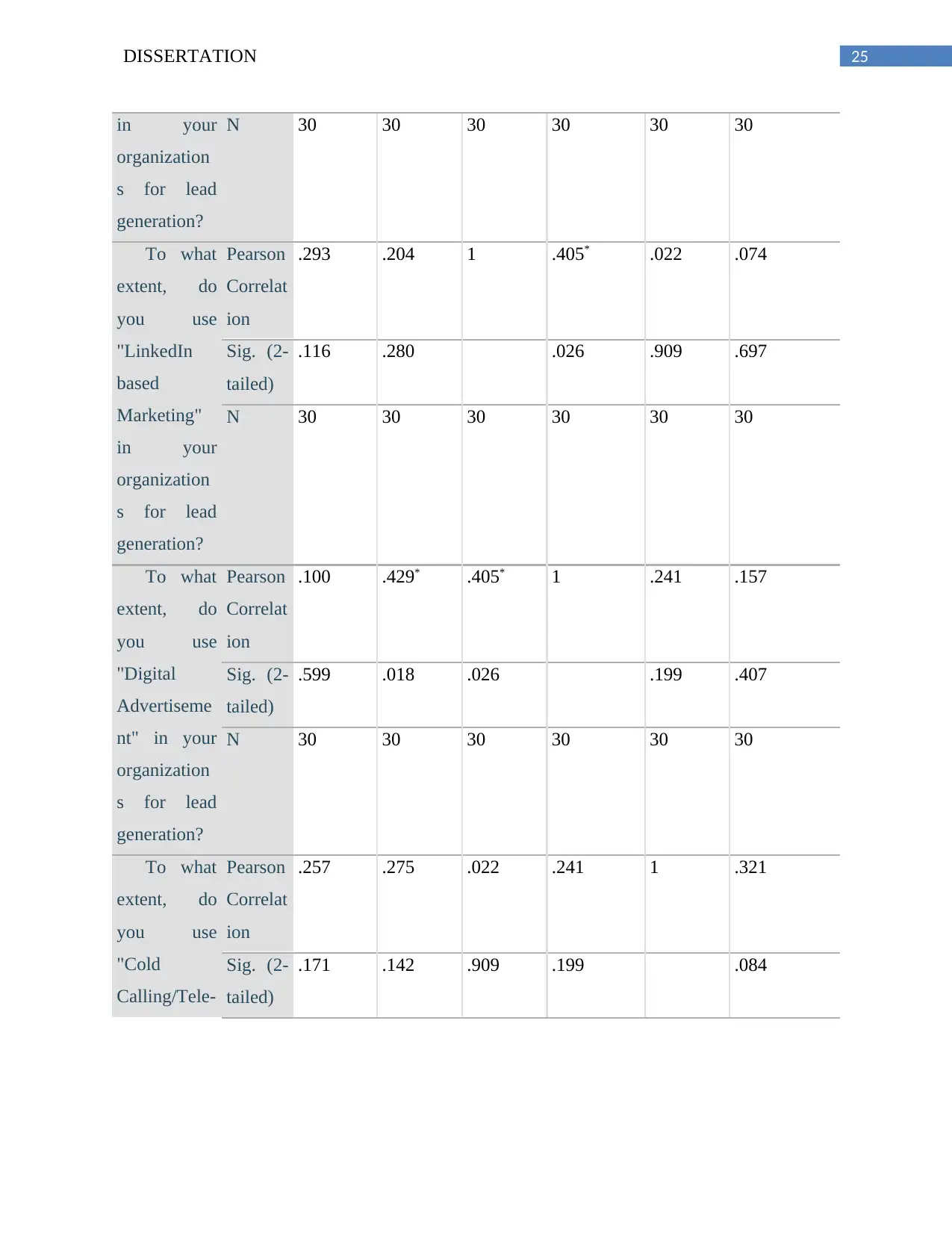
25DISSERTATION
in your
organization
s for lead
generation?
N 30 30 30 30 30 30
To what
extent, do
you use
"LinkedIn
based
Marketing"
in your
organization
s for lead
generation?
Pearson
Correlat
ion
.293 .204 1 .405* .022 .074
Sig. (2-
tailed)
.116 .280 .026 .909 .697
N 30 30 30 30 30 30
To what
extent, do
you use
"Digital
Advertiseme
nt" in your
organization
s for lead
generation?
Pearson
Correlat
ion
.100 .429* .405* 1 .241 .157
Sig. (2-
tailed)
.599 .018 .026 .199 .407
N 30 30 30 30 30 30
To what
extent, do
you use
"Cold
Calling/Tele-
Pearson
Correlat
ion
.257 .275 .022 .241 1 .321
Sig. (2-
tailed)
.171 .142 .909 .199 .084
in your
organization
s for lead
generation?
N 30 30 30 30 30 30
To what
extent, do
you use
based
Marketing"
in your
organization
s for lead
generation?
Pearson
Correlat
ion
.293 .204 1 .405* .022 .074
Sig. (2-
tailed)
.116 .280 .026 .909 .697
N 30 30 30 30 30 30
To what
extent, do
you use
"Digital
Advertiseme
nt" in your
organization
s for lead
generation?
Pearson
Correlat
ion
.100 .429* .405* 1 .241 .157
Sig. (2-
tailed)
.599 .018 .026 .199 .407
N 30 30 30 30 30 30
To what
extent, do
you use
"Cold
Calling/Tele-
Pearson
Correlat
ion
.257 .275 .022 .241 1 .321
Sig. (2-
tailed)
.171 .142 .909 .199 .084

26DISSERTATION
Marketing"
in your
organization
s for lead
generation?
N 30 30 30 30 30 30
To what
extent, do
you use
"Event/Exhi
bition
Marketing"
in your
organization
s for lead
generation?
Pearson
Correlat
ion
.548** .178 .074 .157 .321 1
Sig. (2-
tailed)
.002 .347 .697 .407 .084
N 30 30 30 30 30 30
**. Correlation is significant at the 0.01 level (2-tailed).
*. Correlation is significant at the 0.05 level (2-tailed).
From the table it can be reflected that the correlation between email marketing and the
event marketing can be taken to be the highest and the most positive in nature. At a value of
0.548, it can be rightfully reflected that, the firms which make use of the event marketing, often
make use of the email marketing. On the other hand, the value of the correlation between, the
LinkedIn and the telemarketing can be taken to be the lowest. In regard to this, it can be
rightfully assessed that, the companies making use of the LinkedIn marketing technique do not
make use of the telemarketing as a marketing activity.
Correlation of Dependable variables
Marketing"
in your
organization
s for lead
generation?
N 30 30 30 30 30 30
To what
extent, do
you use
"Event/Exhi
bition
Marketing"
in your
organization
s for lead
generation?
Pearson
Correlat
ion
.548** .178 .074 .157 .321 1
Sig. (2-
tailed)
.002 .347 .697 .407 .084
N 30 30 30 30 30 30
**. Correlation is significant at the 0.01 level (2-tailed).
*. Correlation is significant at the 0.05 level (2-tailed).
From the table it can be reflected that the correlation between email marketing and the
event marketing can be taken to be the highest and the most positive in nature. At a value of
0.548, it can be rightfully reflected that, the firms which make use of the event marketing, often
make use of the email marketing. On the other hand, the value of the correlation between, the
LinkedIn and the telemarketing can be taken to be the lowest. In regard to this, it can be
rightfully assessed that, the companies making use of the LinkedIn marketing technique do not
make use of the telemarketing as a marketing activity.
Correlation of Dependable variables
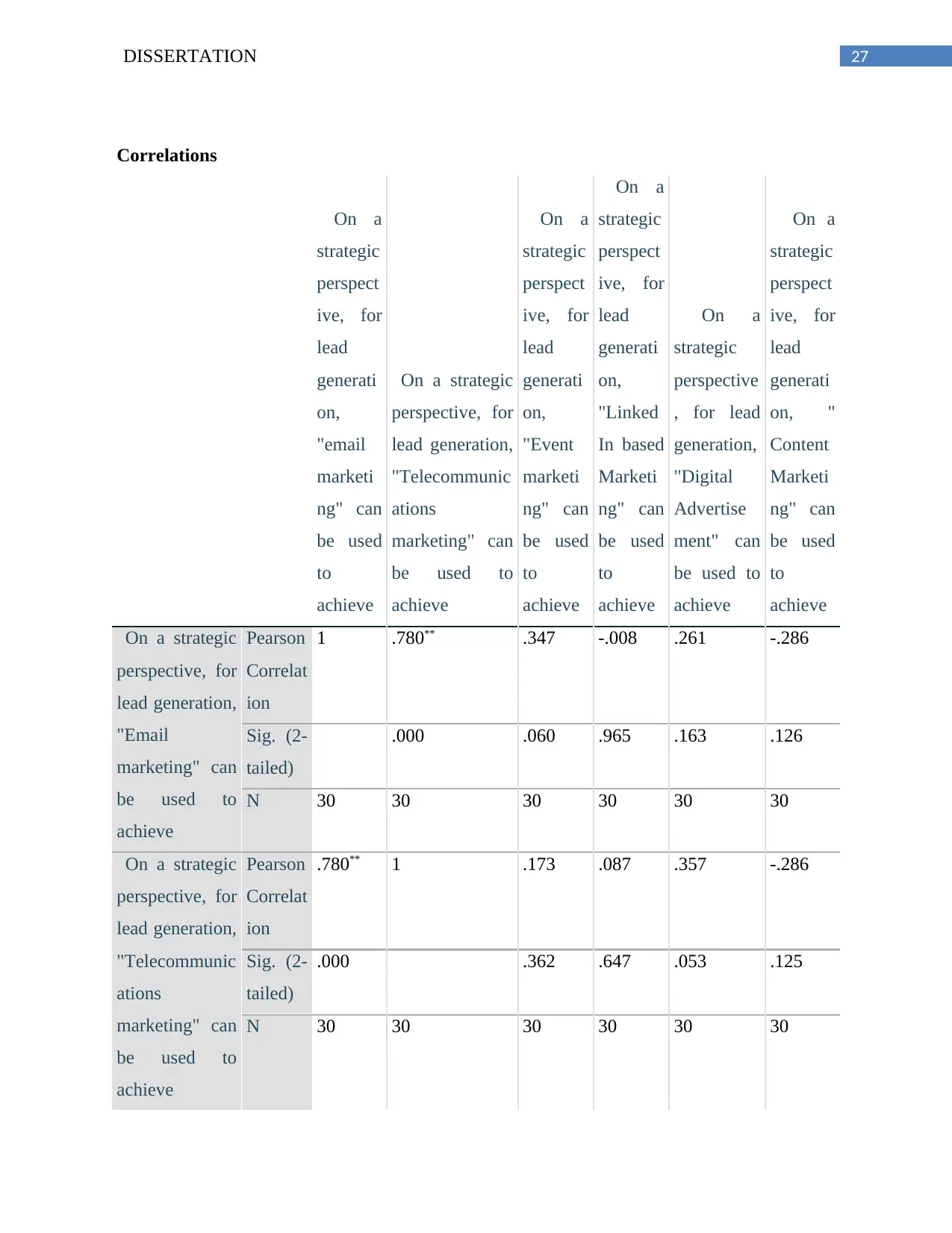
27DISSERTATION
Correlations
On a
strategic
perspect
ive, for
lead
generati
on,
"email
marketi
ng" can
be used
to
achieve
On a strategic
perspective, for
lead generation,
"Telecommunic
ations
marketing" can
be used to
achieve
On a
strategic
perspect
ive, for
lead
generati
on,
"Event
marketi
ng" can
be used
to
achieve
On a
strategic
perspect
ive, for
lead
generati
on,
"Linked
In based
Marketi
ng" can
be used
to
achieve
On a
strategic
perspective
, for lead
generation,
"Digital
Advertise
ment" can
be used to
achieve
On a
strategic
perspect
ive, for
lead
generati
on, "
Content
Marketi
ng" can
be used
to
achieve
On a strategic
perspective, for
lead generation,
"Email
marketing" can
be used to
achieve
Pearson
Correlat
ion
1 .780** .347 -.008 .261 -.286
Sig. (2-
tailed)
.000 .060 .965 .163 .126
N 30 30 30 30 30 30
On a strategic
perspective, for
lead generation,
"Telecommunic
ations
marketing" can
be used to
achieve
Pearson
Correlat
ion
.780** 1 .173 .087 .357 -.286
Sig. (2-
tailed)
.000 .362 .647 .053 .125
N 30 30 30 30 30 30
Correlations
On a
strategic
perspect
ive, for
lead
generati
on,
marketi
ng" can
be used
to
achieve
On a strategic
perspective, for
lead generation,
"Telecommunic
ations
marketing" can
be used to
achieve
On a
strategic
perspect
ive, for
lead
generati
on,
"Event
marketi
ng" can
be used
to
achieve
On a
strategic
perspect
ive, for
lead
generati
on,
"Linked
In based
Marketi
ng" can
be used
to
achieve
On a
strategic
perspective
, for lead
generation,
"Digital
Advertise
ment" can
be used to
achieve
On a
strategic
perspect
ive, for
lead
generati
on, "
Content
Marketi
ng" can
be used
to
achieve
On a strategic
perspective, for
lead generation,
marketing" can
be used to
achieve
Pearson
Correlat
ion
1 .780** .347 -.008 .261 -.286
Sig. (2-
tailed)
.000 .060 .965 .163 .126
N 30 30 30 30 30 30
On a strategic
perspective, for
lead generation,
"Telecommunic
ations
marketing" can
be used to
achieve
Pearson
Correlat
ion
.780** 1 .173 .087 .357 -.286
Sig. (2-
tailed)
.000 .362 .647 .053 .125
N 30 30 30 30 30 30
Secure Best Marks with AI Grader
Need help grading? Try our AI Grader for instant feedback on your assignments.

28DISSERTATION
On a strategic
perspective, for
lead generation,
"Event
marketing" can
be used to
achieve
Pearson
Correlat
ion
.347 .173 1 .405* -.254 -.078
Sig. (2-
tailed)
.060 .362 .027 .176 .681
N 30 30 30 30 30 30
On a strategic
perspective, for
lead generation,
"LinkedIn
based
Marketing" can
be used to
achieve
Pearson
Correlat
ion
-.008 .087 .405* 1 .227 .433*
Sig. (2-
tailed)
.965 .647 .027 .228 .017
N 30 30 30 30 30 30
On a strategic
perspective, for
lead generation,
"Digital
Advertisement"
can be used to
achieve
Pearson
Correlat
ion
.261 .357 -.254 .227 1 .290
Sig. (2-
tailed)
.163 .053 .176 .228 .120
N 30 30 30 30 30 30
On a strategic
perspective, for
lead generation,
" Content
Marketing" can
be used to
achieve
Pearson
Correlat
ion
-.286 -.286 -.078 .433* .290 1
Sig. (2-
tailed)
.126 .125 .681 .017 .120
N 30 30 30 30 30 30
**. Correlation is significant at the 0.01 level (2-tailed).
*. Correlation is significant at the 0.05 level (2-tailed).
On a strategic
perspective, for
lead generation,
"Event
marketing" can
be used to
achieve
Pearson
Correlat
ion
.347 .173 1 .405* -.254 -.078
Sig. (2-
tailed)
.060 .362 .027 .176 .681
N 30 30 30 30 30 30
On a strategic
perspective, for
lead generation,
based
Marketing" can
be used to
achieve
Pearson
Correlat
ion
-.008 .087 .405* 1 .227 .433*
Sig. (2-
tailed)
.965 .647 .027 .228 .017
N 30 30 30 30 30 30
On a strategic
perspective, for
lead generation,
"Digital
Advertisement"
can be used to
achieve
Pearson
Correlat
ion
.261 .357 -.254 .227 1 .290
Sig. (2-
tailed)
.163 .053 .176 .228 .120
N 30 30 30 30 30 30
On a strategic
perspective, for
lead generation,
" Content
Marketing" can
be used to
achieve
Pearson
Correlat
ion
-.286 -.286 -.078 .433* .290 1
Sig. (2-
tailed)
.126 .125 .681 .017 .120
N 30 30 30 30 30 30
**. Correlation is significant at the 0.01 level (2-tailed).
*. Correlation is significant at the 0.05 level (2-tailed).

29DISSERTATION
From the table, it can be mentioned that, the correlation between the telecommunications
and the Lead generation can be taken to be at 0.780. The correlation between content marketing
and the LinkedIn marketing can be taken to be considerably very high. However, the correlation
between LinkedIn and the email marketing is very poor. This indicates then in case the firm
intents to make use of more sources of marketing then in such a case, it is required to make use
of them in combinations such that they will be able to indulge in efficacious operations.
Regression Analysis
The regression analysis is a method of identifying the different variables which generally
have an impact on the dependent variable. In this study, the dependent variable is the overall lead
generation procedure and the Independent variables are the various tools which are general tools
which are used for generation of lead like the email marketing, content marketing, event
marketing, LinkedIn marketing and other such techniques are made use of (Durham & Blanco,
2015). The regression as a method supports in finding the direct impact which exists amongst
these variables and to establish a relationship between the variables. Hence, in this scenario, the
Regression analysis will aim to find the relationship which exists between the Lead generation
and the various tools which can be used for the aim of the lead generation.
Model Summary
Model R R Square
Adjusted R
Square
Std. Error of
the Estimate
1 .574a .330 .306 1.59797
a. Predictors: (Constant), IT
The given table named Model Summary provides the values of the correlation between
the dependent and the independent variable along with describing the manner in which, the
model is tryst worthy and fits well. The table describes that as the value of R in this case is 0.57
which means that the correlation between the Idea generation and the strategic implication for
From the table, it can be mentioned that, the correlation between the telecommunications
and the Lead generation can be taken to be at 0.780. The correlation between content marketing
and the LinkedIn marketing can be taken to be considerably very high. However, the correlation
between LinkedIn and the email marketing is very poor. This indicates then in case the firm
intents to make use of more sources of marketing then in such a case, it is required to make use
of them in combinations such that they will be able to indulge in efficacious operations.
Regression Analysis
The regression analysis is a method of identifying the different variables which generally
have an impact on the dependent variable. In this study, the dependent variable is the overall lead
generation procedure and the Independent variables are the various tools which are general tools
which are used for generation of lead like the email marketing, content marketing, event
marketing, LinkedIn marketing and other such techniques are made use of (Durham & Blanco,
2015). The regression as a method supports in finding the direct impact which exists amongst
these variables and to establish a relationship between the variables. Hence, in this scenario, the
Regression analysis will aim to find the relationship which exists between the Lead generation
and the various tools which can be used for the aim of the lead generation.
Model Summary
Model R R Square
Adjusted R
Square
Std. Error of
the Estimate
1 .574a .330 .306 1.59797
a. Predictors: (Constant), IT
The given table named Model Summary provides the values of the correlation between
the dependent and the independent variable along with describing the manner in which, the
model is tryst worthy and fits well. The table describes that as the value of R in this case is 0.57
which means that the correlation between the Idea generation and the strategic implication for

30DISSERTATION
the firm is positive and related. The value of R square depicts the explanatory power of
Regression equation and analysis so that the extent of the strategic implication can be understood
based on the choice of the lead generation tool. Here the explanatory power of the R square is
0.33 which means that the regression equation is able to explain 33% of the relationship between
the lead generation and the strategic implication for the organization. Moreover, as the difference
between the R square and the Adjusted R square is very low and therefore, this model can be
taken to be a good fit model.
Dependent variable: Lead Generation
Independent Variable: Information technology space like Email marketing, Content marketing
and others.
ANOVAa
Model
Sum of
Squares Df Mean Square F Sig.
1 Regression 35.177 1 35.177 13.776 .001b
Residual 71.498 28 2.553
Total 106.675 29
a. Dependent Variable: LeadGen
b. Predictors: (Constant), IT
The Anova table has the capability to define the manner in which the Hypothesis which
has been set out for the paper can be tested accordingly. Hence, in this case, it can be reflected
that the value of the Significant F is less than 0.05 which verifies that the Independent variable
has a very strong influence on the dependent variable. Moreover, this also forms the basis for the
testing of the hypothesis.
Coefficients
Model
Unstandardized
Coefficients
Standardized
Coefficients
t Sig.B Std. Error Beta
the firm is positive and related. The value of R square depicts the explanatory power of
Regression equation and analysis so that the extent of the strategic implication can be understood
based on the choice of the lead generation tool. Here the explanatory power of the R square is
0.33 which means that the regression equation is able to explain 33% of the relationship between
the lead generation and the strategic implication for the organization. Moreover, as the difference
between the R square and the Adjusted R square is very low and therefore, this model can be
taken to be a good fit model.
Dependent variable: Lead Generation
Independent Variable: Information technology space like Email marketing, Content marketing
and others.
ANOVAa
Model
Sum of
Squares Df Mean Square F Sig.
1 Regression 35.177 1 35.177 13.776 .001b
Residual 71.498 28 2.553
Total 106.675 29
a. Dependent Variable: LeadGen
b. Predictors: (Constant), IT
The Anova table has the capability to define the manner in which the Hypothesis which
has been set out for the paper can be tested accordingly. Hence, in this case, it can be reflected
that the value of the Significant F is less than 0.05 which verifies that the Independent variable
has a very strong influence on the dependent variable. Moreover, this also forms the basis for the
testing of the hypothesis.
Coefficients
Model
Unstandardized
Coefficients
Standardized
Coefficients
t Sig.B Std. Error Beta
Paraphrase This Document
Need a fresh take? Get an instant paraphrase of this document with our AI Paraphraser

31DISSERTATION
1 (Constant) 3.275 .777 4.213 .000
IT .478 .129 .574 3.712 .001
a. Dependent Variable: LeadGen
This table provides the regression equation of the independent and the dependent
variables.
4.5 Hypothesis
The hypothesis which had been set down for the paper can be mentioned to be as follows:
Null Hypothesis (H0): The Informational technology space does not have a strong impact on the
Lead Generation of the organizations.
Alternate Hypothesis (H1): The Informational technology space has a strong impact on the Lead
Generation of the organizations.
Therefore, as the value of the Significant F can be taken to be below 0.05 therefore, in
such a scenario, the Null hypothesis has been rejected and the Alternate Hypothesis has been
accepted which verifies the relationship which exists between the Lead Generation and various
marketing techniques.
4.6 Findings
The findings of the paper can be stated to be as follows:
1. The respondents which were selected assisted in comprehending the way in which the
different tools of lead generation are chosen by the various organizations and the
individuals in order to derive the relationship which tends to exist between organizational
favorable outcome and the overall tools used for the analysis.
2. A majority of the various employees responded that they made use of the technique of
email marketing, LinkedIn marketing and the event marketing in order to indulge in the
marketing of the firms which thereby supports them in generating the right kind of leads
(Holenz & Stoy, 2018).
1 (Constant) 3.275 .777 4.213 .000
IT .478 .129 .574 3.712 .001
a. Dependent Variable: LeadGen
This table provides the regression equation of the independent and the dependent
variables.
4.5 Hypothesis
The hypothesis which had been set down for the paper can be mentioned to be as follows:
Null Hypothesis (H0): The Informational technology space does not have a strong impact on the
Lead Generation of the organizations.
Alternate Hypothesis (H1): The Informational technology space has a strong impact on the Lead
Generation of the organizations.
Therefore, as the value of the Significant F can be taken to be below 0.05 therefore, in
such a scenario, the Null hypothesis has been rejected and the Alternate Hypothesis has been
accepted which verifies the relationship which exists between the Lead Generation and various
marketing techniques.
4.6 Findings
The findings of the paper can be stated to be as follows:
1. The respondents which were selected assisted in comprehending the way in which the
different tools of lead generation are chosen by the various organizations and the
individuals in order to derive the relationship which tends to exist between organizational
favorable outcome and the overall tools used for the analysis.
2. A majority of the various employees responded that they made use of the technique of
email marketing, LinkedIn marketing and the event marketing in order to indulge in the
marketing of the firms which thereby supports them in generating the right kind of leads
(Holenz & Stoy, 2018).
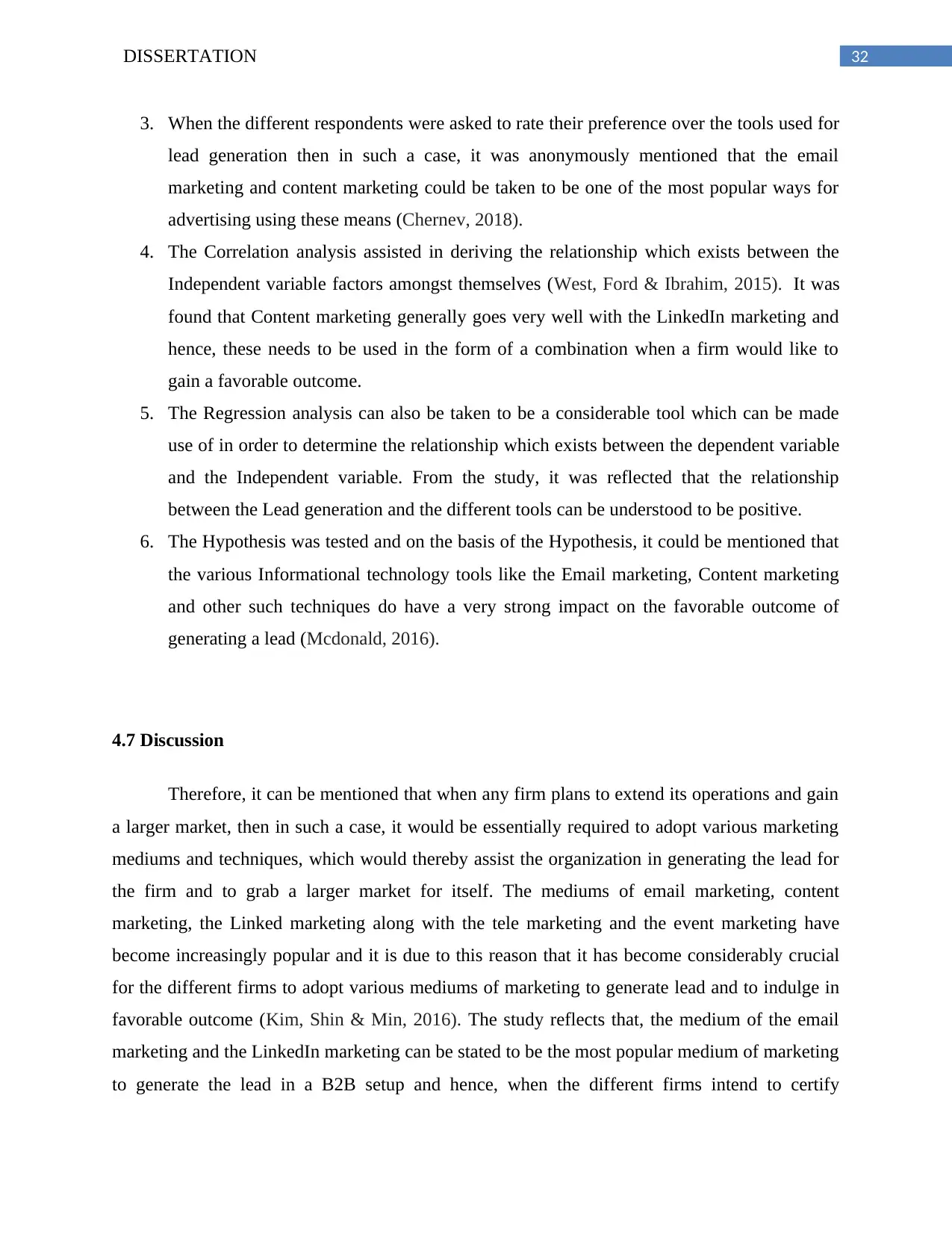
32DISSERTATION
3. When the different respondents were asked to rate their preference over the tools used for
lead generation then in such a case, it was anonymously mentioned that the email
marketing and content marketing could be taken to be one of the most popular ways for
advertising using these means (Chernev, 2018).
4. The Correlation analysis assisted in deriving the relationship which exists between the
Independent variable factors amongst themselves (West, Ford & Ibrahim, 2015). It was
found that Content marketing generally goes very well with the LinkedIn marketing and
hence, these needs to be used in the form of a combination when a firm would like to
gain a favorable outcome.
5. The Regression analysis can also be taken to be a considerable tool which can be made
use of in order to determine the relationship which exists between the dependent variable
and the Independent variable. From the study, it was reflected that the relationship
between the Lead generation and the different tools can be understood to be positive.
6. The Hypothesis was tested and on the basis of the Hypothesis, it could be mentioned that
the various Informational technology tools like the Email marketing, Content marketing
and other such techniques do have a very strong impact on the favorable outcome of
generating a lead (Mcdonald, 2016).
4.7 Discussion
Therefore, it can be mentioned that when any firm plans to extend its operations and gain
a larger market, then in such a case, it would be essentially required to adopt various marketing
mediums and techniques, which would thereby assist the organization in generating the lead for
the firm and to grab a larger market for itself. The mediums of email marketing, content
marketing, the Linked marketing along with the tele marketing and the event marketing have
become increasingly popular and it is due to this reason that it has become considerably crucial
for the different firms to adopt various mediums of marketing to generate lead and to indulge in
favorable outcome (Kim, Shin & Min, 2016). The study reflects that, the medium of the email
marketing and the LinkedIn marketing can be stated to be the most popular medium of marketing
to generate the lead in a B2B setup and hence, when the different firms intend to certify
3. When the different respondents were asked to rate their preference over the tools used for
lead generation then in such a case, it was anonymously mentioned that the email
marketing and content marketing could be taken to be one of the most popular ways for
advertising using these means (Chernev, 2018).
4. The Correlation analysis assisted in deriving the relationship which exists between the
Independent variable factors amongst themselves (West, Ford & Ibrahim, 2015). It was
found that Content marketing generally goes very well with the LinkedIn marketing and
hence, these needs to be used in the form of a combination when a firm would like to
gain a favorable outcome.
5. The Regression analysis can also be taken to be a considerable tool which can be made
use of in order to determine the relationship which exists between the dependent variable
and the Independent variable. From the study, it was reflected that the relationship
between the Lead generation and the different tools can be understood to be positive.
6. The Hypothesis was tested and on the basis of the Hypothesis, it could be mentioned that
the various Informational technology tools like the Email marketing, Content marketing
and other such techniques do have a very strong impact on the favorable outcome of
generating a lead (Mcdonald, 2016).
4.7 Discussion
Therefore, it can be mentioned that when any firm plans to extend its operations and gain
a larger market, then in such a case, it would be essentially required to adopt various marketing
mediums and techniques, which would thereby assist the organization in generating the lead for
the firm and to grab a larger market for itself. The mediums of email marketing, content
marketing, the Linked marketing along with the tele marketing and the event marketing have
become increasingly popular and it is due to this reason that it has become considerably crucial
for the different firms to adopt various mediums of marketing to generate lead and to indulge in
favorable outcome (Kim, Shin & Min, 2016). The study reflects that, the medium of the email
marketing and the LinkedIn marketing can be stated to be the most popular medium of marketing
to generate the lead in a B2B setup and hence, when the different firms intend to certify
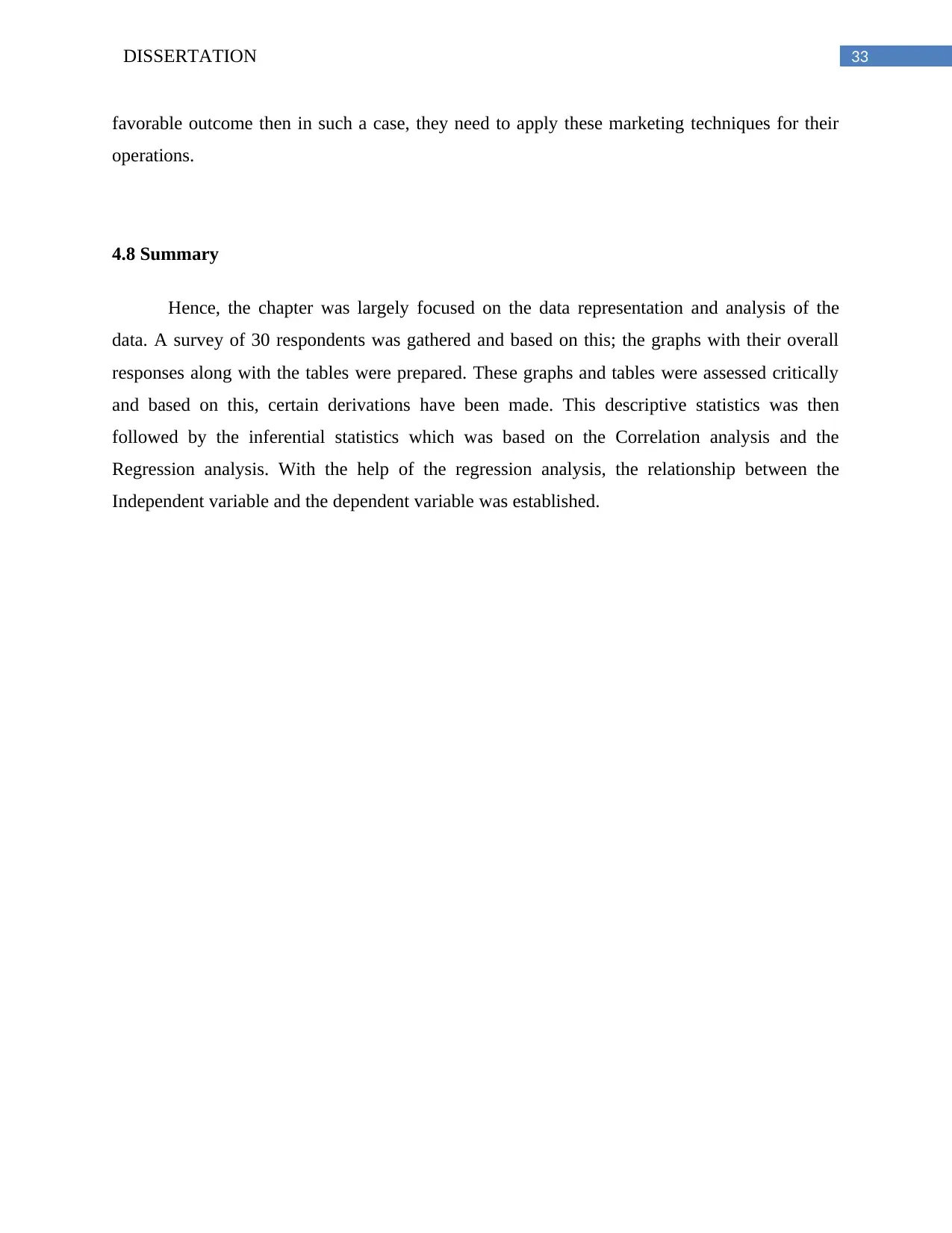
33DISSERTATION
favorable outcome then in such a case, they need to apply these marketing techniques for their
operations.
4.8 Summary
Hence, the chapter was largely focused on the data representation and analysis of the
data. A survey of 30 respondents was gathered and based on this; the graphs with their overall
responses along with the tables were prepared. These graphs and tables were assessed critically
and based on this, certain derivations have been made. This descriptive statistics was then
followed by the inferential statistics which was based on the Correlation analysis and the
Regression analysis. With the help of the regression analysis, the relationship between the
Independent variable and the dependent variable was established.
favorable outcome then in such a case, they need to apply these marketing techniques for their
operations.
4.8 Summary
Hence, the chapter was largely focused on the data representation and analysis of the
data. A survey of 30 respondents was gathered and based on this; the graphs with their overall
responses along with the tables were prepared. These graphs and tables were assessed critically
and based on this, certain derivations have been made. This descriptive statistics was then
followed by the inferential statistics which was based on the Correlation analysis and the
Regression analysis. With the help of the regression analysis, the relationship between the
Independent variable and the dependent variable was established.
Secure Best Marks with AI Grader
Need help grading? Try our AI Grader for instant feedback on your assignments.
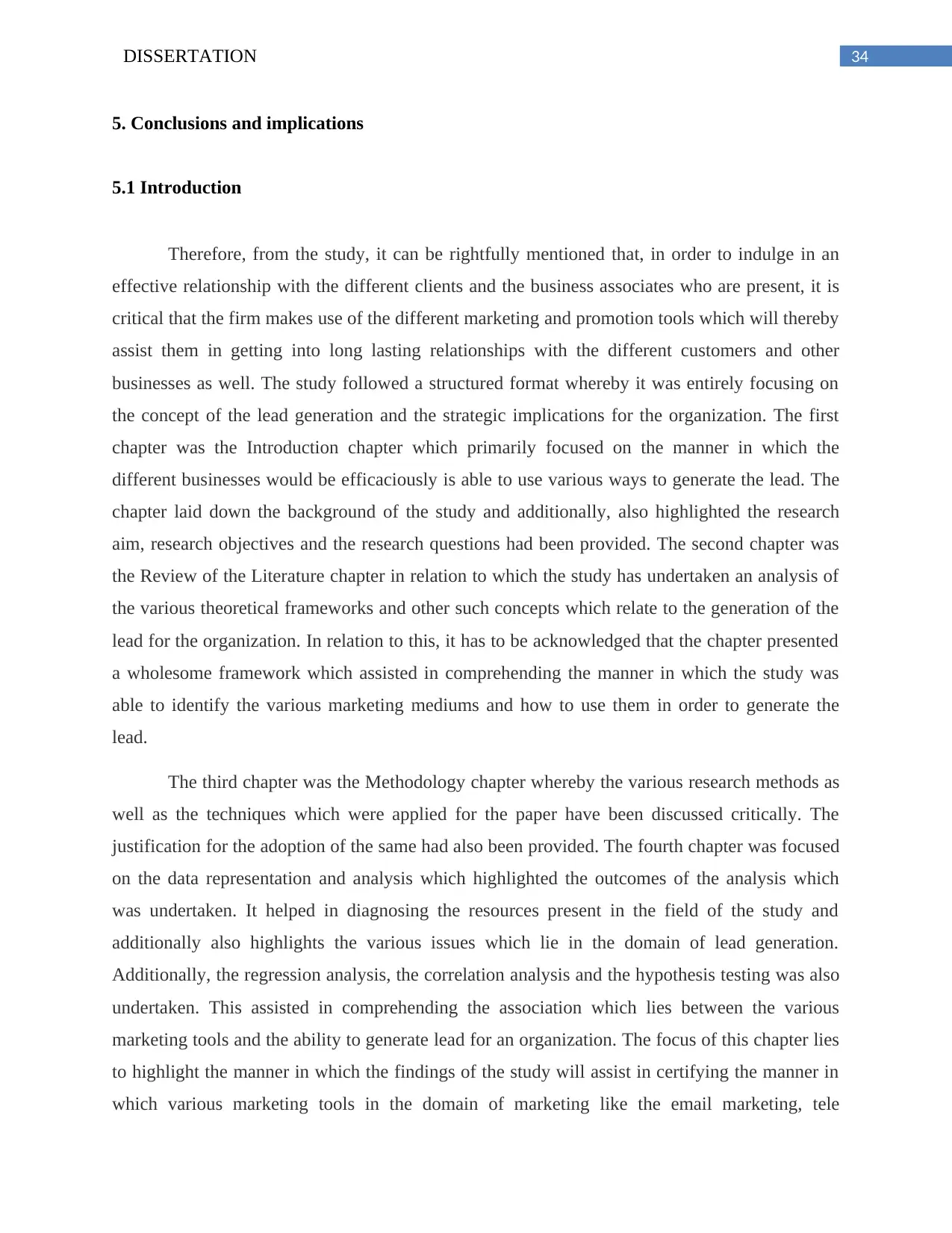
34DISSERTATION
5. Conclusions and implications
5.1 Introduction
Therefore, from the study, it can be rightfully mentioned that, in order to indulge in an
effective relationship with the different clients and the business associates who are present, it is
critical that the firm makes use of the different marketing and promotion tools which will thereby
assist them in getting into long lasting relationships with the different customers and other
businesses as well. The study followed a structured format whereby it was entirely focusing on
the concept of the lead generation and the strategic implications for the organization. The first
chapter was the Introduction chapter which primarily focused on the manner in which the
different businesses would be efficaciously is able to use various ways to generate the lead. The
chapter laid down the background of the study and additionally, also highlighted the research
aim, research objectives and the research questions had been provided. The second chapter was
the Review of the Literature chapter in relation to which the study has undertaken an analysis of
the various theoretical frameworks and other such concepts which relate to the generation of the
lead for the organization. In relation to this, it has to be acknowledged that the chapter presented
a wholesome framework which assisted in comprehending the manner in which the study was
able to identify the various marketing mediums and how to use them in order to generate the
lead.
The third chapter was the Methodology chapter whereby the various research methods as
well as the techniques which were applied for the paper have been discussed critically. The
justification for the adoption of the same had also been provided. The fourth chapter was focused
on the data representation and analysis which highlighted the outcomes of the analysis which
was undertaken. It helped in diagnosing the resources present in the field of the study and
additionally also highlights the various issues which lie in the domain of lead generation.
Additionally, the regression analysis, the correlation analysis and the hypothesis testing was also
undertaken. This assisted in comprehending the association which lies between the various
marketing tools and the ability to generate lead for an organization. The focus of this chapter lies
to highlight the manner in which the findings of the study will assist in certifying the manner in
which various marketing tools in the domain of marketing like the email marketing, tele
5. Conclusions and implications
5.1 Introduction
Therefore, from the study, it can be rightfully mentioned that, in order to indulge in an
effective relationship with the different clients and the business associates who are present, it is
critical that the firm makes use of the different marketing and promotion tools which will thereby
assist them in getting into long lasting relationships with the different customers and other
businesses as well. The study followed a structured format whereby it was entirely focusing on
the concept of the lead generation and the strategic implications for the organization. The first
chapter was the Introduction chapter which primarily focused on the manner in which the
different businesses would be efficaciously is able to use various ways to generate the lead. The
chapter laid down the background of the study and additionally, also highlighted the research
aim, research objectives and the research questions had been provided. The second chapter was
the Review of the Literature chapter in relation to which the study has undertaken an analysis of
the various theoretical frameworks and other such concepts which relate to the generation of the
lead for the organization. In relation to this, it has to be acknowledged that the chapter presented
a wholesome framework which assisted in comprehending the manner in which the study was
able to identify the various marketing mediums and how to use them in order to generate the
lead.
The third chapter was the Methodology chapter whereby the various research methods as
well as the techniques which were applied for the paper have been discussed critically. The
justification for the adoption of the same had also been provided. The fourth chapter was focused
on the data representation and analysis which highlighted the outcomes of the analysis which
was undertaken. It helped in diagnosing the resources present in the field of the study and
additionally also highlights the various issues which lie in the domain of lead generation.
Additionally, the regression analysis, the correlation analysis and the hypothesis testing was also
undertaken. This assisted in comprehending the association which lies between the various
marketing tools and the ability to generate lead for an organization. The focus of this chapter lies
to highlight the manner in which the findings of the study will assist in certifying the manner in
which various marketing tools in the domain of marketing like the email marketing, tele

35DISSERTATION
marketing and other such mediums will thereby assist in generating lead for the different B2B
business operations. Furthermore, the implications relating to the theoretical aspects along with
the practical implications relating to the theory will also be highlighted.
;
5.2 Conclusions about each research issue or proposition
The study was essentially based on certain research objectives. Hence, in this section the
conclusion based on the research objectives will be essentially elaborated. Additionally,
implications for the same shall also be discussed accordingly. The various research objectives
which had been set down for the research can be stated to be as follows:
1. To identify the current marketing structure used for lead generation; what is mostly used by
companies?
2. Comprehend what works best in industry and which tool gives maximum returns
3. Comprehend the strategic choice of tools for short term and long term goals for lead
generation
4. Comprehend usability of the provided lead generation framework in the industry
To identify the current marketing structure used for lead generation; what is mostly used by
companies?
The lead generation is an effective technique for generating sales which is adopted by various
organizations who re involved in the business. Relating to this, the different organizations would
be essentially required to make use of the procedure of marketing which would thereby assist the
firm in reaching out to the different customers. Moreover, it shall also allow the various users of
the marketing tool to see to it that they will be able to make use of the right tool so that their
marketing objectives can be fulfilled accordingly. Hence, it was found during the survey that
from the large variety of tools which are generally available for the different business units and
the businesses generally make use of the various tools like the email marketing, the linked in
marketing tool and the different tools like the telecommunication in order to generate the leads
marketing and other such mediums will thereby assist in generating lead for the different B2B
business operations. Furthermore, the implications relating to the theoretical aspects along with
the practical implications relating to the theory will also be highlighted.
;
5.2 Conclusions about each research issue or proposition
The study was essentially based on certain research objectives. Hence, in this section the
conclusion based on the research objectives will be essentially elaborated. Additionally,
implications for the same shall also be discussed accordingly. The various research objectives
which had been set down for the research can be stated to be as follows:
1. To identify the current marketing structure used for lead generation; what is mostly used by
companies?
2. Comprehend what works best in industry and which tool gives maximum returns
3. Comprehend the strategic choice of tools for short term and long term goals for lead
generation
4. Comprehend usability of the provided lead generation framework in the industry
To identify the current marketing structure used for lead generation; what is mostly used by
companies?
The lead generation is an effective technique for generating sales which is adopted by various
organizations who re involved in the business. Relating to this, the different organizations would
be essentially required to make use of the procedure of marketing which would thereby assist the
firm in reaching out to the different customers. Moreover, it shall also allow the various users of
the marketing tool to see to it that they will be able to make use of the right tool so that their
marketing objectives can be fulfilled accordingly. Hence, it was found during the survey that
from the large variety of tools which are generally available for the different business units and
the businesses generally make use of the various tools like the email marketing, the linked in
marketing tool and the different tools like the telecommunication in order to generate the leads
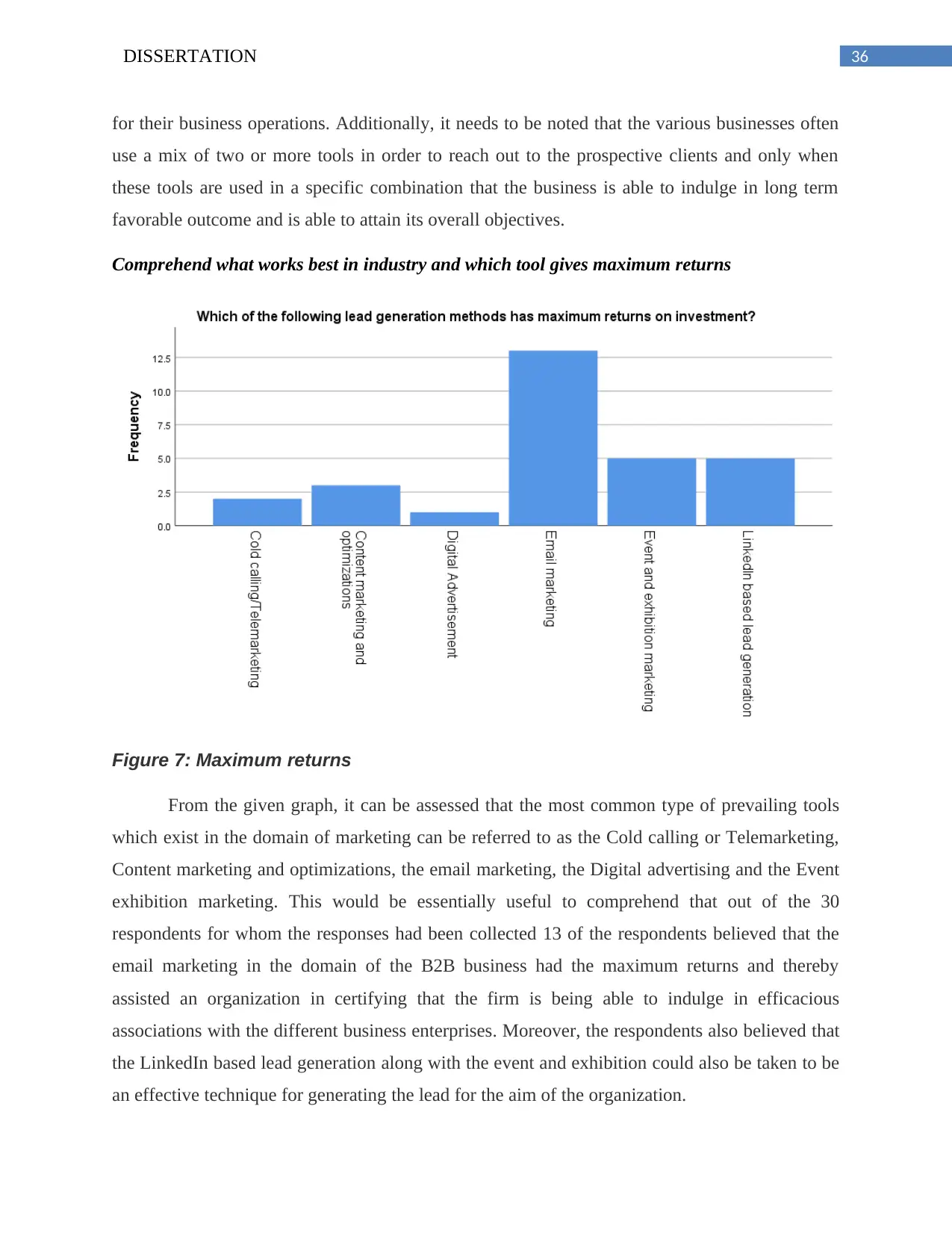
36DISSERTATION
for their business operations. Additionally, it needs to be noted that the various businesses often
use a mix of two or more tools in order to reach out to the prospective clients and only when
these tools are used in a specific combination that the business is able to indulge in long term
favorable outcome and is able to attain its overall objectives.
Comprehend what works best in industry and which tool gives maximum returns
Figure 7: Maximum returns
From the given graph, it can be assessed that the most common type of prevailing tools
which exist in the domain of marketing can be referred to as the Cold calling or Telemarketing,
Content marketing and optimizations, the email marketing, the Digital advertising and the Event
exhibition marketing. This would be essentially useful to comprehend that out of the 30
respondents for whom the responses had been collected 13 of the respondents believed that the
email marketing in the domain of the B2B business had the maximum returns and thereby
assisted an organization in certifying that the firm is being able to indulge in efficacious
associations with the different business enterprises. Moreover, the respondents also believed that
the LinkedIn based lead generation along with the event and exhibition could also be taken to be
an effective technique for generating the lead for the aim of the organization.
for their business operations. Additionally, it needs to be noted that the various businesses often
use a mix of two or more tools in order to reach out to the prospective clients and only when
these tools are used in a specific combination that the business is able to indulge in long term
favorable outcome and is able to attain its overall objectives.
Comprehend what works best in industry and which tool gives maximum returns
Figure 7: Maximum returns
From the given graph, it can be assessed that the most common type of prevailing tools
which exist in the domain of marketing can be referred to as the Cold calling or Telemarketing,
Content marketing and optimizations, the email marketing, the Digital advertising and the Event
exhibition marketing. This would be essentially useful to comprehend that out of the 30
respondents for whom the responses had been collected 13 of the respondents believed that the
email marketing in the domain of the B2B business had the maximum returns and thereby
assisted an organization in certifying that the firm is being able to indulge in efficacious
associations with the different business enterprises. Moreover, the respondents also believed that
the LinkedIn based lead generation along with the event and exhibition could also be taken to be
an effective technique for generating the lead for the aim of the organization.
Paraphrase This Document
Need a fresh take? Get an instant paraphrase of this document with our AI Paraphraser
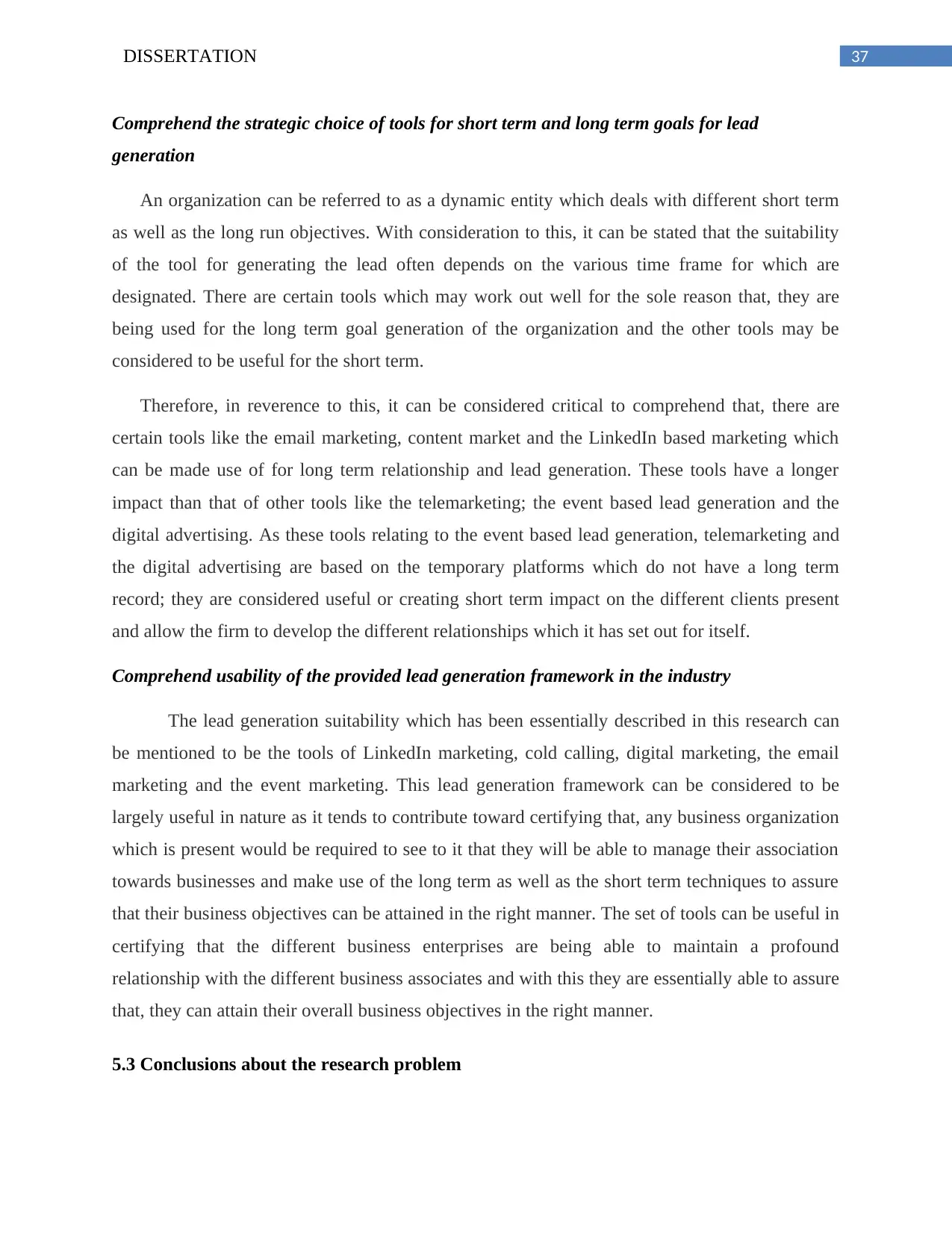
37DISSERTATION
Comprehend the strategic choice of tools for short term and long term goals for lead
generation
An organization can be referred to as a dynamic entity which deals with different short term
as well as the long run objectives. With consideration to this, it can be stated that the suitability
of the tool for generating the lead often depends on the various time frame for which are
designated. There are certain tools which may work out well for the sole reason that, they are
being used for the long term goal generation of the organization and the other tools may be
considered to be useful for the short term.
Therefore, in reverence to this, it can be considered critical to comprehend that, there are
certain tools like the email marketing, content market and the LinkedIn based marketing which
can be made use of for long term relationship and lead generation. These tools have a longer
impact than that of other tools like the telemarketing; the event based lead generation and the
digital advertising. As these tools relating to the event based lead generation, telemarketing and
the digital advertising are based on the temporary platforms which do not have a long term
record; they are considered useful or creating short term impact on the different clients present
and allow the firm to develop the different relationships which it has set out for itself.
Comprehend usability of the provided lead generation framework in the industry
The lead generation suitability which has been essentially described in this research can
be mentioned to be the tools of LinkedIn marketing, cold calling, digital marketing, the email
marketing and the event marketing. This lead generation framework can be considered to be
largely useful in nature as it tends to contribute toward certifying that, any business organization
which is present would be required to see to it that they will be able to manage their association
towards businesses and make use of the long term as well as the short term techniques to assure
that their business objectives can be attained in the right manner. The set of tools can be useful in
certifying that the different business enterprises are being able to maintain a profound
relationship with the different business associates and with this they are essentially able to assure
that, they can attain their overall business objectives in the right manner.
5.3 Conclusions about the research problem
Comprehend the strategic choice of tools for short term and long term goals for lead
generation
An organization can be referred to as a dynamic entity which deals with different short term
as well as the long run objectives. With consideration to this, it can be stated that the suitability
of the tool for generating the lead often depends on the various time frame for which are
designated. There are certain tools which may work out well for the sole reason that, they are
being used for the long term goal generation of the organization and the other tools may be
considered to be useful for the short term.
Therefore, in reverence to this, it can be considered critical to comprehend that, there are
certain tools like the email marketing, content market and the LinkedIn based marketing which
can be made use of for long term relationship and lead generation. These tools have a longer
impact than that of other tools like the telemarketing; the event based lead generation and the
digital advertising. As these tools relating to the event based lead generation, telemarketing and
the digital advertising are based on the temporary platforms which do not have a long term
record; they are considered useful or creating short term impact on the different clients present
and allow the firm to develop the different relationships which it has set out for itself.
Comprehend usability of the provided lead generation framework in the industry
The lead generation suitability which has been essentially described in this research can
be mentioned to be the tools of LinkedIn marketing, cold calling, digital marketing, the email
marketing and the event marketing. This lead generation framework can be considered to be
largely useful in nature as it tends to contribute toward certifying that, any business organization
which is present would be required to see to it that they will be able to manage their association
towards businesses and make use of the long term as well as the short term techniques to assure
that their business objectives can be attained in the right manner. The set of tools can be useful in
certifying that the different business enterprises are being able to maintain a profound
relationship with the different business associates and with this they are essentially able to assure
that, they can attain their overall business objectives in the right manner.
5.3 Conclusions about the research problem

38DISSERTATION
The research problem which had been set down for the paper can be essentially identified
as the manner in which the organization would be able to generate the lead in the Information
technology space. Considering this aspect, the study was essentially focused on the B2B
marketing implications only and with consideration to this, the study aimed to highlight the
manner in which the tools can be used in various combinations which will thereby be able to
assure that the firm is essentially able to gain favorable outcome in the long run. Hence, from the
study it was comprehended that, for lead generation, the use of a variety of tools can be
considered to be essentially useful for the business. In regard to this, it can also be mentioned
that the domains of email marketing, LinkedIn markets and the event marketing can be
considered to be useful and supports in determining the ways in which the business will be able
to indulge in efficacious relationships in the long run. Hence, this study was able to highlight the
manner in which the tools can be utilized for the best use of the business and how this can further
be used to gain a competitive marketing position.
5.4 Implications for theory
Hence, in this study, the different theoretical aspects which were assessed and highlighted
can be referred as to the theory which is essentially related to the generation of the lead for a
business and the use of different marketing tools which can be made use of to generate
relationships with the different client bases important to the organization. The concept of lead
generation can be mentioned to be the manner in which the business organizations aim to build
sufficient contact with the various enterprises and the ways in which the firm will be able to
indulge in efficacious relationships with the various suppliers as well as the customers present in
the domain of the firm (Miles et al., 2015). Additionally, the generation of lead supports the firm
in gaining higher revenues. However, the study indicated that the generation of the lead for the
aim of the firm is not an easy task and in case the firm aims to generate lead then they will be
required to make use of effective marketing techniques with the help of which they will
essentially be able to induce the various client and suppliers to get into a long term association
with the business enterprises.
The framework for the lead generation which was assessed in the study can be related to
the email marketing (Hughes et al., 2019). The email marketing can be mentioned to be an
The research problem which had been set down for the paper can be essentially identified
as the manner in which the organization would be able to generate the lead in the Information
technology space. Considering this aspect, the study was essentially focused on the B2B
marketing implications only and with consideration to this, the study aimed to highlight the
manner in which the tools can be used in various combinations which will thereby be able to
assure that the firm is essentially able to gain favorable outcome in the long run. Hence, from the
study it was comprehended that, for lead generation, the use of a variety of tools can be
considered to be essentially useful for the business. In regard to this, it can also be mentioned
that the domains of email marketing, LinkedIn markets and the event marketing can be
considered to be useful and supports in determining the ways in which the business will be able
to indulge in efficacious relationships in the long run. Hence, this study was able to highlight the
manner in which the tools can be utilized for the best use of the business and how this can further
be used to gain a competitive marketing position.
5.4 Implications for theory
Hence, in this study, the different theoretical aspects which were assessed and highlighted
can be referred as to the theory which is essentially related to the generation of the lead for a
business and the use of different marketing tools which can be made use of to generate
relationships with the different client bases important to the organization. The concept of lead
generation can be mentioned to be the manner in which the business organizations aim to build
sufficient contact with the various enterprises and the ways in which the firm will be able to
indulge in efficacious relationships with the various suppliers as well as the customers present in
the domain of the firm (Miles et al., 2015). Additionally, the generation of lead supports the firm
in gaining higher revenues. However, the study indicated that the generation of the lead for the
aim of the firm is not an easy task and in case the firm aims to generate lead then they will be
required to make use of effective marketing techniques with the help of which they will
essentially be able to induce the various client and suppliers to get into a long term association
with the business enterprises.
The framework for the lead generation which was assessed in the study can be related to
the email marketing (Hughes et al., 2019). The email marketing can be mentioned to be an
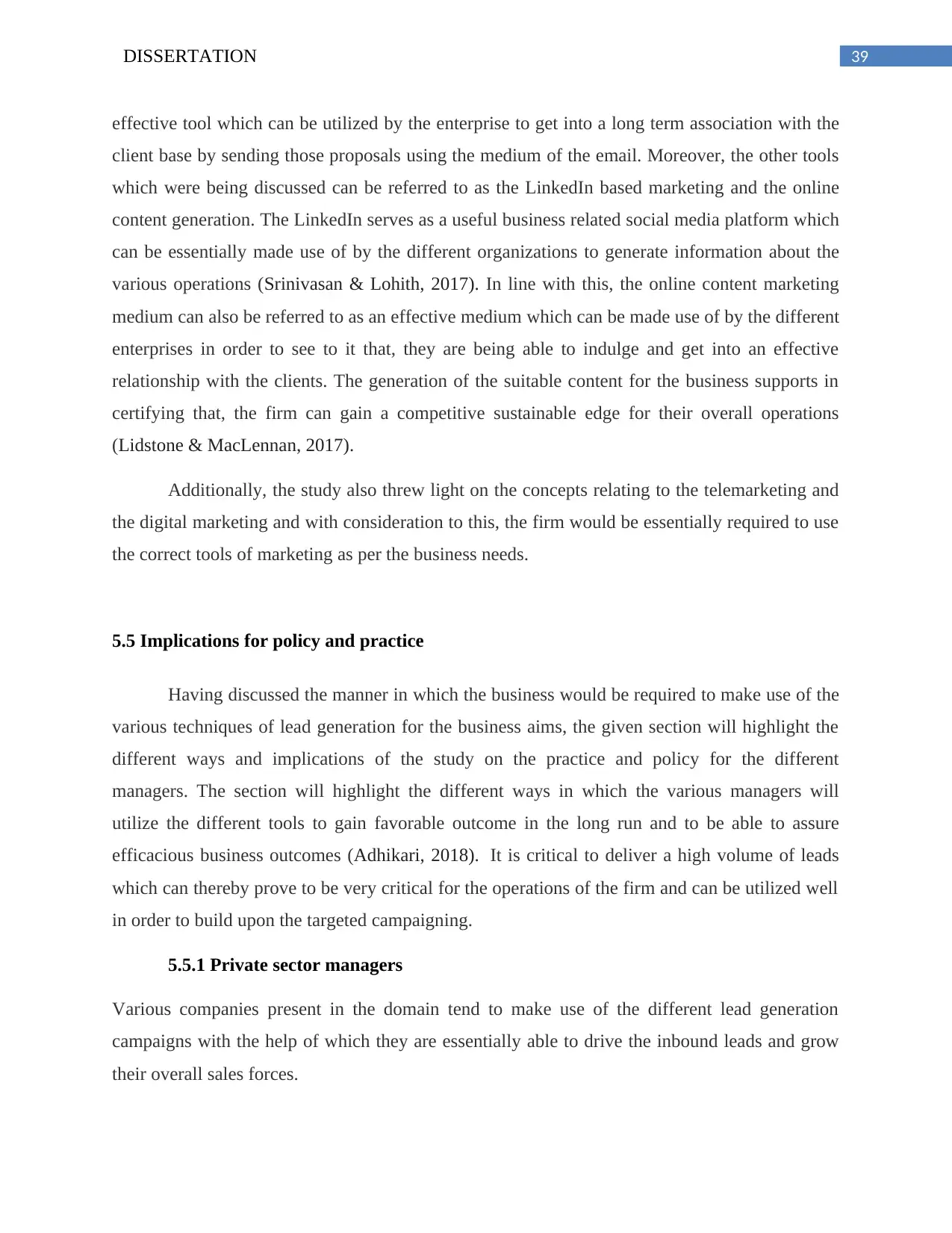
39DISSERTATION
effective tool which can be utilized by the enterprise to get into a long term association with the
client base by sending those proposals using the medium of the email. Moreover, the other tools
which were being discussed can be referred to as the LinkedIn based marketing and the online
content generation. The LinkedIn serves as a useful business related social media platform which
can be essentially made use of by the different organizations to generate information about the
various operations (Srinivasan & Lohith, 2017). In line with this, the online content marketing
medium can also be referred to as an effective medium which can be made use of by the different
enterprises in order to see to it that, they are being able to indulge and get into an effective
relationship with the clients. The generation of the suitable content for the business supports in
certifying that, the firm can gain a competitive sustainable edge for their overall operations
(Lidstone & MacLennan, 2017).
Additionally, the study also threw light on the concepts relating to the telemarketing and
the digital marketing and with consideration to this, the firm would be essentially required to use
the correct tools of marketing as per the business needs.
5.5 Implications for policy and practice
Having discussed the manner in which the business would be required to make use of the
various techniques of lead generation for the business aims, the given section will highlight the
different ways and implications of the study on the practice and policy for the different
managers. The section will highlight the different ways in which the various managers will
utilize the different tools to gain favorable outcome in the long run and to be able to assure
efficacious business outcomes (Adhikari, 2018). It is critical to deliver a high volume of leads
which can thereby prove to be very critical for the operations of the firm and can be utilized well
in order to build upon the targeted campaigning.
5.5.1 Private sector managers
Various companies present in the domain tend to make use of the different lead generation
campaigns with the help of which they are essentially able to drive the inbound leads and grow
their overall sales forces.
effective tool which can be utilized by the enterprise to get into a long term association with the
client base by sending those proposals using the medium of the email. Moreover, the other tools
which were being discussed can be referred to as the LinkedIn based marketing and the online
content generation. The LinkedIn serves as a useful business related social media platform which
can be essentially made use of by the different organizations to generate information about the
various operations (Srinivasan & Lohith, 2017). In line with this, the online content marketing
medium can also be referred to as an effective medium which can be made use of by the different
enterprises in order to see to it that, they are being able to indulge and get into an effective
relationship with the clients. The generation of the suitable content for the business supports in
certifying that, the firm can gain a competitive sustainable edge for their overall operations
(Lidstone & MacLennan, 2017).
Additionally, the study also threw light on the concepts relating to the telemarketing and
the digital marketing and with consideration to this, the firm would be essentially required to use
the correct tools of marketing as per the business needs.
5.5 Implications for policy and practice
Having discussed the manner in which the business would be required to make use of the
various techniques of lead generation for the business aims, the given section will highlight the
different ways and implications of the study on the practice and policy for the different
managers. The section will highlight the different ways in which the various managers will
utilize the different tools to gain favorable outcome in the long run and to be able to assure
efficacious business outcomes (Adhikari, 2018). It is critical to deliver a high volume of leads
which can thereby prove to be very critical for the operations of the firm and can be utilized well
in order to build upon the targeted campaigning.
5.5.1 Private sector managers
Various companies present in the domain tend to make use of the different lead generation
campaigns with the help of which they are essentially able to drive the inbound leads and grow
their overall sales forces.
Secure Best Marks with AI Grader
Need help grading? Try our AI Grader for instant feedback on your assignments.
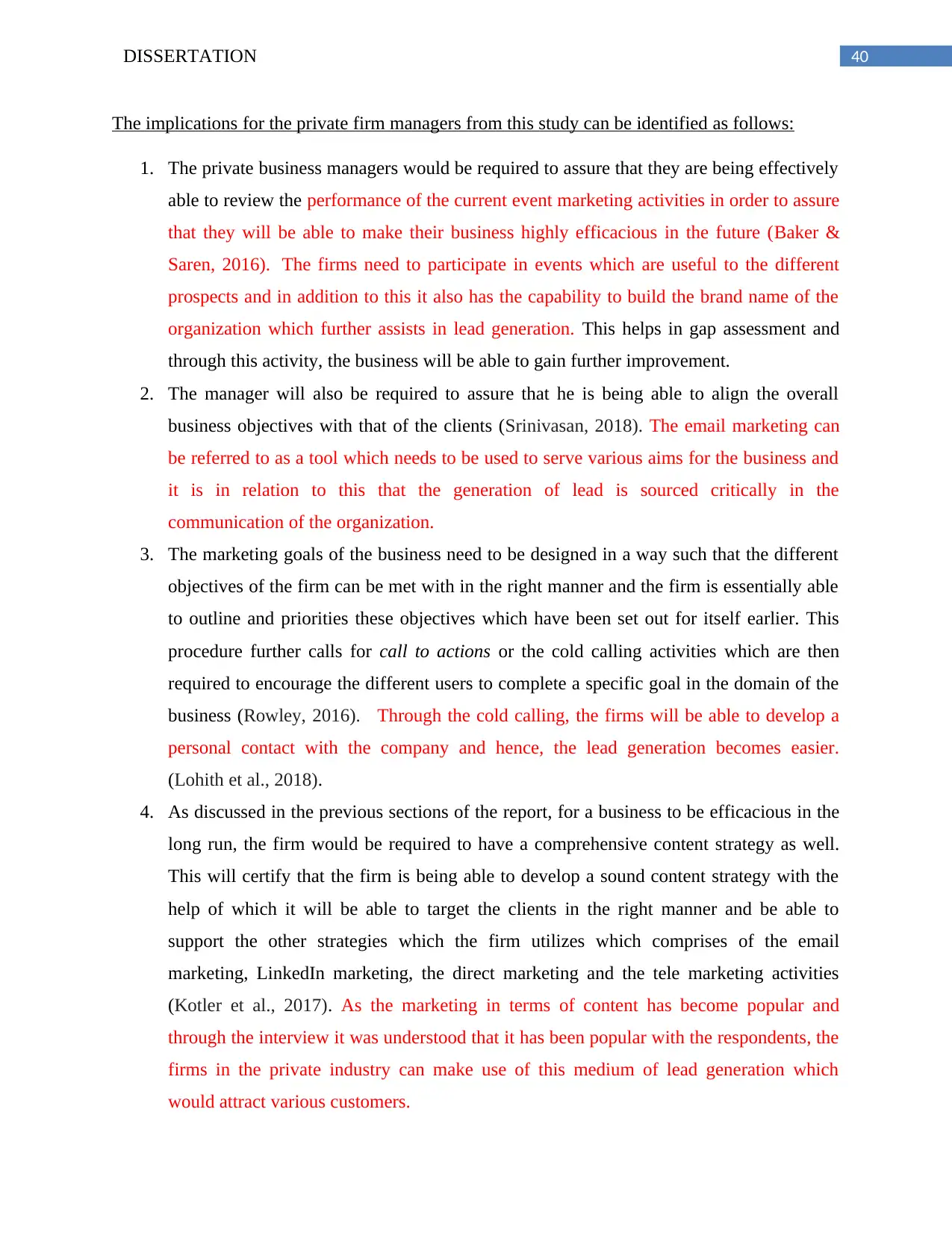
40DISSERTATION
The implications for the private firm managers from this study can be identified as follows:
1. The private business managers would be required to assure that they are being effectively
able to review the performance of the current event marketing activities in order to assure
that they will be able to make their business highly efficacious in the future (Baker &
Saren, 2016). The firms need to participate in events which are useful to the different
prospects and in addition to this it also has the capability to build the brand name of the
organization which further assists in lead generation. This helps in gap assessment and
through this activity, the business will be able to gain further improvement.
2. The manager will also be required to assure that he is being able to align the overall
business objectives with that of the clients (Srinivasan, 2018). The email marketing can
be referred to as a tool which needs to be used to serve various aims for the business and
it is in relation to this that the generation of lead is sourced critically in the
communication of the organization.
3. The marketing goals of the business need to be designed in a way such that the different
objectives of the firm can be met with in the right manner and the firm is essentially able
to outline and priorities these objectives which have been set out for itself earlier. This
procedure further calls for call to actions or the cold calling activities which are then
required to encourage the different users to complete a specific goal in the domain of the
business (Rowley, 2016). Through the cold calling, the firms will be able to develop a
personal contact with the company and hence, the lead generation becomes easier.
(Lohith et al., 2018).
4. As discussed in the previous sections of the report, for a business to be efficacious in the
long run, the firm would be required to have a comprehensive content strategy as well.
This will certify that the firm is being able to develop a sound content strategy with the
help of which it will be able to target the clients in the right manner and be able to
support the other strategies which the firm utilizes which comprises of the email
marketing, LinkedIn marketing, the direct marketing and the tele marketing activities
(Kotler et al., 2017). As the marketing in terms of content has become popular and
through the interview it was understood that it has been popular with the respondents, the
firms in the private industry can make use of this medium of lead generation which
would attract various customers.
The implications for the private firm managers from this study can be identified as follows:
1. The private business managers would be required to assure that they are being effectively
able to review the performance of the current event marketing activities in order to assure
that they will be able to make their business highly efficacious in the future (Baker &
Saren, 2016). The firms need to participate in events which are useful to the different
prospects and in addition to this it also has the capability to build the brand name of the
organization which further assists in lead generation. This helps in gap assessment and
through this activity, the business will be able to gain further improvement.
2. The manager will also be required to assure that he is being able to align the overall
business objectives with that of the clients (Srinivasan, 2018). The email marketing can
be referred to as a tool which needs to be used to serve various aims for the business and
it is in relation to this that the generation of lead is sourced critically in the
communication of the organization.
3. The marketing goals of the business need to be designed in a way such that the different
objectives of the firm can be met with in the right manner and the firm is essentially able
to outline and priorities these objectives which have been set out for itself earlier. This
procedure further calls for call to actions or the cold calling activities which are then
required to encourage the different users to complete a specific goal in the domain of the
business (Rowley, 2016). Through the cold calling, the firms will be able to develop a
personal contact with the company and hence, the lead generation becomes easier.
(Lohith et al., 2018).
4. As discussed in the previous sections of the report, for a business to be efficacious in the
long run, the firm would be required to have a comprehensive content strategy as well.
This will certify that the firm is being able to develop a sound content strategy with the
help of which it will be able to target the clients in the right manner and be able to
support the other strategies which the firm utilizes which comprises of the email
marketing, LinkedIn marketing, the direct marketing and the tele marketing activities
(Kotler et al., 2017). As the marketing in terms of content has become popular and
through the interview it was understood that it has been popular with the respondents, the
firms in the private industry can make use of this medium of lead generation which
would attract various customers.

41DISSERTATION
5. The email marketing automation can be essentially made use of by the organization in
order to certify that, they are being able to create a separate detailed customer profile
based on their overall behavior of the different customers present as well. With this use of
intelligence, each email message can be aligned by taking critical decision making and by
assuring that the Customer relationship management tools are applied to the operations of
the organization (Kerin & Hartley, 2015). This additional effort which the firm will
enforce on the levels of indulgent will also contribute towards certifying that it will be
efficaciously able to attain a larger audience.
6. Integrating with the social media. Along with the traditional means of marketing, the
social media can also be referred to as a tool which can be made use of the business in
order to promote its content and generate the right kind of leads for the business
(Lidstone & MacLennan, 2017). The social media has the capability to indulge the
different customers in a direct conversation and has a capability to see to it that the
business is sufficiently able to extent the boundaries which limit the lead generation of
the organization. In addition to this, the web design has to be well implemented in
relation to the social media activities of the firm.
5.5.2 Public sector policy analysts and managers
Having discussed the various techniques in which the private managers will be essentially
required to make use of various tools which are available to them for the aim of the analysis, this
section of the paper will essentially focus on the different tools which the various public sector
policy analysts and the managers will be required to make use of, in order to see to it that they
will be efficaciously able to indulge in various lead generation policies as well as the different
initiatives (Adhikari, 2018). Hence, the study highlighted the way in which the public sector
policy analysts will be essentially able to make use of the mediums of marketing and the
different indulgent tools which will thereby assist in certifying that the organization will be able
to gain overall favorable outcome and be able to improve the overall operations in the future.
1. For any public enterprise, engaging with the leads directly needs to be the overall
policy of the business enterprise. In association with this, it becomes critically
relevant for the firm to assure that they are in direct indulgent with the various
5. The email marketing automation can be essentially made use of by the organization in
order to certify that, they are being able to create a separate detailed customer profile
based on their overall behavior of the different customers present as well. With this use of
intelligence, each email message can be aligned by taking critical decision making and by
assuring that the Customer relationship management tools are applied to the operations of
the organization (Kerin & Hartley, 2015). This additional effort which the firm will
enforce on the levels of indulgent will also contribute towards certifying that it will be
efficaciously able to attain a larger audience.
6. Integrating with the social media. Along with the traditional means of marketing, the
social media can also be referred to as a tool which can be made use of the business in
order to promote its content and generate the right kind of leads for the business
(Lidstone & MacLennan, 2017). The social media has the capability to indulge the
different customers in a direct conversation and has a capability to see to it that the
business is sufficiently able to extent the boundaries which limit the lead generation of
the organization. In addition to this, the web design has to be well implemented in
relation to the social media activities of the firm.
5.5.2 Public sector policy analysts and managers
Having discussed the various techniques in which the private managers will be essentially
required to make use of various tools which are available to them for the aim of the analysis, this
section of the paper will essentially focus on the different tools which the various public sector
policy analysts and the managers will be required to make use of, in order to see to it that they
will be efficaciously able to indulge in various lead generation policies as well as the different
initiatives (Adhikari, 2018). Hence, the study highlighted the way in which the public sector
policy analysts will be essentially able to make use of the mediums of marketing and the
different indulgent tools which will thereby assist in certifying that the organization will be able
to gain overall favorable outcome and be able to improve the overall operations in the future.
1. For any public enterprise, engaging with the leads directly needs to be the overall
policy of the business enterprise. In association with this, it becomes critically
relevant for the firm to assure that they are in direct indulgent with the various
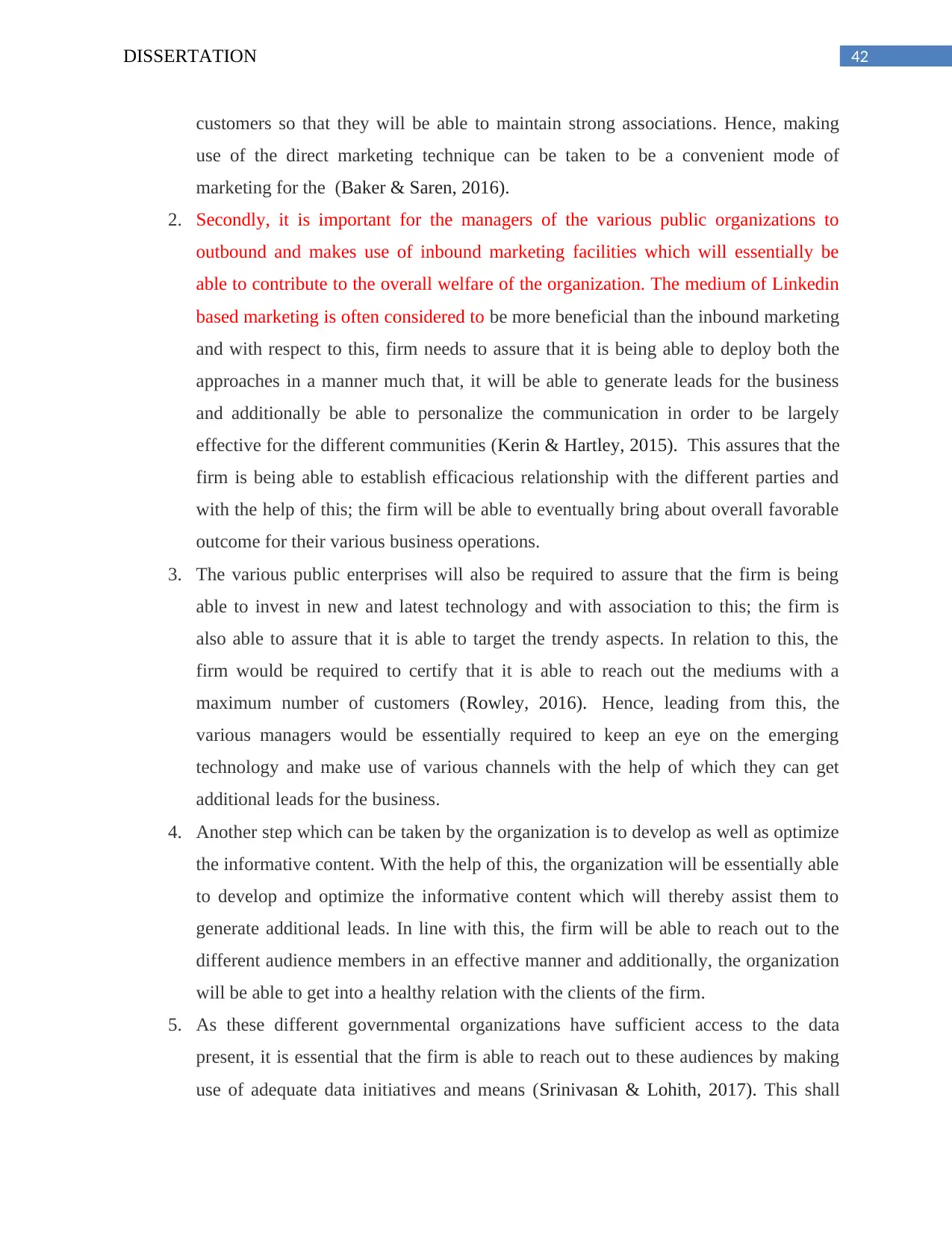
42DISSERTATION
customers so that they will be able to maintain strong associations. Hence, making
use of the direct marketing technique can be taken to be a convenient mode of
marketing for the (Baker & Saren, 2016).
2. Secondly, it is important for the managers of the various public organizations to
outbound and makes use of inbound marketing facilities which will essentially be
able to contribute to the overall welfare of the organization. The medium of Linkedin
based marketing is often considered to be more beneficial than the inbound marketing
and with respect to this, firm needs to assure that it is being able to deploy both the
approaches in a manner much that, it will be able to generate leads for the business
and additionally be able to personalize the communication in order to be largely
effective for the different communities (Kerin & Hartley, 2015). This assures that the
firm is being able to establish efficacious relationship with the different parties and
with the help of this; the firm will be able to eventually bring about overall favorable
outcome for their various business operations.
3. The various public enterprises will also be required to assure that the firm is being
able to invest in new and latest technology and with association to this; the firm is
also able to assure that it is able to target the trendy aspects. In relation to this, the
firm would be required to certify that it is able to reach out the mediums with a
maximum number of customers (Rowley, 2016). Hence, leading from this, the
various managers would be essentially required to keep an eye on the emerging
technology and make use of various channels with the help of which they can get
additional leads for the business.
4. Another step which can be taken by the organization is to develop as well as optimize
the informative content. With the help of this, the organization will be essentially able
to develop and optimize the informative content which will thereby assist them to
generate additional leads. In line with this, the firm will be able to reach out to the
different audience members in an effective manner and additionally, the organization
will be able to get into a healthy relation with the clients of the firm.
5. As these different governmental organizations have sufficient access to the data
present, it is essential that the firm is able to reach out to these audiences by making
use of adequate data initiatives and means (Srinivasan & Lohith, 2017). This shall
customers so that they will be able to maintain strong associations. Hence, making
use of the direct marketing technique can be taken to be a convenient mode of
marketing for the (Baker & Saren, 2016).
2. Secondly, it is important for the managers of the various public organizations to
outbound and makes use of inbound marketing facilities which will essentially be
able to contribute to the overall welfare of the organization. The medium of Linkedin
based marketing is often considered to be more beneficial than the inbound marketing
and with respect to this, firm needs to assure that it is being able to deploy both the
approaches in a manner much that, it will be able to generate leads for the business
and additionally be able to personalize the communication in order to be largely
effective for the different communities (Kerin & Hartley, 2015). This assures that the
firm is being able to establish efficacious relationship with the different parties and
with the help of this; the firm will be able to eventually bring about overall favorable
outcome for their various business operations.
3. The various public enterprises will also be required to assure that the firm is being
able to invest in new and latest technology and with association to this; the firm is
also able to assure that it is able to target the trendy aspects. In relation to this, the
firm would be required to certify that it is able to reach out the mediums with a
maximum number of customers (Rowley, 2016). Hence, leading from this, the
various managers would be essentially required to keep an eye on the emerging
technology and make use of various channels with the help of which they can get
additional leads for the business.
4. Another step which can be taken by the organization is to develop as well as optimize
the informative content. With the help of this, the organization will be essentially able
to develop and optimize the informative content which will thereby assist them to
generate additional leads. In line with this, the firm will be able to reach out to the
different audience members in an effective manner and additionally, the organization
will be able to get into a healthy relation with the clients of the firm.
5. As these different governmental organizations have sufficient access to the data
present, it is essential that the firm is able to reach out to these audiences by making
use of adequate data initiatives and means (Srinivasan & Lohith, 2017). This shall
Paraphrase This Document
Need a fresh take? Get an instant paraphrase of this document with our AI Paraphraser
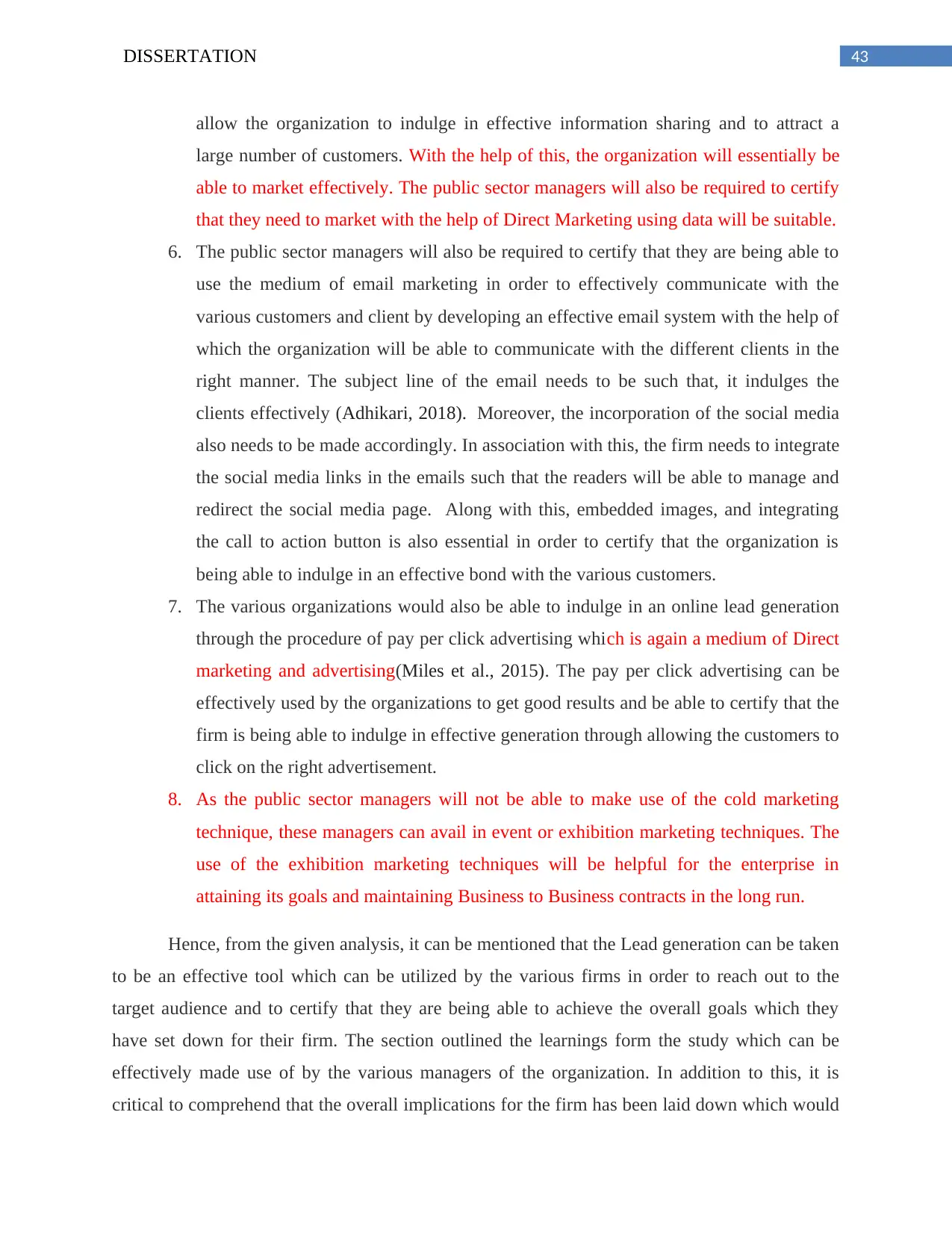
43DISSERTATION
allow the organization to indulge in effective information sharing and to attract a
large number of customers. With the help of this, the organization will essentially be
able to market effectively. The public sector managers will also be required to certify
that they need to market with the help of Direct Marketing using data will be suitable.
6. The public sector managers will also be required to certify that they are being able to
use the medium of email marketing in order to effectively communicate with the
various customers and client by developing an effective email system with the help of
which the organization will be able to communicate with the different clients in the
right manner. The subject line of the email needs to be such that, it indulges the
clients effectively (Adhikari, 2018). Moreover, the incorporation of the social media
also needs to be made accordingly. In association with this, the firm needs to integrate
the social media links in the emails such that the readers will be able to manage and
redirect the social media page. Along with this, embedded images, and integrating
the call to action button is also essential in order to certify that the organization is
being able to indulge in an effective bond with the various customers.
7. The various organizations would also be able to indulge in an online lead generation
through the procedure of pay per click advertising which is again a medium of Direct
marketing and advertising(Miles et al., 2015). The pay per click advertising can be
effectively used by the organizations to get good results and be able to certify that the
firm is being able to indulge in effective generation through allowing the customers to
click on the right advertisement.
8. As the public sector managers will not be able to make use of the cold marketing
technique, these managers can avail in event or exhibition marketing techniques. The
use of the exhibition marketing techniques will be helpful for the enterprise in
attaining its goals and maintaining Business to Business contracts in the long run.
Hence, from the given analysis, it can be mentioned that the Lead generation can be taken
to be an effective tool which can be utilized by the various firms in order to reach out to the
target audience and to certify that they are being able to achieve the overall goals which they
have set down for their firm. The section outlined the learnings form the study which can be
effectively made use of by the various managers of the organization. In addition to this, it is
critical to comprehend that the overall implications for the firm has been laid down which would
allow the organization to indulge in effective information sharing and to attract a
large number of customers. With the help of this, the organization will essentially be
able to market effectively. The public sector managers will also be required to certify
that they need to market with the help of Direct Marketing using data will be suitable.
6. The public sector managers will also be required to certify that they are being able to
use the medium of email marketing in order to effectively communicate with the
various customers and client by developing an effective email system with the help of
which the organization will be able to communicate with the different clients in the
right manner. The subject line of the email needs to be such that, it indulges the
clients effectively (Adhikari, 2018). Moreover, the incorporation of the social media
also needs to be made accordingly. In association with this, the firm needs to integrate
the social media links in the emails such that the readers will be able to manage and
redirect the social media page. Along with this, embedded images, and integrating
the call to action button is also essential in order to certify that the organization is
being able to indulge in an effective bond with the various customers.
7. The various organizations would also be able to indulge in an online lead generation
through the procedure of pay per click advertising which is again a medium of Direct
marketing and advertising(Miles et al., 2015). The pay per click advertising can be
effectively used by the organizations to get good results and be able to certify that the
firm is being able to indulge in effective generation through allowing the customers to
click on the right advertisement.
8. As the public sector managers will not be able to make use of the cold marketing
technique, these managers can avail in event or exhibition marketing techniques. The
use of the exhibition marketing techniques will be helpful for the enterprise in
attaining its goals and maintaining Business to Business contracts in the long run.
Hence, from the given analysis, it can be mentioned that the Lead generation can be taken
to be an effective tool which can be utilized by the various firms in order to reach out to the
target audience and to certify that they are being able to achieve the overall goals which they
have set down for their firm. The section outlined the learnings form the study which can be
effectively made use of by the various managers of the organization. In addition to this, it is
critical to comprehend that the overall implications for the firm has been laid down which would
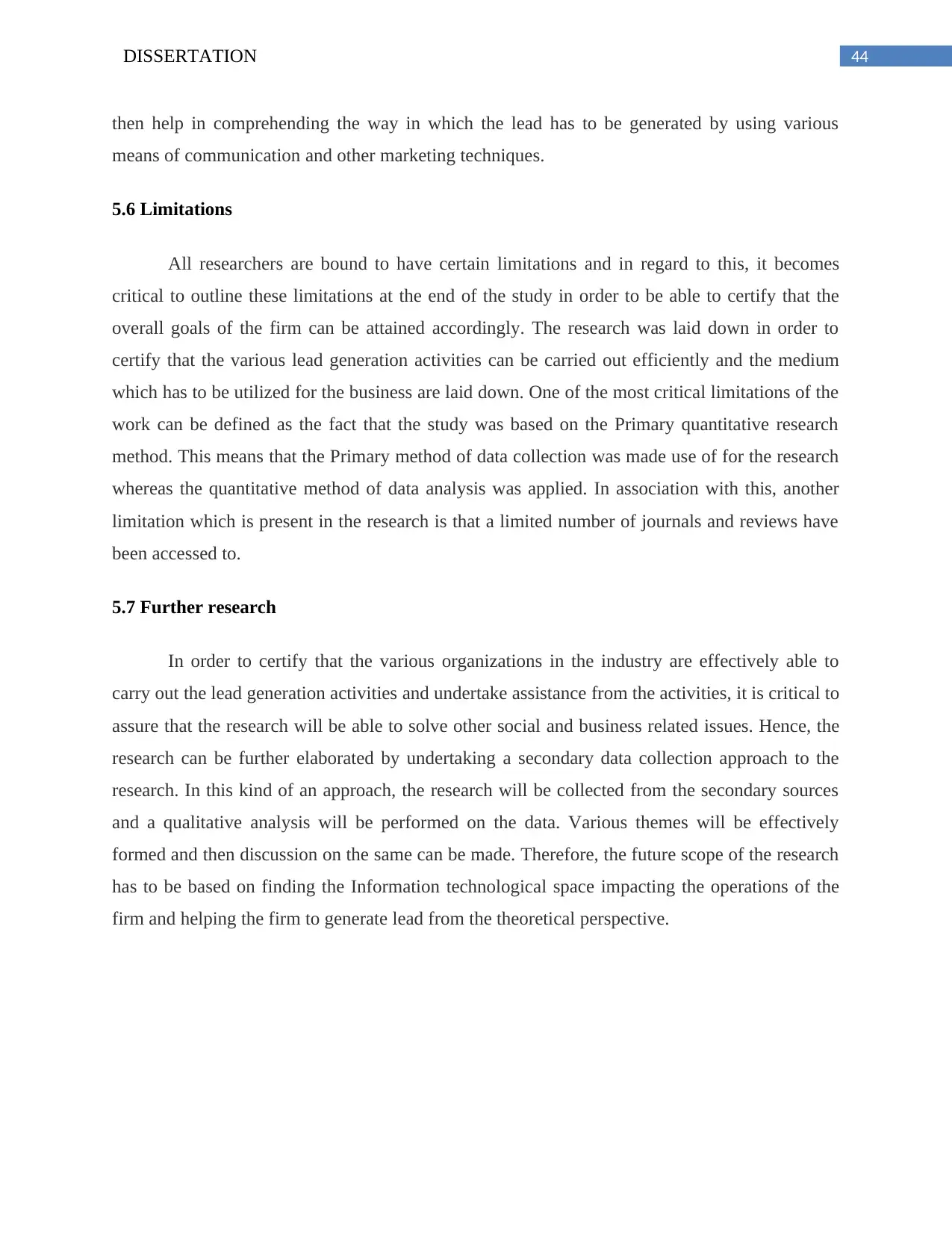
44DISSERTATION
then help in comprehending the way in which the lead has to be generated by using various
means of communication and other marketing techniques.
5.6 Limitations
All researchers are bound to have certain limitations and in regard to this, it becomes
critical to outline these limitations at the end of the study in order to be able to certify that the
overall goals of the firm can be attained accordingly. The research was laid down in order to
certify that the various lead generation activities can be carried out efficiently and the medium
which has to be utilized for the business are laid down. One of the most critical limitations of the
work can be defined as the fact that the study was based on the Primary quantitative research
method. This means that the Primary method of data collection was made use of for the research
whereas the quantitative method of data analysis was applied. In association with this, another
limitation which is present in the research is that a limited number of journals and reviews have
been accessed to.
5.7 Further research
In order to certify that the various organizations in the industry are effectively able to
carry out the lead generation activities and undertake assistance from the activities, it is critical to
assure that the research will be able to solve other social and business related issues. Hence, the
research can be further elaborated by undertaking a secondary data collection approach to the
research. In this kind of an approach, the research will be collected from the secondary sources
and a qualitative analysis will be performed on the data. Various themes will be effectively
formed and then discussion on the same can be made. Therefore, the future scope of the research
has to be based on finding the Information technological space impacting the operations of the
firm and helping the firm to generate lead from the theoretical perspective.
then help in comprehending the way in which the lead has to be generated by using various
means of communication and other marketing techniques.
5.6 Limitations
All researchers are bound to have certain limitations and in regard to this, it becomes
critical to outline these limitations at the end of the study in order to be able to certify that the
overall goals of the firm can be attained accordingly. The research was laid down in order to
certify that the various lead generation activities can be carried out efficiently and the medium
which has to be utilized for the business are laid down. One of the most critical limitations of the
work can be defined as the fact that the study was based on the Primary quantitative research
method. This means that the Primary method of data collection was made use of for the research
whereas the quantitative method of data analysis was applied. In association with this, another
limitation which is present in the research is that a limited number of journals and reviews have
been accessed to.
5.7 Further research
In order to certify that the various organizations in the industry are effectively able to
carry out the lead generation activities and undertake assistance from the activities, it is critical to
assure that the research will be able to solve other social and business related issues. Hence, the
research can be further elaborated by undertaking a secondary data collection approach to the
research. In this kind of an approach, the research will be collected from the secondary sources
and a qualitative analysis will be performed on the data. Various themes will be effectively
formed and then discussion on the same can be made. Therefore, the future scope of the research
has to be based on finding the Information technological space impacting the operations of the
firm and helping the firm to generate lead from the theoretical perspective.
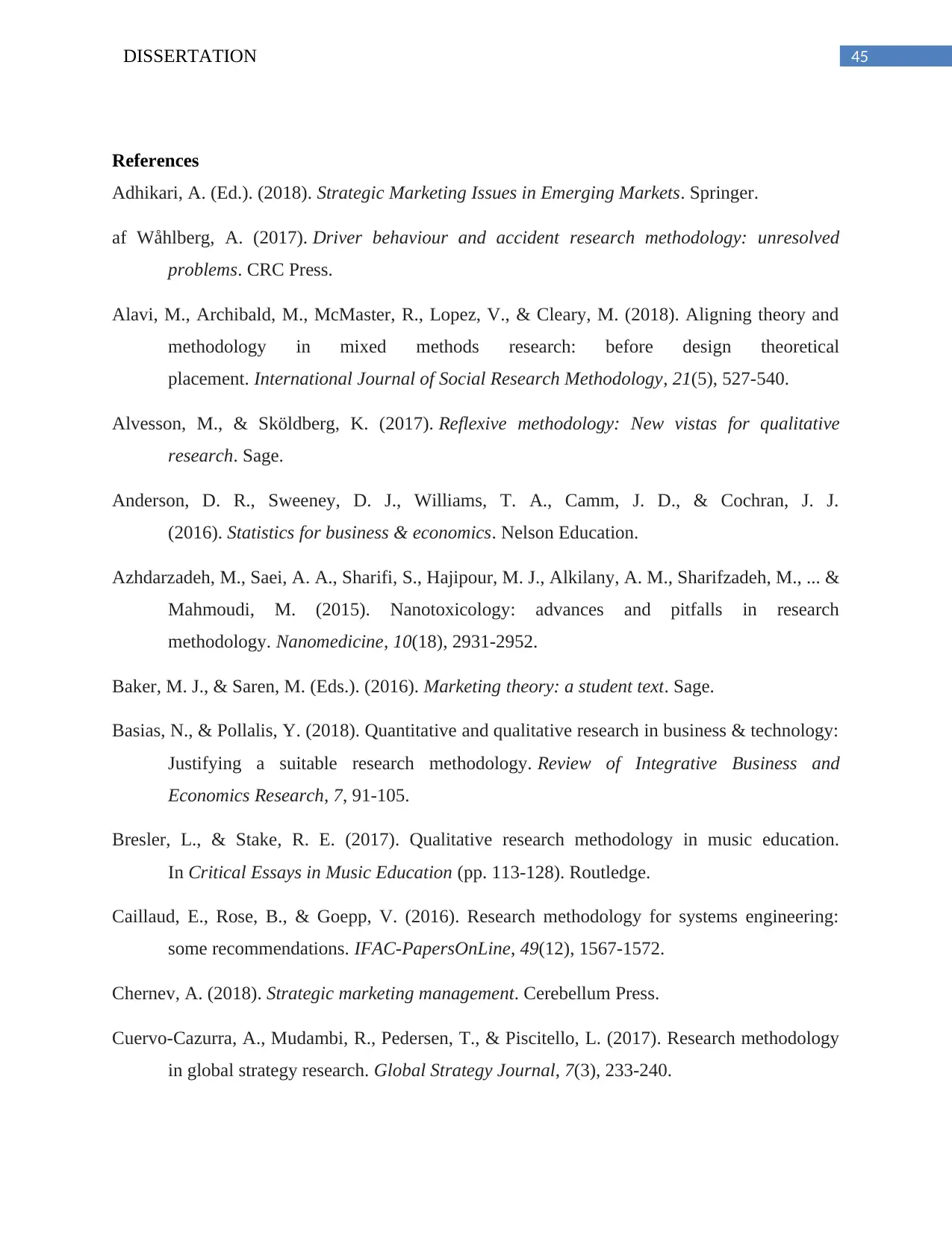
45DISSERTATION
References
Adhikari, A. (Ed.). (2018). Strategic Marketing Issues in Emerging Markets. Springer.
af Wåhlberg, A. (2017). Driver behaviour and accident research methodology: unresolved
problems. CRC Press.
Alavi, M., Archibald, M., McMaster, R., Lopez, V., & Cleary, M. (2018). Aligning theory and
methodology in mixed methods research: before design theoretical
placement. International Journal of Social Research Methodology, 21(5), 527-540.
Alvesson, M., & Sköldberg, K. (2017). Reflexive methodology: New vistas for qualitative
research. Sage.
Anderson, D. R., Sweeney, D. J., Williams, T. A., Camm, J. D., & Cochran, J. J.
(2016). Statistics for business & economics. Nelson Education.
Azhdarzadeh, M., Saei, A. A., Sharifi, S., Hajipour, M. J., Alkilany, A. M., Sharifzadeh, M., ... &
Mahmoudi, M. (2015). Nanotoxicology: advances and pitfalls in research
methodology. Nanomedicine, 10(18), 2931-2952.
Baker, M. J., & Saren, M. (Eds.). (2016). Marketing theory: a student text. Sage.
Basias, N., & Pollalis, Y. (2018). Quantitative and qualitative research in business & technology:
Justifying a suitable research methodology. Review of Integrative Business and
Economics Research, 7, 91-105.
Bresler, L., & Stake, R. E. (2017). Qualitative research methodology in music education.
In Critical Essays in Music Education (pp. 113-128). Routledge.
Caillaud, E., Rose, B., & Goepp, V. (2016). Research methodology for systems engineering:
some recommendations. IFAC-PapersOnLine, 49(12), 1567-1572.
Chernev, A. (2018). Strategic marketing management. Cerebellum Press.
Cuervo‐Cazurra, A., Mudambi, R., Pedersen, T., & Piscitello, L. (2017). Research methodology
in global strategy research. Global Strategy Journal, 7(3), 233-240.
References
Adhikari, A. (Ed.). (2018). Strategic Marketing Issues in Emerging Markets. Springer.
af Wåhlberg, A. (2017). Driver behaviour and accident research methodology: unresolved
problems. CRC Press.
Alavi, M., Archibald, M., McMaster, R., Lopez, V., & Cleary, M. (2018). Aligning theory and
methodology in mixed methods research: before design theoretical
placement. International Journal of Social Research Methodology, 21(5), 527-540.
Alvesson, M., & Sköldberg, K. (2017). Reflexive methodology: New vistas for qualitative
research. Sage.
Anderson, D. R., Sweeney, D. J., Williams, T. A., Camm, J. D., & Cochran, J. J.
(2016). Statistics for business & economics. Nelson Education.
Azhdarzadeh, M., Saei, A. A., Sharifi, S., Hajipour, M. J., Alkilany, A. M., Sharifzadeh, M., ... &
Mahmoudi, M. (2015). Nanotoxicology: advances and pitfalls in research
methodology. Nanomedicine, 10(18), 2931-2952.
Baker, M. J., & Saren, M. (Eds.). (2016). Marketing theory: a student text. Sage.
Basias, N., & Pollalis, Y. (2018). Quantitative and qualitative research in business & technology:
Justifying a suitable research methodology. Review of Integrative Business and
Economics Research, 7, 91-105.
Bresler, L., & Stake, R. E. (2017). Qualitative research methodology in music education.
In Critical Essays in Music Education (pp. 113-128). Routledge.
Caillaud, E., Rose, B., & Goepp, V. (2016). Research methodology for systems engineering:
some recommendations. IFAC-PapersOnLine, 49(12), 1567-1572.
Chernev, A. (2018). Strategic marketing management. Cerebellum Press.
Cuervo‐Cazurra, A., Mudambi, R., Pedersen, T., & Piscitello, L. (2017). Research methodology
in global strategy research. Global Strategy Journal, 7(3), 233-240.
Secure Best Marks with AI Grader
Need help grading? Try our AI Grader for instant feedback on your assignments.
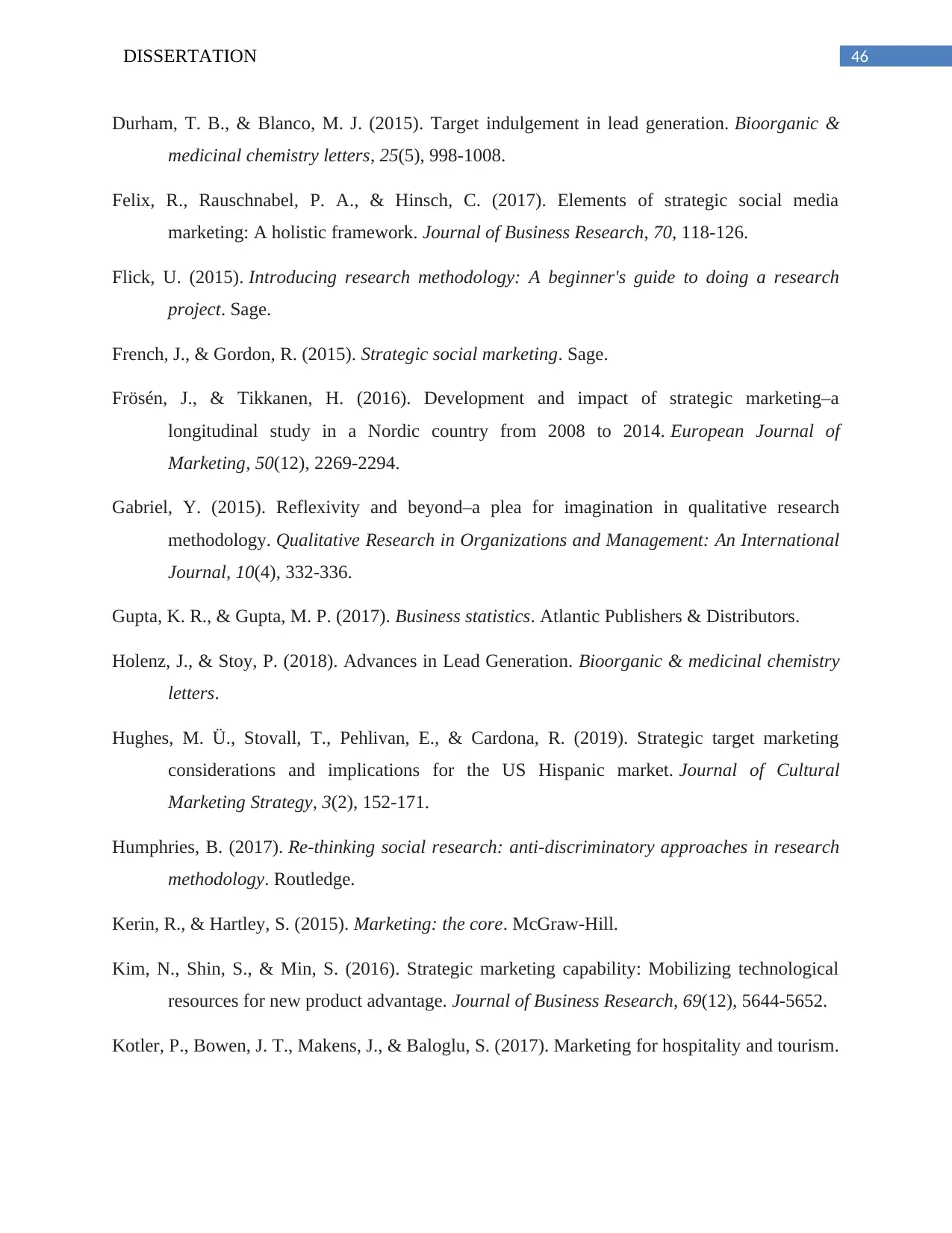
46DISSERTATION
Durham, T. B., & Blanco, M. J. (2015). Target indulgement in lead generation. Bioorganic &
medicinal chemistry letters, 25(5), 998-1008.
Felix, R., Rauschnabel, P. A., & Hinsch, C. (2017). Elements of strategic social media
marketing: A holistic framework. Journal of Business Research, 70, 118-126.
Flick, U. (2015). Introducing research methodology: A beginner's guide to doing a research
project. Sage.
French, J., & Gordon, R. (2015). Strategic social marketing. Sage.
Frösén, J., & Tikkanen, H. (2016). Development and impact of strategic marketing–a
longitudinal study in a Nordic country from 2008 to 2014. European Journal of
Marketing, 50(12), 2269-2294.
Gabriel, Y. (2015). Reflexivity and beyond–a plea for imagination in qualitative research
methodology. Qualitative Research in Organizations and Management: An International
Journal, 10(4), 332-336.
Gupta, K. R., & Gupta, M. P. (2017). Business statistics. Atlantic Publishers & Distributors.
Holenz, J., & Stoy, P. (2018). Advances in Lead Generation. Bioorganic & medicinal chemistry
letters.
Hughes, M. Ü., Stovall, T., Pehlivan, E., & Cardona, R. (2019). Strategic target marketing
considerations and implications for the US Hispanic market. Journal of Cultural
Marketing Strategy, 3(2), 152-171.
Humphries, B. (2017). Re-thinking social research: anti-discriminatory approaches in research
methodology. Routledge.
Kerin, R., & Hartley, S. (2015). Marketing: the core. McGraw-Hill.
Kim, N., Shin, S., & Min, S. (2016). Strategic marketing capability: Mobilizing technological
resources for new product advantage. Journal of Business Research, 69(12), 5644-5652.
Kotler, P., Bowen, J. T., Makens, J., & Baloglu, S. (2017). Marketing for hospitality and tourism.
Durham, T. B., & Blanco, M. J. (2015). Target indulgement in lead generation. Bioorganic &
medicinal chemistry letters, 25(5), 998-1008.
Felix, R., Rauschnabel, P. A., & Hinsch, C. (2017). Elements of strategic social media
marketing: A holistic framework. Journal of Business Research, 70, 118-126.
Flick, U. (2015). Introducing research methodology: A beginner's guide to doing a research
project. Sage.
French, J., & Gordon, R. (2015). Strategic social marketing. Sage.
Frösén, J., & Tikkanen, H. (2016). Development and impact of strategic marketing–a
longitudinal study in a Nordic country from 2008 to 2014. European Journal of
Marketing, 50(12), 2269-2294.
Gabriel, Y. (2015). Reflexivity and beyond–a plea for imagination in qualitative research
methodology. Qualitative Research in Organizations and Management: An International
Journal, 10(4), 332-336.
Gupta, K. R., & Gupta, M. P. (2017). Business statistics. Atlantic Publishers & Distributors.
Holenz, J., & Stoy, P. (2018). Advances in Lead Generation. Bioorganic & medicinal chemistry
letters.
Hughes, M. Ü., Stovall, T., Pehlivan, E., & Cardona, R. (2019). Strategic target marketing
considerations and implications for the US Hispanic market. Journal of Cultural
Marketing Strategy, 3(2), 152-171.
Humphries, B. (2017). Re-thinking social research: anti-discriminatory approaches in research
methodology. Routledge.
Kerin, R., & Hartley, S. (2015). Marketing: the core. McGraw-Hill.
Kim, N., Shin, S., & Min, S. (2016). Strategic marketing capability: Mobilizing technological
resources for new product advantage. Journal of Business Research, 69(12), 5644-5652.
Kotler, P., Bowen, J. T., Makens, J., & Baloglu, S. (2017). Marketing for hospitality and tourism.
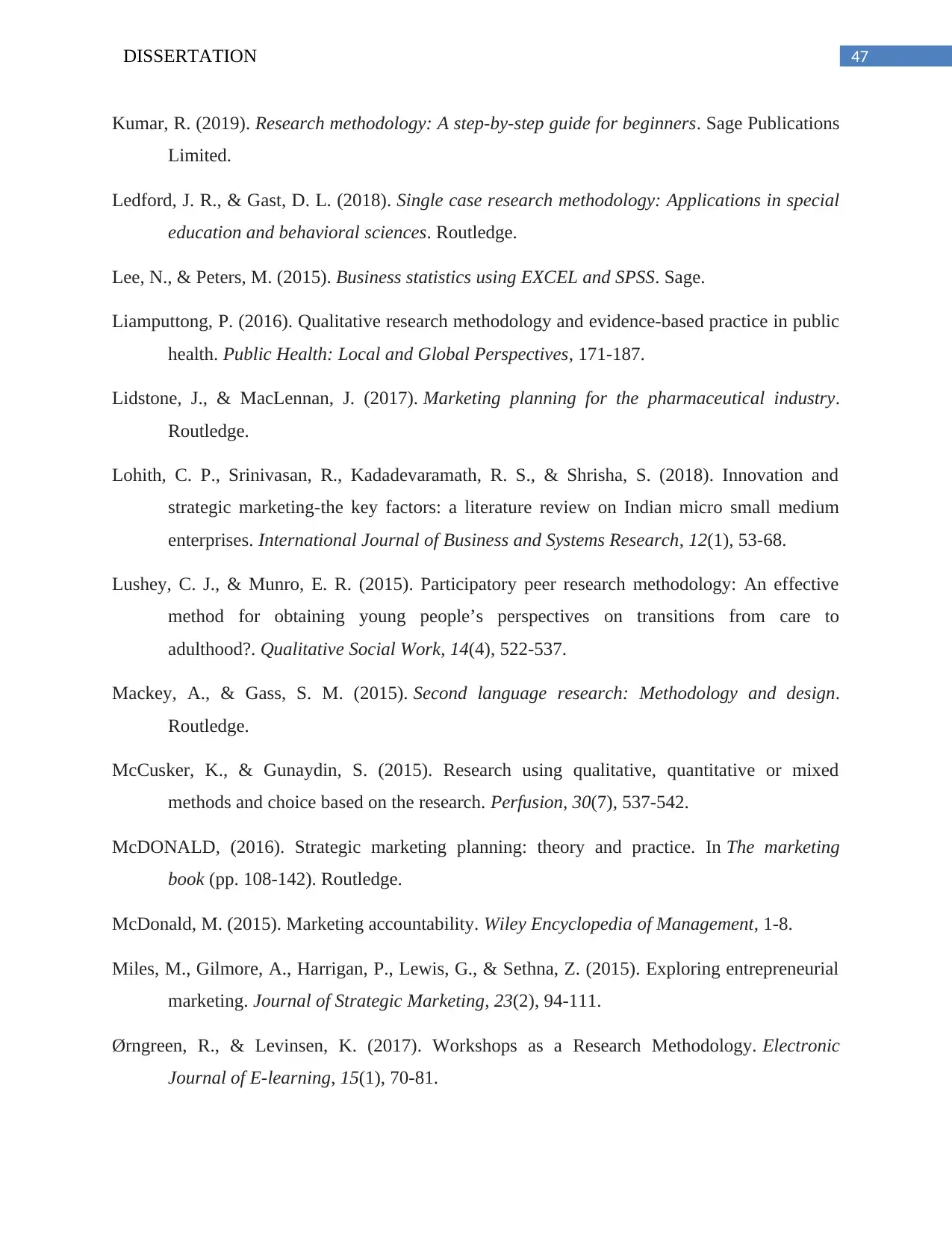
47DISSERTATION
Kumar, R. (2019). Research methodology: A step-by-step guide for beginners. Sage Publications
Limited.
Ledford, J. R., & Gast, D. L. (2018). Single case research methodology: Applications in special
education and behavioral sciences. Routledge.
Lee, N., & Peters, M. (2015). Business statistics using EXCEL and SPSS. Sage.
Liamputtong, P. (2016). Qualitative research methodology and evidence-based practice in public
health. Public Health: Local and Global Perspectives, 171-187.
Lidstone, J., & MacLennan, J. (2017). Marketing planning for the pharmaceutical industry.
Routledge.
Lohith, C. P., Srinivasan, R., Kadadevaramath, R. S., & Shrisha, S. (2018). Innovation and
strategic marketing-the key factors: a literature review on Indian micro small medium
enterprises. International Journal of Business and Systems Research, 12(1), 53-68.
Lushey, C. J., & Munro, E. R. (2015). Participatory peer research methodology: An effective
method for obtaining young people’s perspectives on transitions from care to
adulthood?. Qualitative Social Work, 14(4), 522-537.
Mackey, A., & Gass, S. M. (2015). Second language research: Methodology and design.
Routledge.
McCusker, K., & Gunaydin, S. (2015). Research using qualitative, quantitative or mixed
methods and choice based on the research. Perfusion, 30(7), 537-542.
McDONALD, (2016). Strategic marketing planning: theory and practice. In The marketing
book (pp. 108-142). Routledge.
McDonald, M. (2015). Marketing accountability. Wiley Encyclopedia of Management, 1-8.
Miles, M., Gilmore, A., Harrigan, P., Lewis, G., & Sethna, Z. (2015). Exploring entrepreneurial
marketing. Journal of Strategic Marketing, 23(2), 94-111.
Ørngreen, R., & Levinsen, K. (2017). Workshops as a Research Methodology. Electronic
Journal of E-learning, 15(1), 70-81.
Kumar, R. (2019). Research methodology: A step-by-step guide for beginners. Sage Publications
Limited.
Ledford, J. R., & Gast, D. L. (2018). Single case research methodology: Applications in special
education and behavioral sciences. Routledge.
Lee, N., & Peters, M. (2015). Business statistics using EXCEL and SPSS. Sage.
Liamputtong, P. (2016). Qualitative research methodology and evidence-based practice in public
health. Public Health: Local and Global Perspectives, 171-187.
Lidstone, J., & MacLennan, J. (2017). Marketing planning for the pharmaceutical industry.
Routledge.
Lohith, C. P., Srinivasan, R., Kadadevaramath, R. S., & Shrisha, S. (2018). Innovation and
strategic marketing-the key factors: a literature review on Indian micro small medium
enterprises. International Journal of Business and Systems Research, 12(1), 53-68.
Lushey, C. J., & Munro, E. R. (2015). Participatory peer research methodology: An effective
method for obtaining young people’s perspectives on transitions from care to
adulthood?. Qualitative Social Work, 14(4), 522-537.
Mackey, A., & Gass, S. M. (2015). Second language research: Methodology and design.
Routledge.
McCusker, K., & Gunaydin, S. (2015). Research using qualitative, quantitative or mixed
methods and choice based on the research. Perfusion, 30(7), 537-542.
McDONALD, (2016). Strategic marketing planning: theory and practice. In The marketing
book (pp. 108-142). Routledge.
McDonald, M. (2015). Marketing accountability. Wiley Encyclopedia of Management, 1-8.
Miles, M., Gilmore, A., Harrigan, P., Lewis, G., & Sethna, Z. (2015). Exploring entrepreneurial
marketing. Journal of Strategic Marketing, 23(2), 94-111.
Ørngreen, R., & Levinsen, K. (2017). Workshops as a Research Methodology. Electronic
Journal of E-learning, 15(1), 70-81.

48DISSERTATION
Pruzan, P. (2016). Research methodology: the aims, practices and ethics of science. Springer.
Quinlan, C., Babin, B., Carr, J., & Griffin, M. (2019). Business research methods. South Western
Cindulge.
Ramirez, R., Mukherjee, M., Vezzoli, S., & Kramer, A. M. (2015). Scenarios as a scholarly
methodology to produce “interesting research”. Futures, 71, 70-87.
Rhodes, C. (2015). Business statistics. Briefing paper, 6152.
Rowley, J. (2016). Information marketing. Routledge.
Siegel, A. (2016). Practical business statistics. Academic Press.
Silverman, D. (Ed.). (2016). Qualitative research. Sage.
Srinivasan, R. (2018). The impact of strategic marketing on the performance of micro small &
medium enterprises-An Indian scenario. The Business & Management Review, 9(4), 404-
410.
Srinivasan, R., & Lohith, C. P. (2017). MSMEs-Strategic Marketing. In Strategic Marketing and
Innovation for Indian MSMEs (pp. 19-23). Springer, Singapore.
Sutrisna, M., & Setiawan, W. (2016). 14 The application of grounded theory methodology in
built environment research. Research methodology in the built environment: A selection
of case studies, 231.
Taherdoost, H. (2016). Sampling methods in research methodology; How to choose a sampling
technique for research.
Taylor, S. J., Bogdan, R., & DeVault, M. (2015). Introduction to qualitative research methods: A
guidebook and resource. John Wiley & Sons.
Walliman, N. (2017). Research methods: The basics. Routledge.
West, D. C., Ford, J., & Ibrahim, E. (2015). Strategic marketing: creating competitive
advantage. Oxford University Press, USA.
Wiek, A., & Lang, D. J. (2016). Transformational sustainability research methodology.
In Sustainability science (pp. 31-41). Springer, Dordrecht.
Pruzan, P. (2016). Research methodology: the aims, practices and ethics of science. Springer.
Quinlan, C., Babin, B., Carr, J., & Griffin, M. (2019). Business research methods. South Western
Cindulge.
Ramirez, R., Mukherjee, M., Vezzoli, S., & Kramer, A. M. (2015). Scenarios as a scholarly
methodology to produce “interesting research”. Futures, 71, 70-87.
Rhodes, C. (2015). Business statistics. Briefing paper, 6152.
Rowley, J. (2016). Information marketing. Routledge.
Siegel, A. (2016). Practical business statistics. Academic Press.
Silverman, D. (Ed.). (2016). Qualitative research. Sage.
Srinivasan, R. (2018). The impact of strategic marketing on the performance of micro small &
medium enterprises-An Indian scenario. The Business & Management Review, 9(4), 404-
410.
Srinivasan, R., & Lohith, C. P. (2017). MSMEs-Strategic Marketing. In Strategic Marketing and
Innovation for Indian MSMEs (pp. 19-23). Springer, Singapore.
Sutrisna, M., & Setiawan, W. (2016). 14 The application of grounded theory methodology in
built environment research. Research methodology in the built environment: A selection
of case studies, 231.
Taherdoost, H. (2016). Sampling methods in research methodology; How to choose a sampling
technique for research.
Taylor, S. J., Bogdan, R., & DeVault, M. (2015). Introduction to qualitative research methods: A
guidebook and resource. John Wiley & Sons.
Walliman, N. (2017). Research methods: The basics. Routledge.
West, D. C., Ford, J., & Ibrahim, E. (2015). Strategic marketing: creating competitive
advantage. Oxford University Press, USA.
Wiek, A., & Lang, D. J. (2016). Transformational sustainability research methodology.
In Sustainability science (pp. 31-41). Springer, Dordrecht.
Paraphrase This Document
Need a fresh take? Get an instant paraphrase of this document with our AI Paraphraser

49DISSERTATION
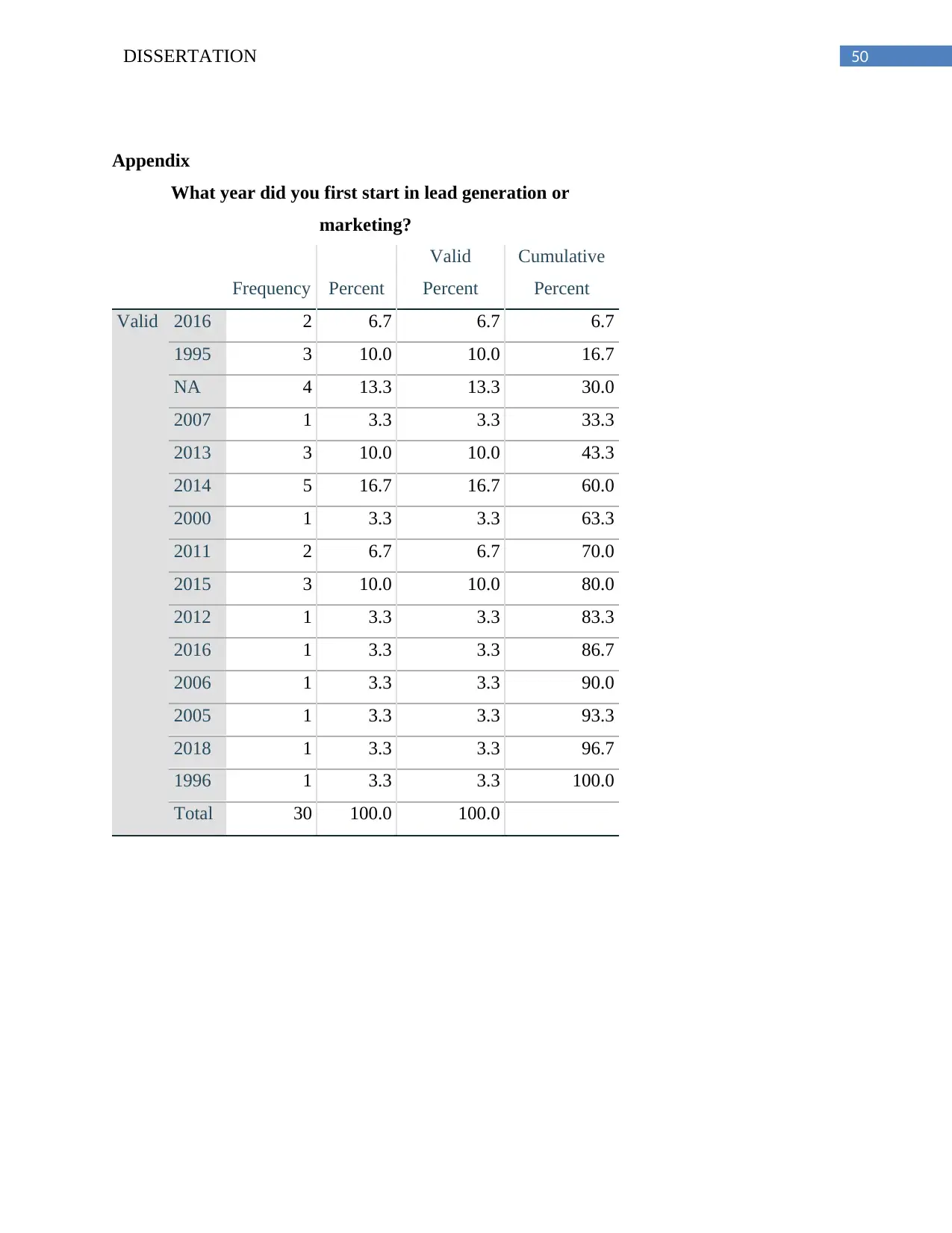
50DISSERTATION
Appendix
What year did you first start in lead generation or
marketing?
Frequency Percent
Valid
Percent
Cumulative
Percent
Valid 2016 2 6.7 6.7 6.7
1995 3 10.0 10.0 16.7
NA 4 13.3 13.3 30.0
2007 1 3.3 3.3 33.3
2013 3 10.0 10.0 43.3
2014 5 16.7 16.7 60.0
2000 1 3.3 3.3 63.3
2011 2 6.7 6.7 70.0
2015 3 10.0 10.0 80.0
2012 1 3.3 3.3 83.3
2016 1 3.3 3.3 86.7
2006 1 3.3 3.3 90.0
2005 1 3.3 3.3 93.3
2018 1 3.3 3.3 96.7
1996 1 3.3 3.3 100.0
Total 30 100.0 100.0
Appendix
What year did you first start in lead generation or
marketing?
Frequency Percent
Valid
Percent
Cumulative
Percent
Valid 2016 2 6.7 6.7 6.7
1995 3 10.0 10.0 16.7
NA 4 13.3 13.3 30.0
2007 1 3.3 3.3 33.3
2013 3 10.0 10.0 43.3
2014 5 16.7 16.7 60.0
2000 1 3.3 3.3 63.3
2011 2 6.7 6.7 70.0
2015 3 10.0 10.0 80.0
2012 1 3.3 3.3 83.3
2016 1 3.3 3.3 86.7
2006 1 3.3 3.3 90.0
2005 1 3.3 3.3 93.3
2018 1 3.3 3.3 96.7
1996 1 3.3 3.3 100.0
Total 30 100.0 100.0
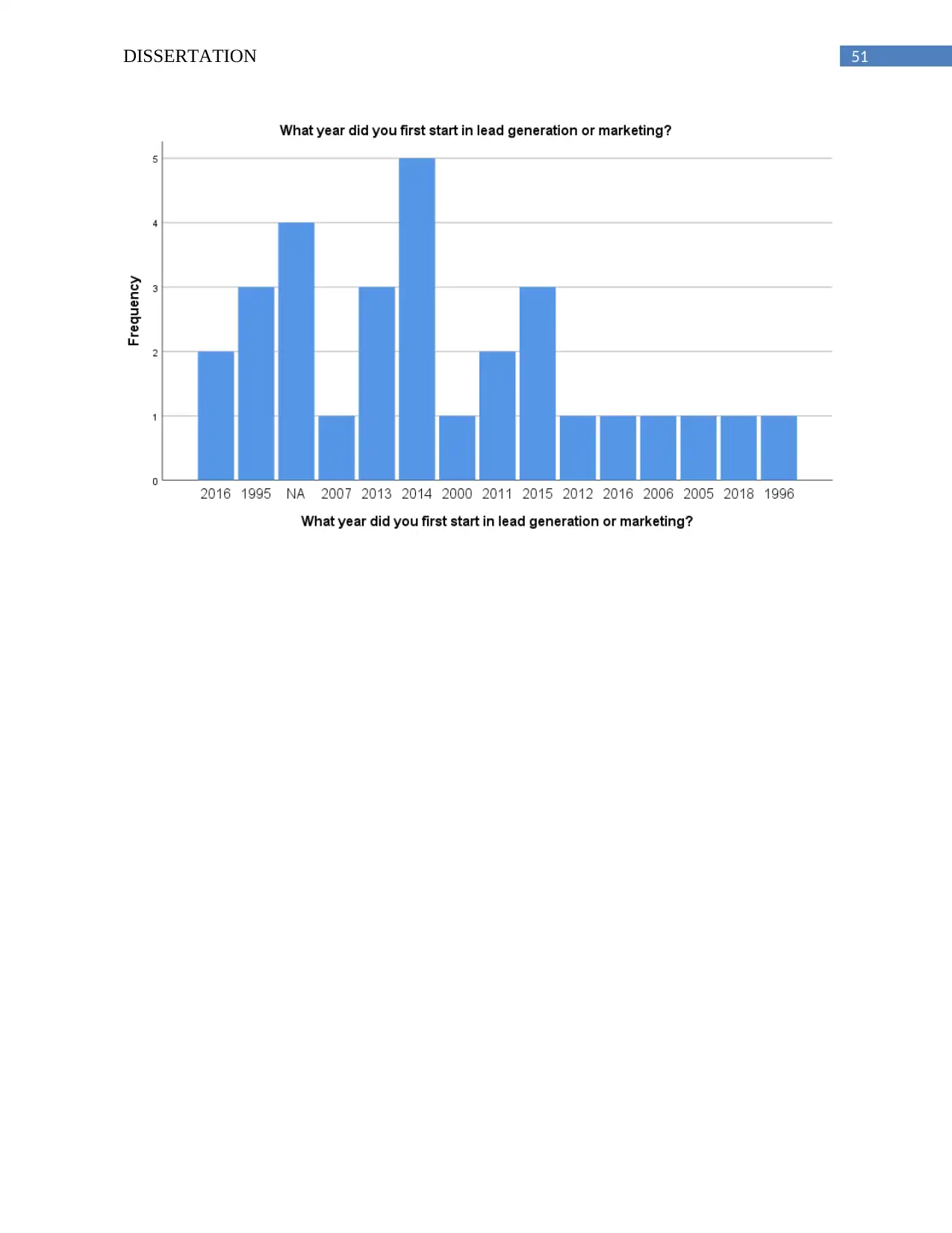
51DISSERTATION
1 out of 52
Related Documents
Your All-in-One AI-Powered Toolkit for Academic Success.
+13062052269
info@desklib.com
Available 24*7 on WhatsApp / Email
![[object Object]](/_next/static/media/star-bottom.7253800d.svg)
Unlock your academic potential
© 2024 | Zucol Services PVT LTD | All rights reserved.





